Quick filters:
4th century Stock Photos and Images
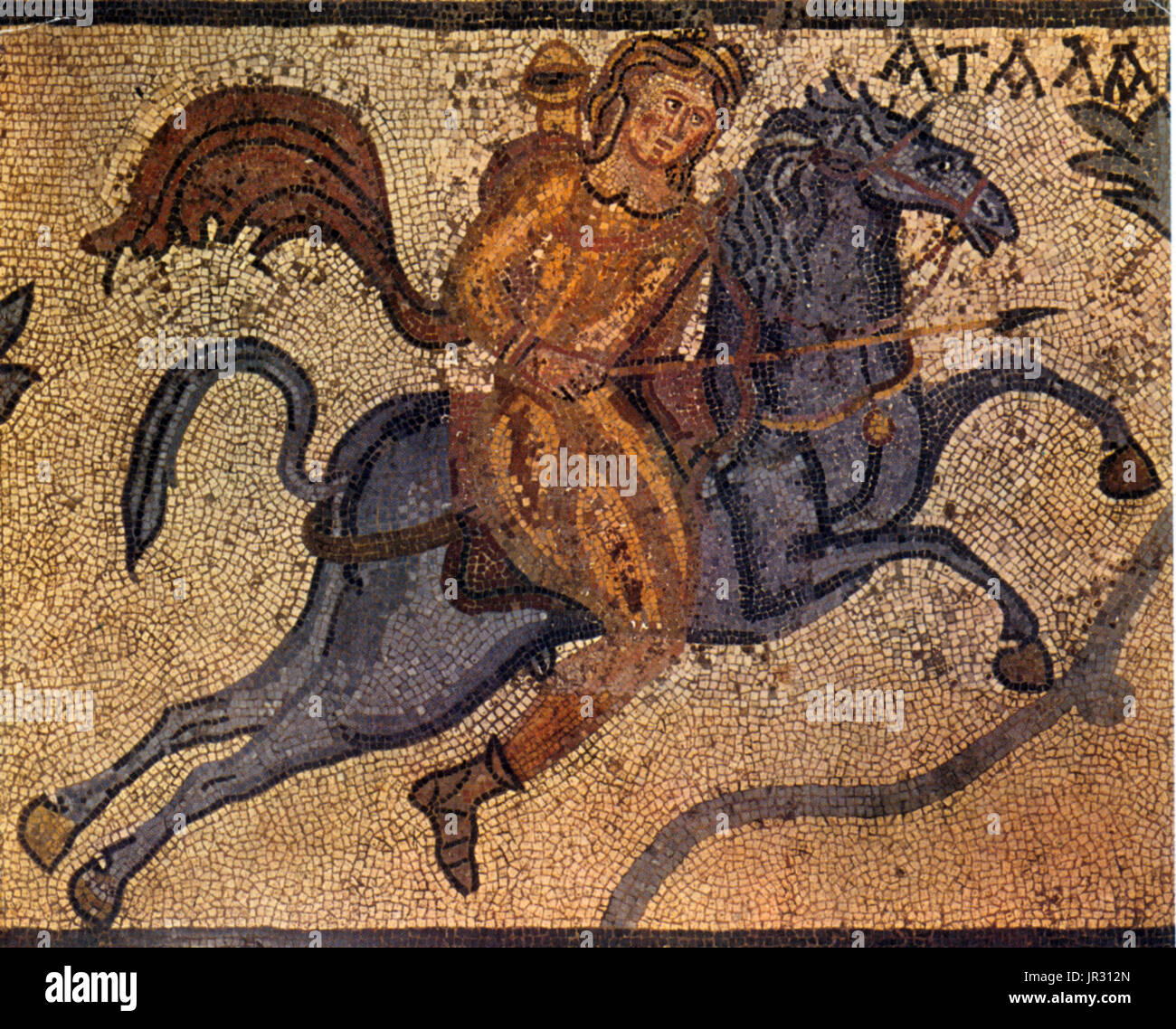 Atalanta Mosaic,4th Century Stock Photohttps://www.alamy.com/image-license-details/?v=1https://www.alamy.com/atalanta-mosaic4th-century-image151886749.html
Atalanta Mosaic,4th Century Stock Photohttps://www.alamy.com/image-license-details/?v=1https://www.alamy.com/atalanta-mosaic4th-century-image151886749.htmlRMJR312N–Atalanta Mosaic,4th Century
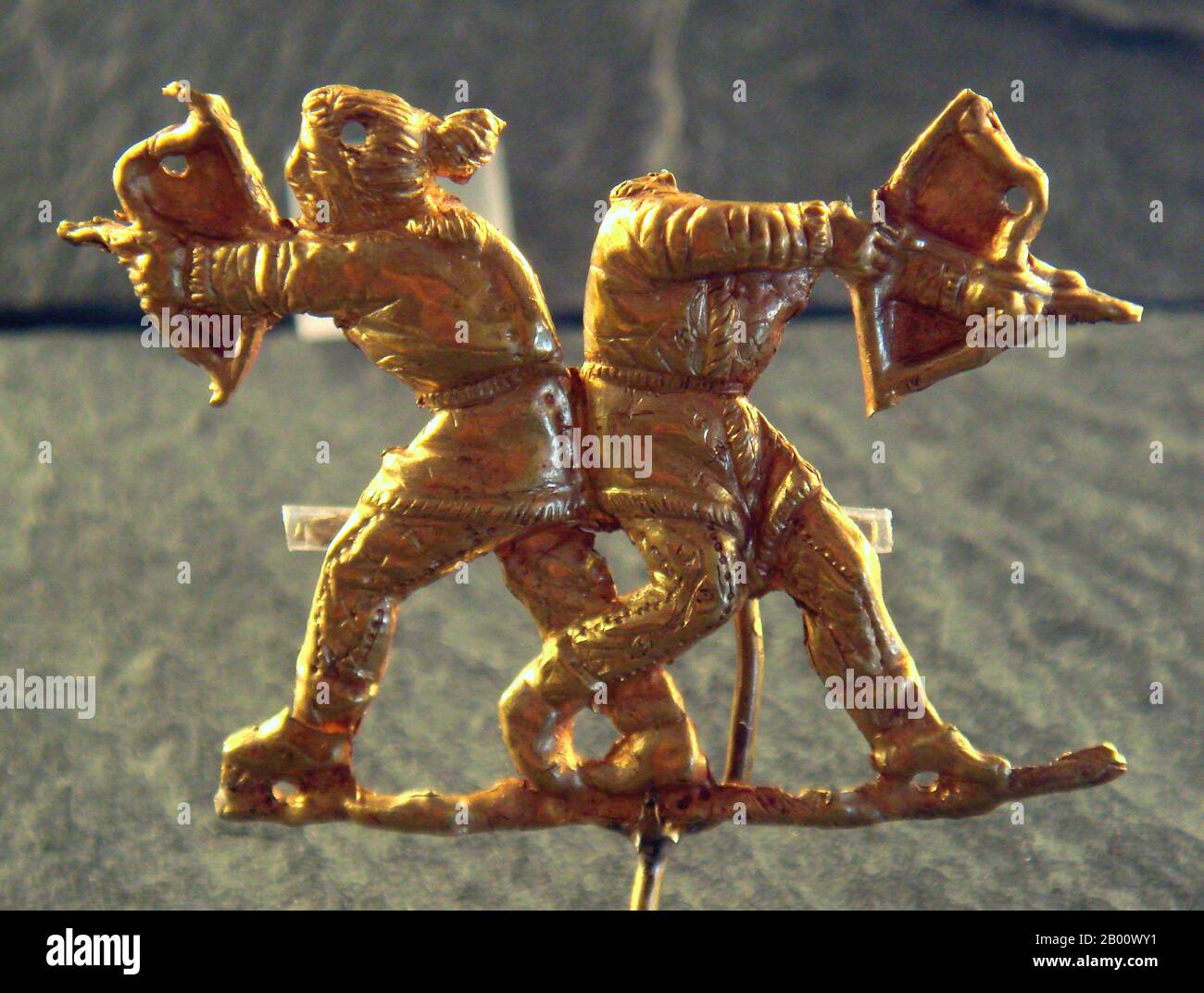 Ukraine: Scythian archers, gold ornament Golden artefacts from the Scythian Treasure of Kul-Oba, near Kerch, 4th century BCE. Photo by PHGCOM (CC BY-SA 3.0 License). The Scythians were an ancient Iranian people of horse-riding nomadic pastoralists who throughout Classical Antiquity dominated the Pontic-Caspian steppe, known at the time as Scythia. By Late Antiquity the closely-related Sarmatians came to dominate the Scythians in the west. Stock Photohttps://www.alamy.com/image-license-details/?v=1https://www.alamy.com/ukraine-scythian-archers-gold-ornament-golden-artefacts-from-the-scythian-treasure-of-kul-oba-near-kerch-4th-century-bce-photo-by-phgcom-cc-by-sa-30-license-the-scythians-were-an-ancient-iranian-people-of-horse-riding-nomadic-pastoralists-who-throughout-classical-antiquity-dominated-the-pontic-caspian-steppe-known-at-the-time-as-scythia-by-late-antiquity-the-closely-related-sarmatians-came-to-dominate-the-scythians-in-the-west-image344227717.html
Ukraine: Scythian archers, gold ornament Golden artefacts from the Scythian Treasure of Kul-Oba, near Kerch, 4th century BCE. Photo by PHGCOM (CC BY-SA 3.0 License). The Scythians were an ancient Iranian people of horse-riding nomadic pastoralists who throughout Classical Antiquity dominated the Pontic-Caspian steppe, known at the time as Scythia. By Late Antiquity the closely-related Sarmatians came to dominate the Scythians in the west. Stock Photohttps://www.alamy.com/image-license-details/?v=1https://www.alamy.com/ukraine-scythian-archers-gold-ornament-golden-artefacts-from-the-scythian-treasure-of-kul-oba-near-kerch-4th-century-bce-photo-by-phgcom-cc-by-sa-30-license-the-scythians-were-an-ancient-iranian-people-of-horse-riding-nomadic-pastoralists-who-throughout-classical-antiquity-dominated-the-pontic-caspian-steppe-known-at-the-time-as-scythia-by-late-antiquity-the-closely-related-sarmatians-came-to-dominate-the-scythians-in-the-west-image344227717.htmlRM2B00WY1–Ukraine: Scythian archers, gold ornament Golden artefacts from the Scythian Treasure of Kul-Oba, near Kerch, 4th century BCE. Photo by PHGCOM (CC BY-SA 3.0 License). The Scythians were an ancient Iranian people of horse-riding nomadic pastoralists who throughout Classical Antiquity dominated the Pontic-Caspian steppe, known at the time as Scythia. By Late Antiquity the closely-related Sarmatians came to dominate the Scythians in the west.
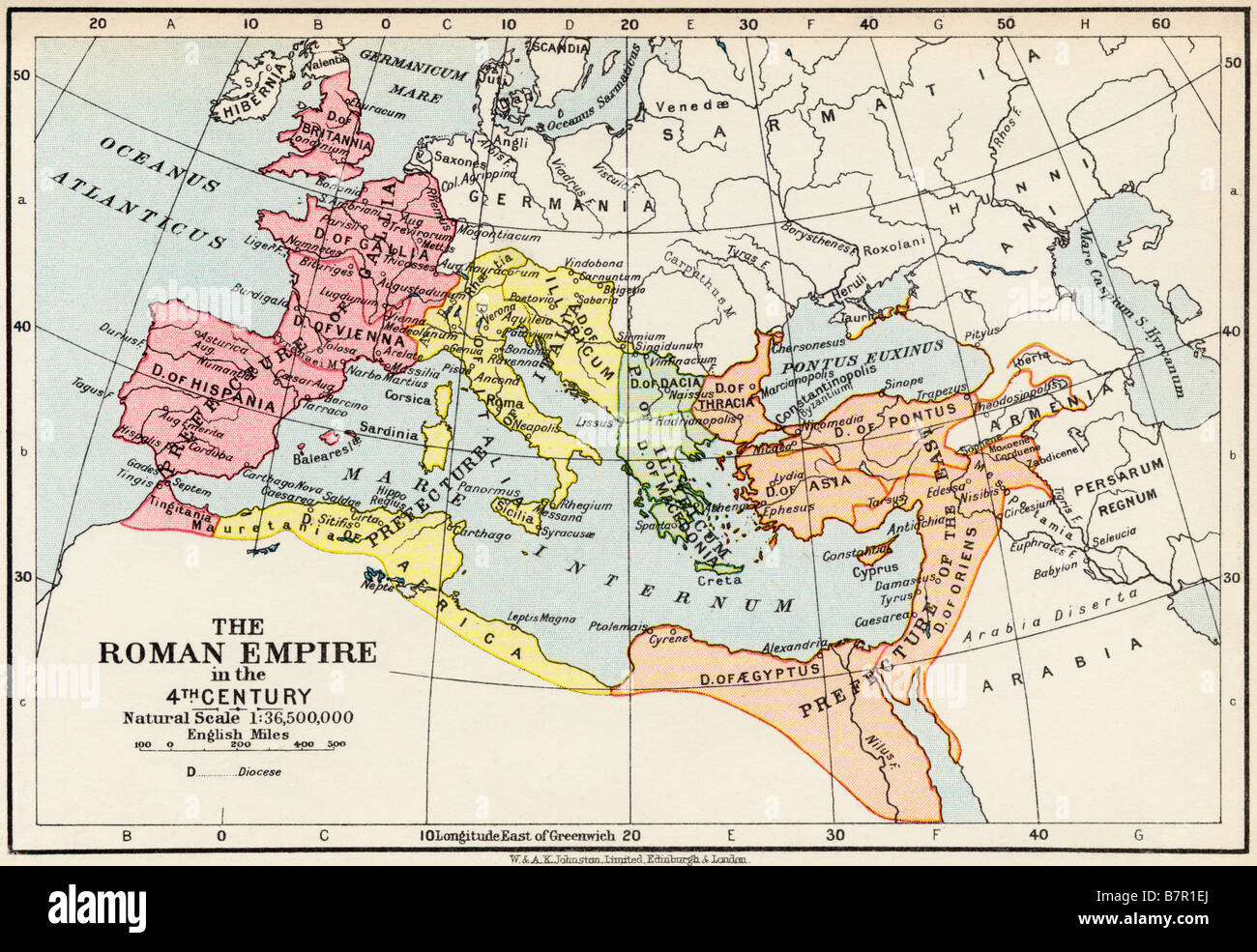 Map of the Roman Empire in the 4th Century Stock Photohttps://www.alamy.com/image-license-details/?v=1https://www.alamy.com/stock-photo-map-of-the-roman-empire-in-the-4th-century-22019050.html
Map of the Roman Empire in the 4th Century Stock Photohttps://www.alamy.com/image-license-details/?v=1https://www.alamy.com/stock-photo-map-of-the-roman-empire-in-the-4th-century-22019050.htmlRMB7R1EJ–Map of the Roman Empire in the 4th Century
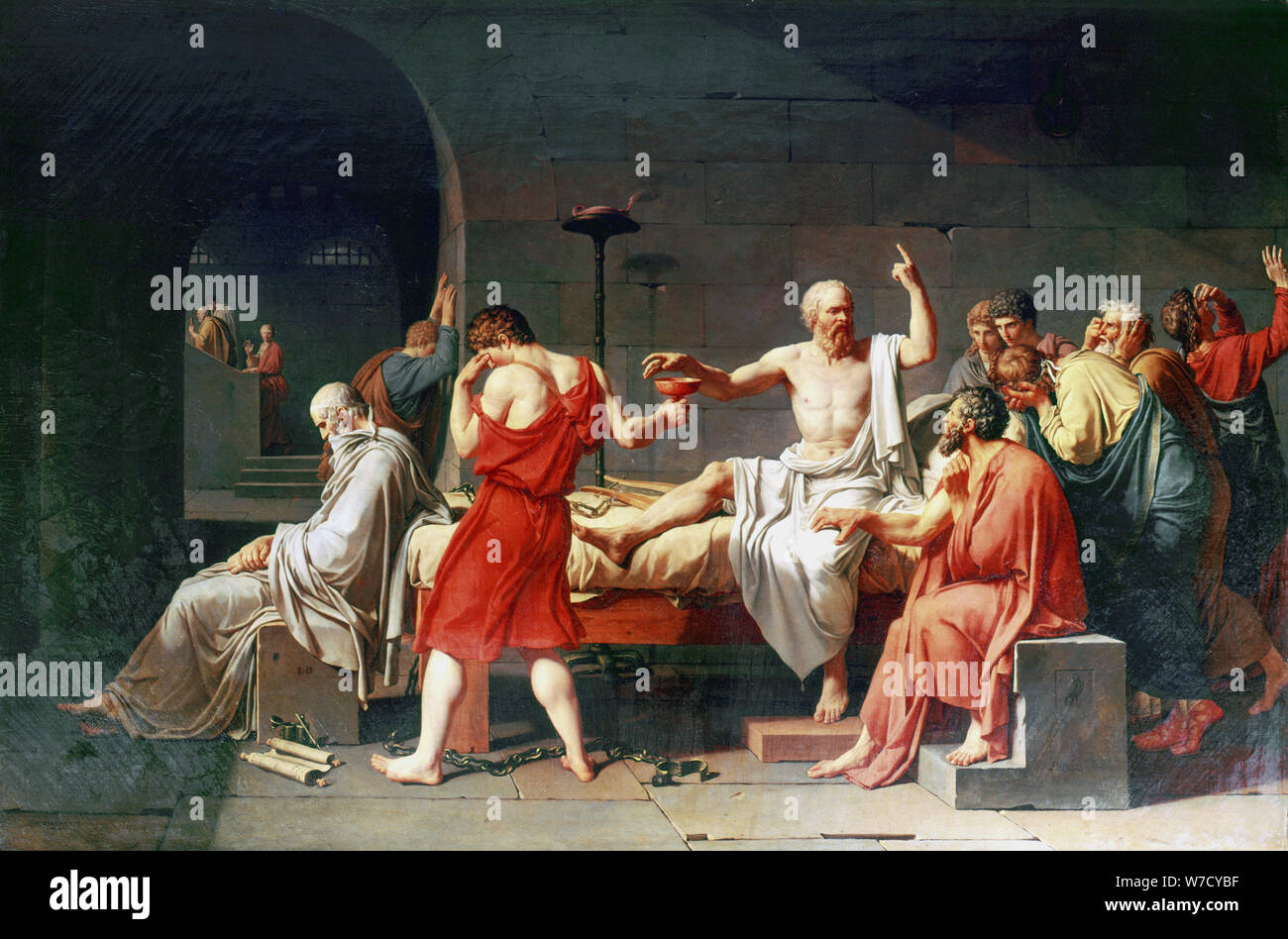 'The Death of Socrates', 4th century BC, (1787). Artist: Jacques-Louis David Stock Photohttps://www.alamy.com/image-license-details/?v=1https://www.alamy.com/the-death-of-socrates-4th-century-bc-1787-artist-jacques-louis-david-image262743027.html
'The Death of Socrates', 4th century BC, (1787). Artist: Jacques-Louis David Stock Photohttps://www.alamy.com/image-license-details/?v=1https://www.alamy.com/the-death-of-socrates-4th-century-bc-1787-artist-jacques-louis-david-image262743027.htmlRMW7CYBF–'The Death of Socrates', 4th century BC, (1787). Artist: Jacques-Louis David
 Chares of Athens. 4th century BC. Athenian general. Engraving depicting The dissipated habits of Chares. Stock Photohttps://www.alamy.com/image-license-details/?v=1https://www.alamy.com/stock-photo-chares-of-athens-4th-century-bc-athenian-general-engraving-depicting-54392184.html
Chares of Athens. 4th century BC. Athenian general. Engraving depicting The dissipated habits of Chares. Stock Photohttps://www.alamy.com/image-license-details/?v=1https://www.alamy.com/stock-photo-chares-of-athens-4th-century-bc-athenian-general-engraving-depicting-54392184.htmlRMD4DNP0–Chares of Athens. 4th century BC. Athenian general. Engraving depicting The dissipated habits of Chares.
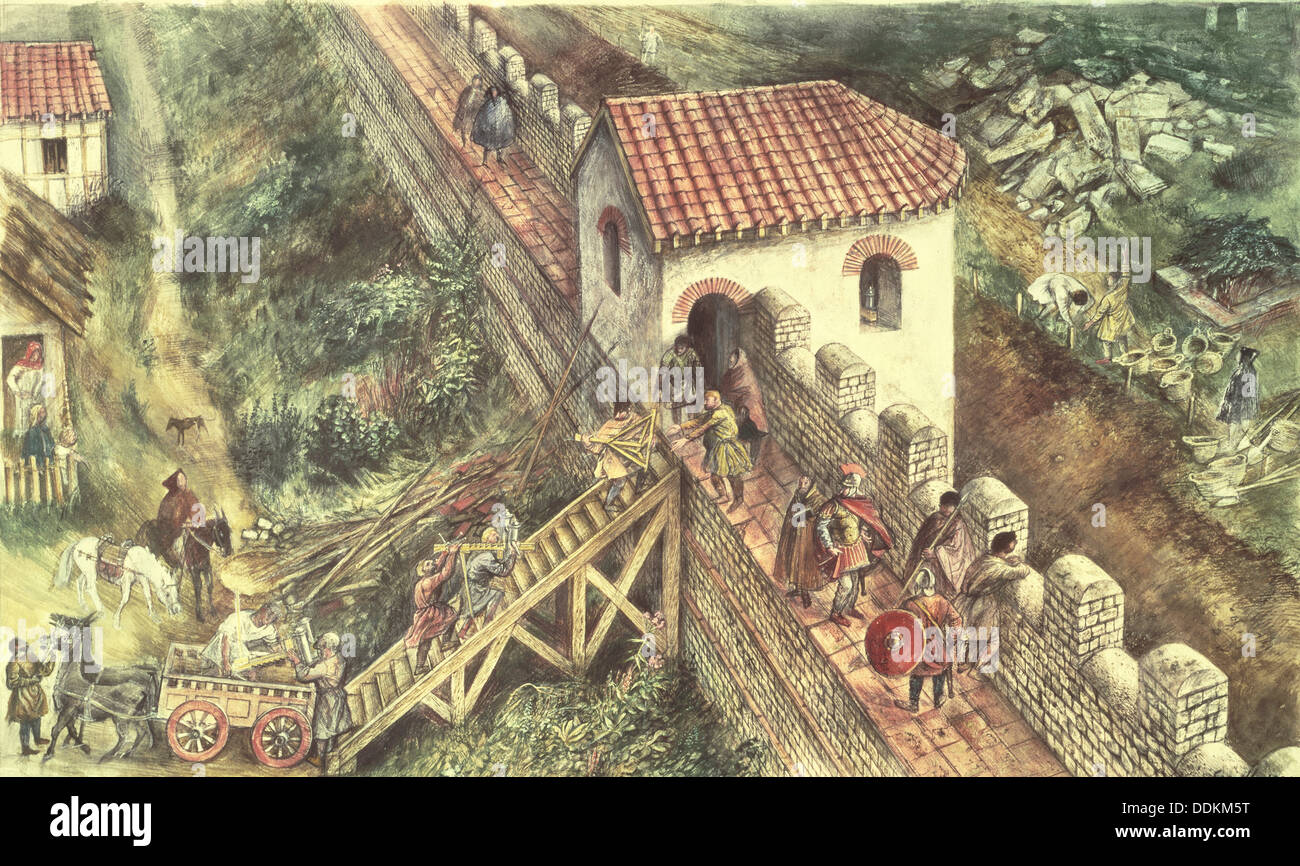 Roman bastion on the city wall, London, 4th century. Artist: Unknown Stock Photohttps://www.alamy.com/image-license-details/?v=1https://www.alamy.com/roman-bastion-on-the-city-wall-london-4th-century-artist-unknown-image60054564.html
Roman bastion on the city wall, London, 4th century. Artist: Unknown Stock Photohttps://www.alamy.com/image-license-details/?v=1https://www.alamy.com/roman-bastion-on-the-city-wall-london-4th-century-artist-unknown-image60054564.htmlRMDDKM5T–Roman bastion on the city wall, London, 4th century. Artist: Unknown
 Fragment of a fishing scene Late 3rd of 4th century Ad from Utica - British Museum, London Stock Photohttps://www.alamy.com/image-license-details/?v=1https://www.alamy.com/stock-photo-fragment-of-a-fishing-scene-late-3rd-of-4th-century-ad-from-utica-52958051.html
Fragment of a fishing scene Late 3rd of 4th century Ad from Utica - British Museum, London Stock Photohttps://www.alamy.com/image-license-details/?v=1https://www.alamy.com/stock-photo-fragment-of-a-fishing-scene-late-3rd-of-4th-century-ad-from-utica-52958051.htmlRMD24CEY–Fragment of a fishing scene Late 3rd of 4th century Ad from Utica - British Museum, London
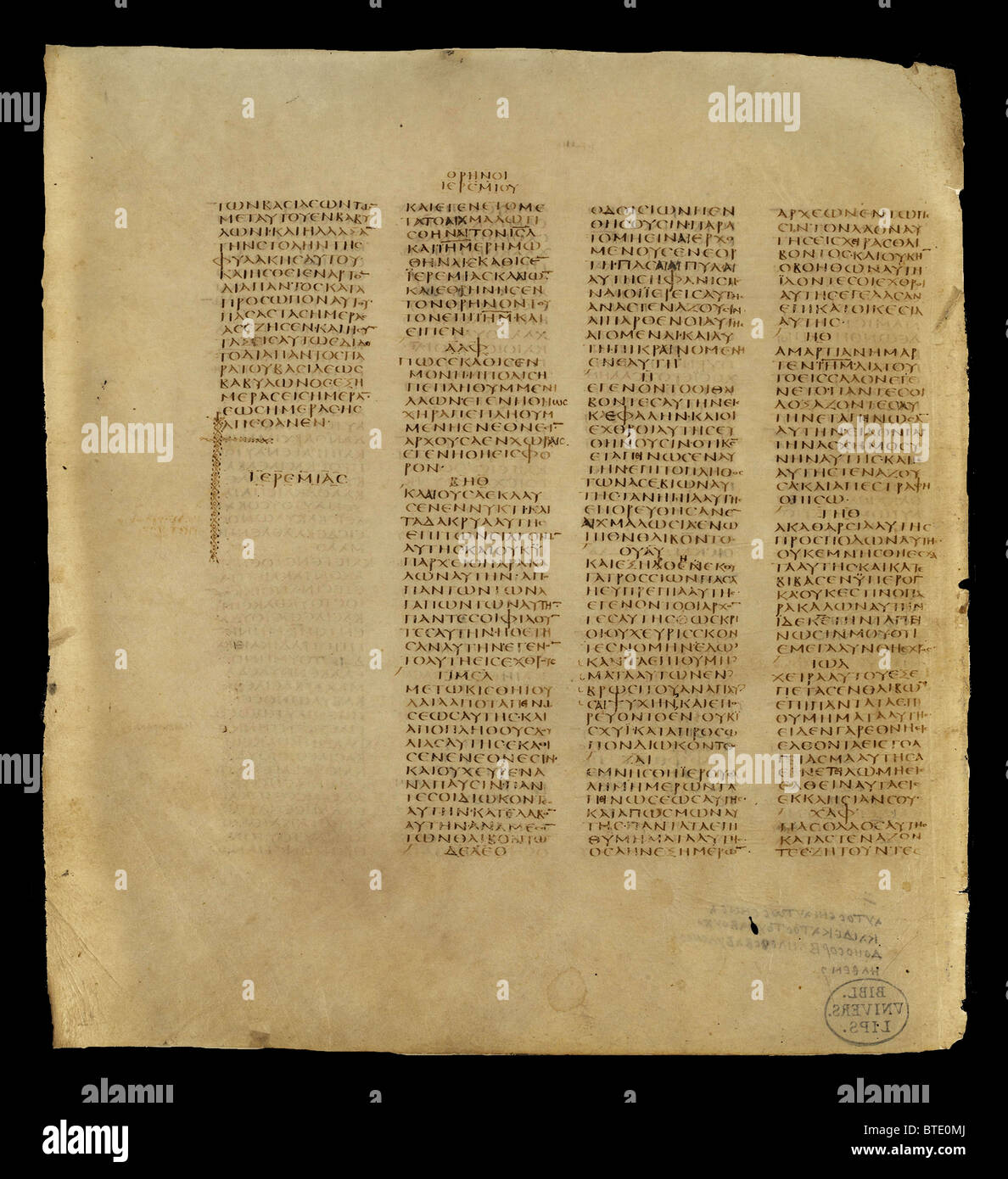 5396. Codex Sinaiticus is a 4th century manuscript of the Greek Bible, written between 330–350. Originally it contained the Stock Photohttps://www.alamy.com/image-license-details/?v=1https://www.alamy.com/stock-photo-5396-codex-sinaiticus-is-a-4th-century-manuscript-of-the-greek-bible-32270018.html
5396. Codex Sinaiticus is a 4th century manuscript of the Greek Bible, written between 330–350. Originally it contained the Stock Photohttps://www.alamy.com/image-license-details/?v=1https://www.alamy.com/stock-photo-5396-codex-sinaiticus-is-a-4th-century-manuscript-of-the-greek-bible-32270018.htmlRMBTE0MJ–5396. Codex Sinaiticus is a 4th century manuscript of the Greek Bible, written between 330–350. Originally it contained the
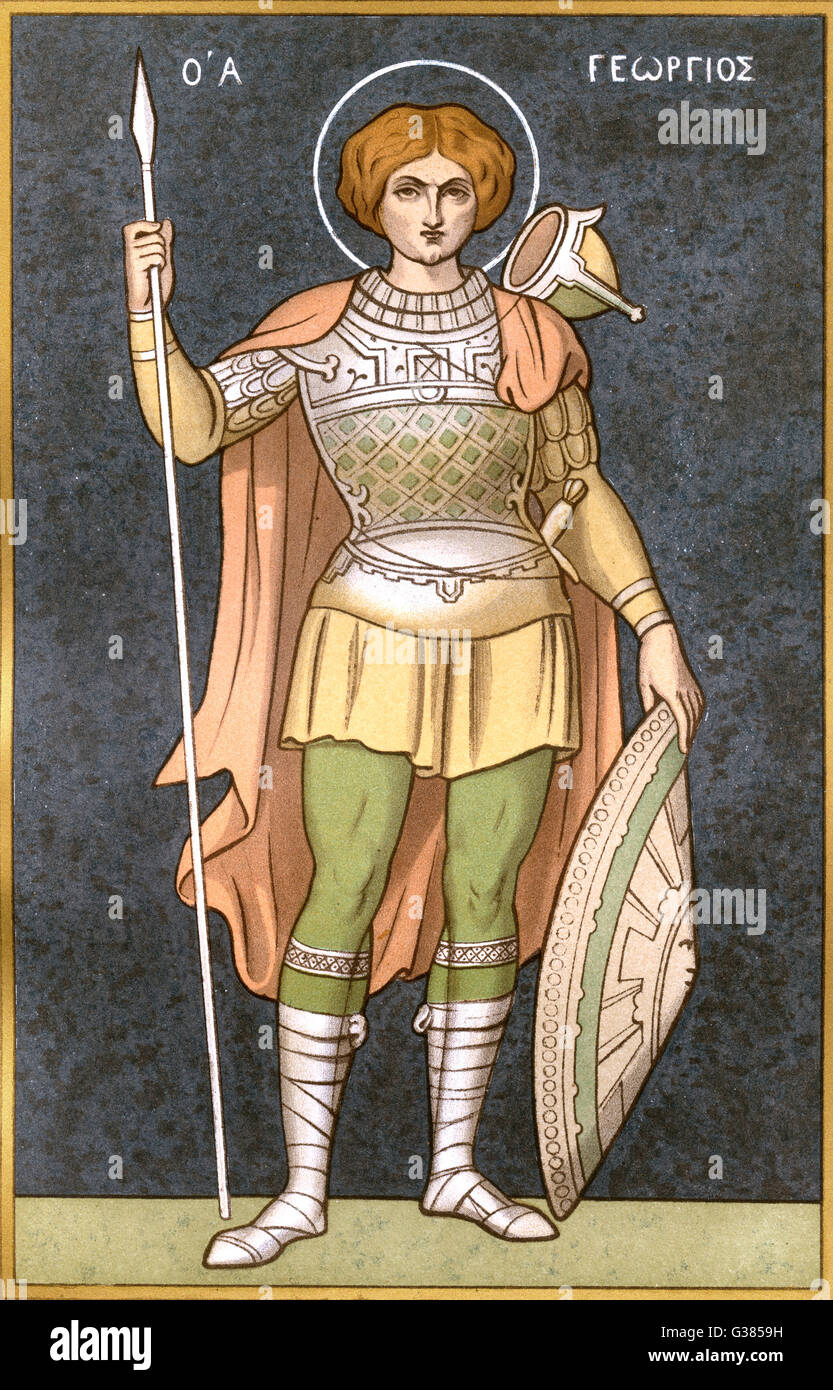 SAINT GEORGE Date: 3rd/4th century Stock Photohttps://www.alamy.com/image-license-details/?v=1https://www.alamy.com/stock-photo-saint-george-date-3rd4th-century-105285981.html
SAINT GEORGE Date: 3rd/4th century Stock Photohttps://www.alamy.com/image-license-details/?v=1https://www.alamy.com/stock-photo-saint-george-date-3rd4th-century-105285981.htmlRMG3859H–SAINT GEORGE Date: 3rd/4th century
 This relief representation of the good shepherd, which is found on the side part of a sarcophagus in Split, dates from the 4th century. Stock Photohttps://www.alamy.com/image-license-details/?v=1https://www.alamy.com/this-relief-representation-of-the-good-shepherd-which-is-found-on-the-side-part-of-a-sarcophagus-in-split-dates-from-the-4th-century-image345683200.html
This relief representation of the good shepherd, which is found on the side part of a sarcophagus in Split, dates from the 4th century. Stock Photohttps://www.alamy.com/image-license-details/?v=1https://www.alamy.com/this-relief-representation-of-the-good-shepherd-which-is-found-on-the-side-part-of-a-sarcophagus-in-split-dates-from-the-4th-century-image345683200.htmlRM2B2B6CG–This relief representation of the good shepherd, which is found on the side part of a sarcophagus in Split, dates from the 4th century.
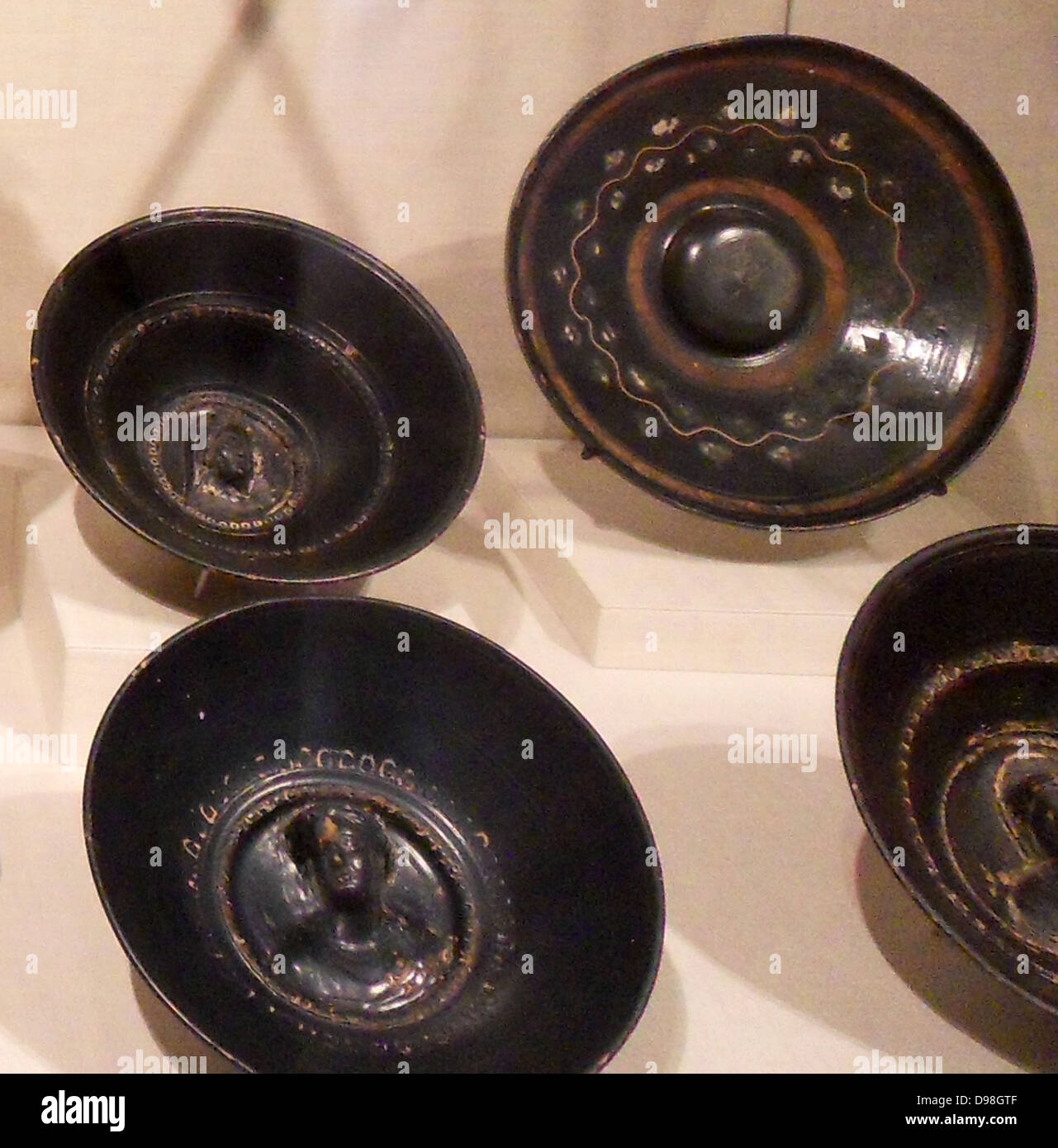 4th Century bronze vessels. Etruscan. Stock Photohttps://www.alamy.com/image-license-details/?v=1https://www.alamy.com/stock-photo-4th-century-bronze-vessels-etruscan-57351855.html
4th Century bronze vessels. Etruscan. Stock Photohttps://www.alamy.com/image-license-details/?v=1https://www.alamy.com/stock-photo-4th-century-bronze-vessels-etruscan-57351855.htmlRMD98GTF–4th Century bronze vessels. Etruscan.
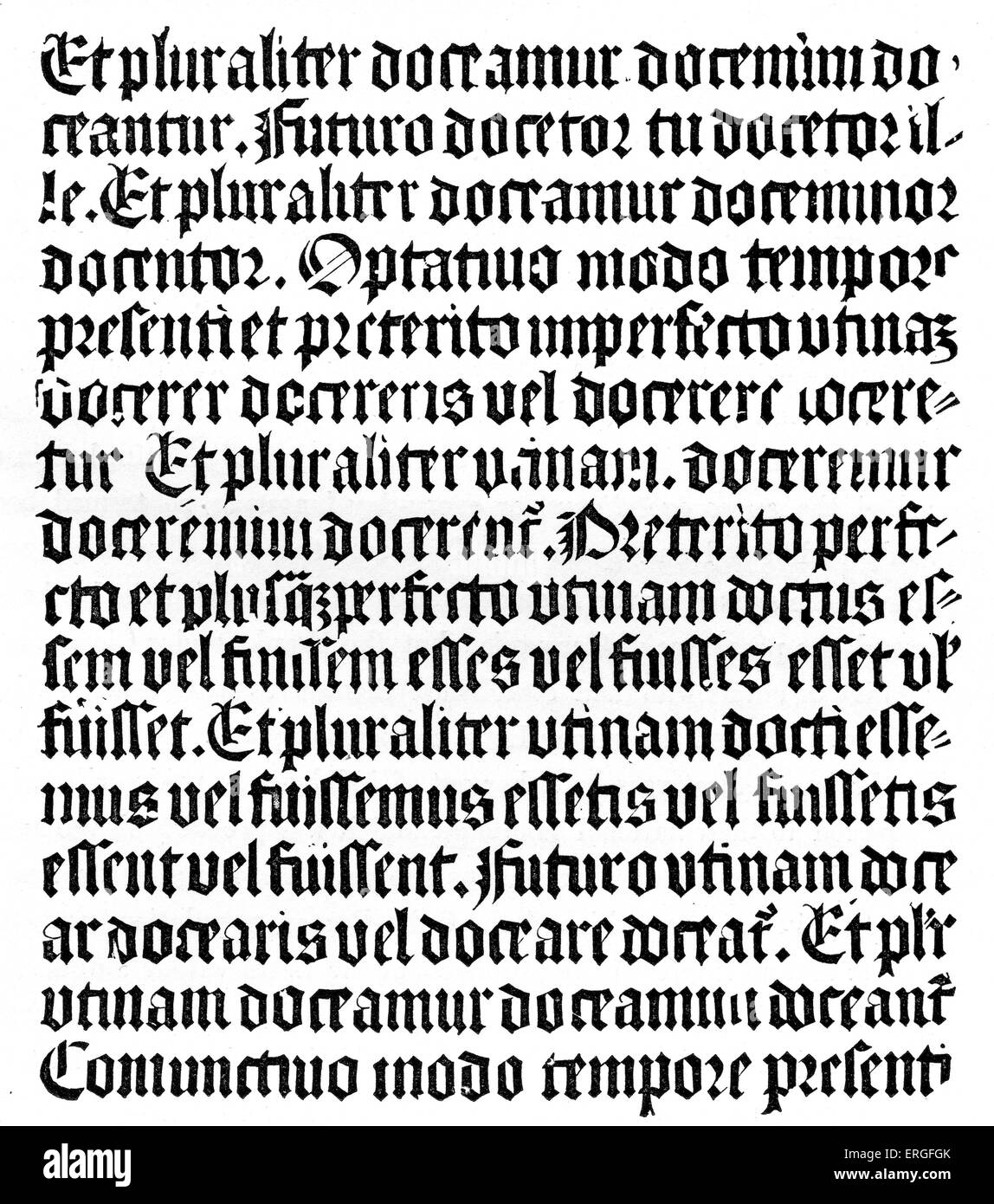 'Grammaire Latine' by Aelius Donatus, 4th century grammarian. Reproduction of wood engraving of xylographical edition, published at Mayence by Johannes Gutenberg. Stock Photohttps://www.alamy.com/image-license-details/?v=1https://www.alamy.com/stock-photo-grammaire-latine-by-aelius-donatus-4th-century-grammarian-reproduction-83342019.html
'Grammaire Latine' by Aelius Donatus, 4th century grammarian. Reproduction of wood engraving of xylographical edition, published at Mayence by Johannes Gutenberg. Stock Photohttps://www.alamy.com/image-license-details/?v=1https://www.alamy.com/stock-photo-grammaire-latine-by-aelius-donatus-4th-century-grammarian-reproduction-83342019.htmlRMERGFGK–'Grammaire Latine' by Aelius Donatus, 4th century grammarian. Reproduction of wood engraving of xylographical edition, published at Mayence by Johannes Gutenberg.
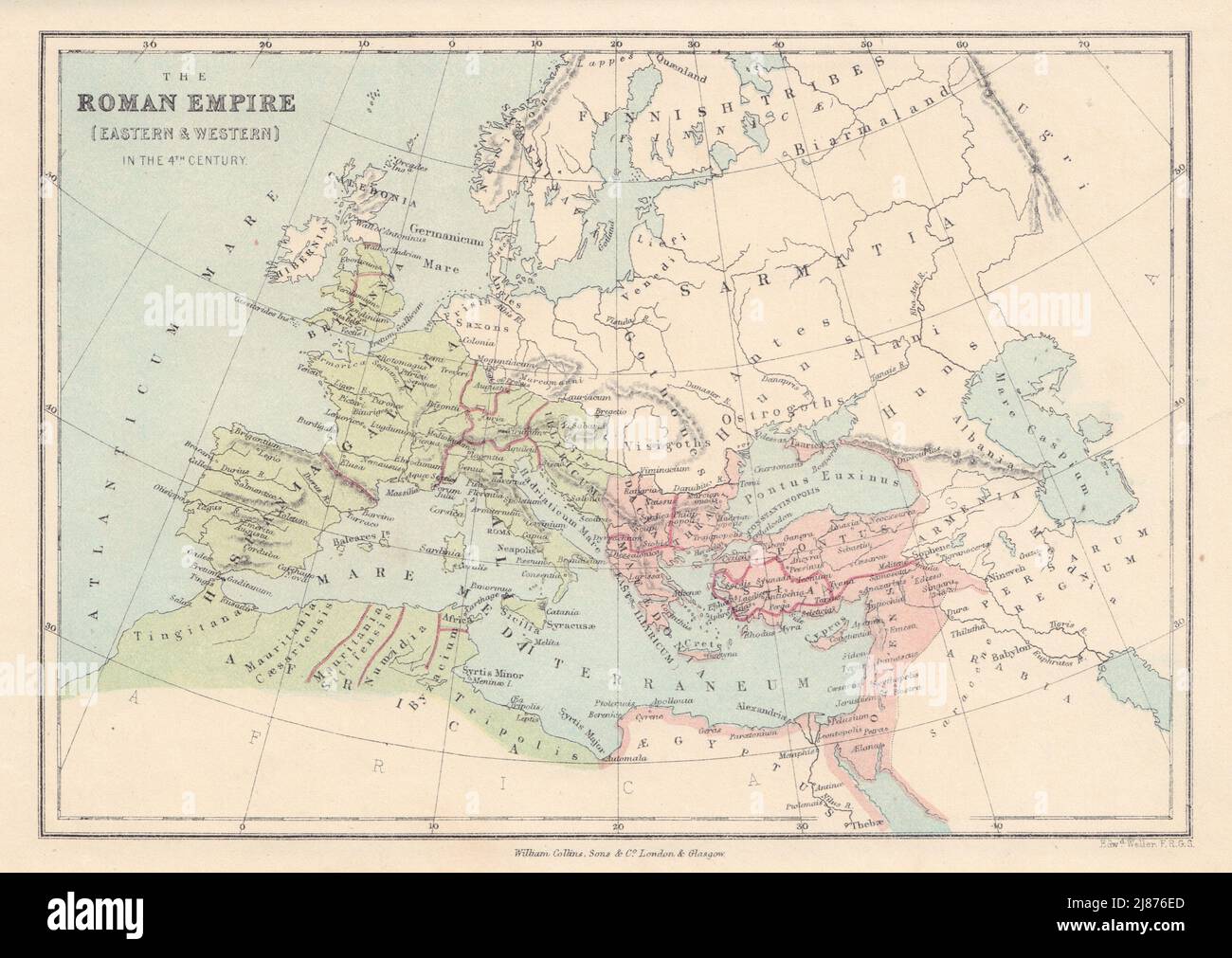 4TH CENTURY EUROPE Roman Empire Eastern Byzantine & Western. COLLINS 1873 map Stock Photohttps://www.alamy.com/image-license-details/?v=1https://www.alamy.com/4th-century-europe-roman-empire-eastern-byzantine-western-collins-1873-map-image469755957.html
4TH CENTURY EUROPE Roman Empire Eastern Byzantine & Western. COLLINS 1873 map Stock Photohttps://www.alamy.com/image-license-details/?v=1https://www.alamy.com/4th-century-europe-roman-empire-eastern-byzantine-western-collins-1873-map-image469755957.htmlRF2J876ED–4TH CENTURY EUROPE Roman Empire Eastern Byzantine & Western. COLLINS 1873 map
 fine arts, Coptic fine arts, sculpturing, female idol, 2nd - 4th century, bone, ARTIST'S COPYRIGHT HAS NOT TO BE CLEARED Stock Photohttps://www.alamy.com/image-license-details/?v=1https://www.alamy.com/fine-arts-coptic-fine-arts-sculpturing-female-idol-2nd-4th-century-bone-artists-copyright-has-not-to-be-cleared-image612586517.html
fine arts, Coptic fine arts, sculpturing, female idol, 2nd - 4th century, bone, ARTIST'S COPYRIGHT HAS NOT TO BE CLEARED Stock Photohttps://www.alamy.com/image-license-details/?v=1https://www.alamy.com/fine-arts-coptic-fine-arts-sculpturing-female-idol-2nd-4th-century-bone-artists-copyright-has-not-to-be-cleared-image612586517.htmlRM2XGHM9W–fine arts, Coptic fine arts, sculpturing, female idol, 2nd - 4th century, bone, ARTIST'S COPYRIGHT HAS NOT TO BE CLEARED
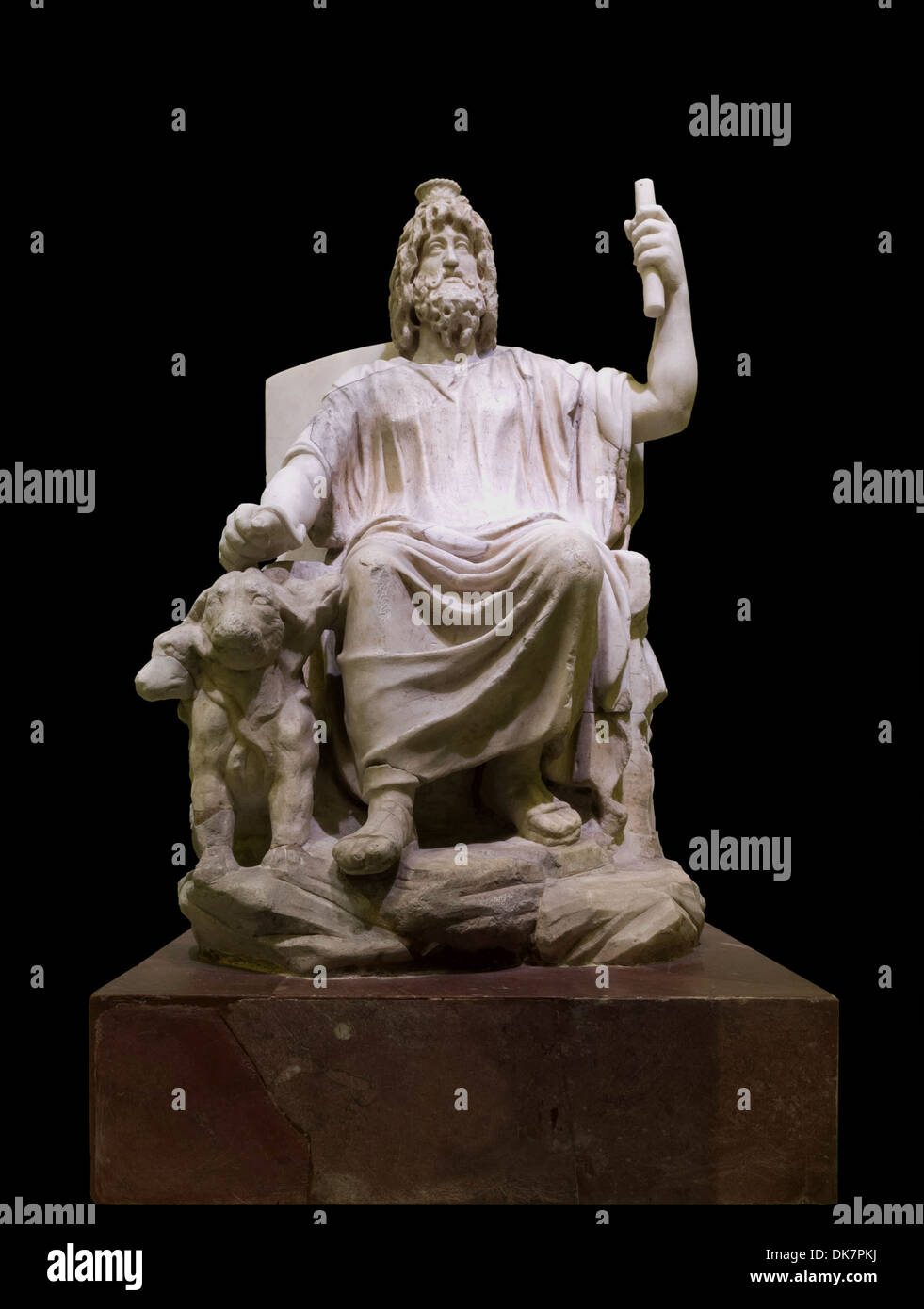 Marble statuette of Serapis, 4th century, Musei Vaticani, temporary exhibition at Colosseum, Rome, Italy. Stock Photohttps://www.alamy.com/image-license-details/?v=1https://www.alamy.com/marble-statuette-of-serapis-4th-century-musei-vaticani-temporary-exhibition-image63481030.html
Marble statuette of Serapis, 4th century, Musei Vaticani, temporary exhibition at Colosseum, Rome, Italy. Stock Photohttps://www.alamy.com/image-license-details/?v=1https://www.alamy.com/marble-statuette-of-serapis-4th-century-musei-vaticani-temporary-exhibition-image63481030.htmlRMDK7PKJ–Marble statuette of Serapis, 4th century, Musei Vaticani, temporary exhibition at Colosseum, Rome, Italy.
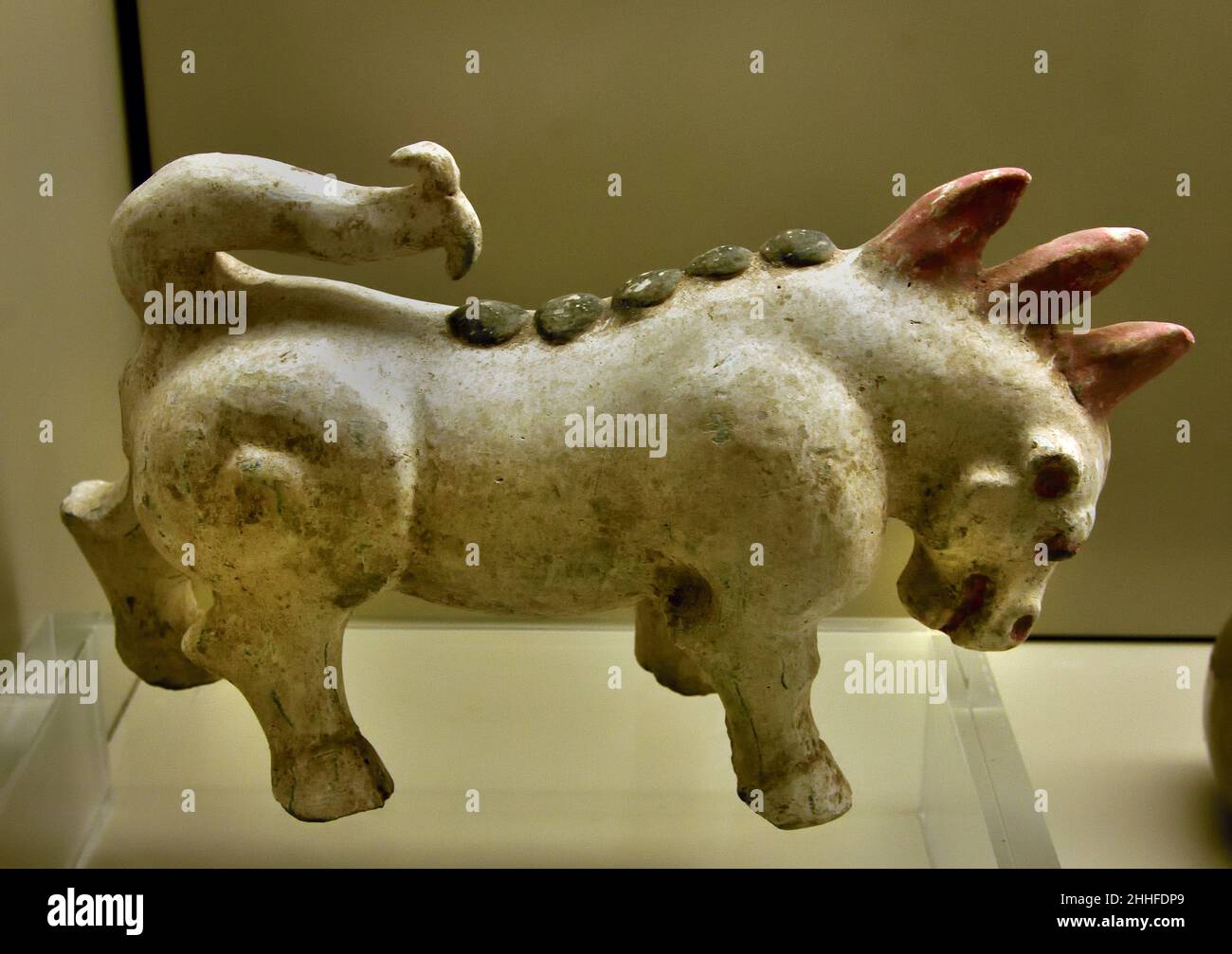 Mythical beast ( a Tomb - guardian ) - Henan . Western Jin early 4th century A.D. China, Chinese. Stoneware glaze. Stock Photohttps://www.alamy.com/image-license-details/?v=1https://www.alamy.com/mythical-beast-a-tomb-guardian-henan-western-jin-early-4th-century-ad-china-chinese-stoneware-glaze-image458258817.html
Mythical beast ( a Tomb - guardian ) - Henan . Western Jin early 4th century A.D. China, Chinese. Stoneware glaze. Stock Photohttps://www.alamy.com/image-license-details/?v=1https://www.alamy.com/mythical-beast-a-tomb-guardian-henan-western-jin-early-4th-century-ad-china-chinese-stoneware-glaze-image458258817.htmlRM2HHFDP9–Mythical beast ( a Tomb - guardian ) - Henan . Western Jin early 4th century A.D. China, Chinese. Stoneware glaze.
 This late 1800s illustration shows a Greek pirate vessel, as taken from the image found on an ancient coin. This type of galley, known as a hemiolia, was developed in the 4th century B.C. Stock Photohttps://www.alamy.com/image-license-details/?v=1https://www.alamy.com/this-late-1800s-illustration-shows-a-greek-pirate-vessel-as-taken-from-the-image-found-on-an-ancient-coin-this-type-of-galley-known-as-a-hemiolia-was-developed-in-the-4th-century-bc-image362195943.html
This late 1800s illustration shows a Greek pirate vessel, as taken from the image found on an ancient coin. This type of galley, known as a hemiolia, was developed in the 4th century B.C. Stock Photohttps://www.alamy.com/image-license-details/?v=1https://www.alamy.com/this-late-1800s-illustration-shows-a-greek-pirate-vessel-as-taken-from-the-image-found-on-an-ancient-coin-this-type-of-galley-known-as-a-hemiolia-was-developed-in-the-4th-century-bc-image362195943.htmlRF2C17CHB–This late 1800s illustration shows a Greek pirate vessel, as taken from the image found on an ancient coin. This type of galley, known as a hemiolia, was developed in the 4th century B.C.
 Roman Surgeon, 4th century, historical re-enactment soldier soldiers England UK Stock Photohttps://www.alamy.com/image-license-details/?v=1https://www.alamy.com/roman-surgeon-4th-century-historical-re-enactment-soldier-soldiers-image67381232.html
Roman Surgeon, 4th century, historical re-enactment soldier soldiers England UK Stock Photohttps://www.alamy.com/image-license-details/?v=1https://www.alamy.com/roman-surgeon-4th-century-historical-re-enactment-soldier-soldiers-image67381232.htmlRMDWHDCG–Roman Surgeon, 4th century, historical re-enactment soldier soldiers England UK
 SAINTS - JOHN CHRYSOSTOM Saint John Chrysostom, the late 4th century archbishop of Constantinople. He is one of the Four Greek Doctors of the Church, and is portrayed in this print in the guise symbolic of a scholar, though he is perhaps more famous for his uncompromising stand against the corruption of Constantinople, during his archbishopric. Process print, from Alban Butler's The Lives of The Fathers, Martyrs and Other Principles Saints, edition of circa 1928. Stock Photohttps://www.alamy.com/image-license-details/?v=1https://www.alamy.com/saints-john-chrysostom-saint-john-chrysostom-the-late-4th-century-archbishop-of-constantinople-he-is-one-of-the-four-greek-doctors-of-the-church-and-is-portrayed-in-this-print-in-the-guise-symbolic-of-a-scholar-though-he-is-perhaps-more-famous-for-his-uncompromising-stand-against-the-corruption-of-constantinople-during-his-archbishopric-process-print-from-alban-butlers-the-lives-of-the-fathers-martyrs-and-other-principles-saints-edition-of-circa-1928-image179627434.html
SAINTS - JOHN CHRYSOSTOM Saint John Chrysostom, the late 4th century archbishop of Constantinople. He is one of the Four Greek Doctors of the Church, and is portrayed in this print in the guise symbolic of a scholar, though he is perhaps more famous for his uncompromising stand against the corruption of Constantinople, during his archbishopric. Process print, from Alban Butler's The Lives of The Fathers, Martyrs and Other Principles Saints, edition of circa 1928. Stock Photohttps://www.alamy.com/image-license-details/?v=1https://www.alamy.com/saints-john-chrysostom-saint-john-chrysostom-the-late-4th-century-archbishop-of-constantinople-he-is-one-of-the-four-greek-doctors-of-the-church-and-is-portrayed-in-this-print-in-the-guise-symbolic-of-a-scholar-though-he-is-perhaps-more-famous-for-his-uncompromising-stand-against-the-corruption-of-constantinople-during-his-archbishopric-process-print-from-alban-butlers-the-lives-of-the-fathers-martyrs-and-other-principles-saints-edition-of-circa-1928-image179627434.htmlRMMC6MHE–SAINTS - JOHN CHRYSOSTOM Saint John Chrysostom, the late 4th century archbishop of Constantinople. He is one of the Four Greek Doctors of the Church, and is portrayed in this print in the guise symbolic of a scholar, though he is perhaps more famous for his uncompromising stand against the corruption of Constantinople, during his archbishopric. Process print, from Alban Butler's The Lives of The Fathers, Martyrs and Other Principles Saints, edition of circa 1928.
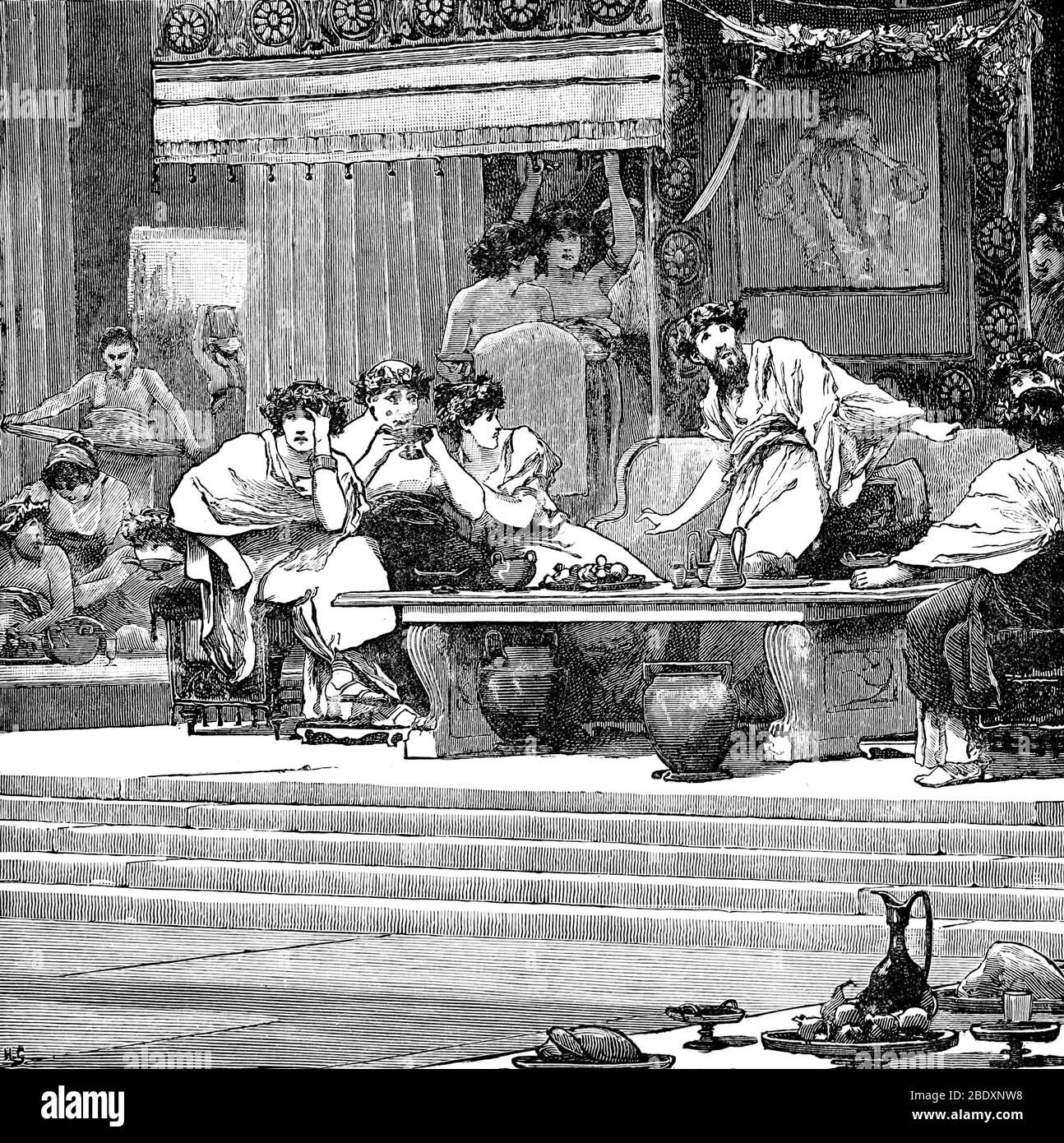 Sword of Damocles, 4th century BC Stock Photohttps://www.alamy.com/image-license-details/?v=1https://www.alamy.com/sword-of-damocles-4th-century-bc-image352785812.html
Sword of Damocles, 4th century BC Stock Photohttps://www.alamy.com/image-license-details/?v=1https://www.alamy.com/sword-of-damocles-4th-century-bc-image352785812.htmlRF2BDXNW8–Sword of Damocles, 4th century BC
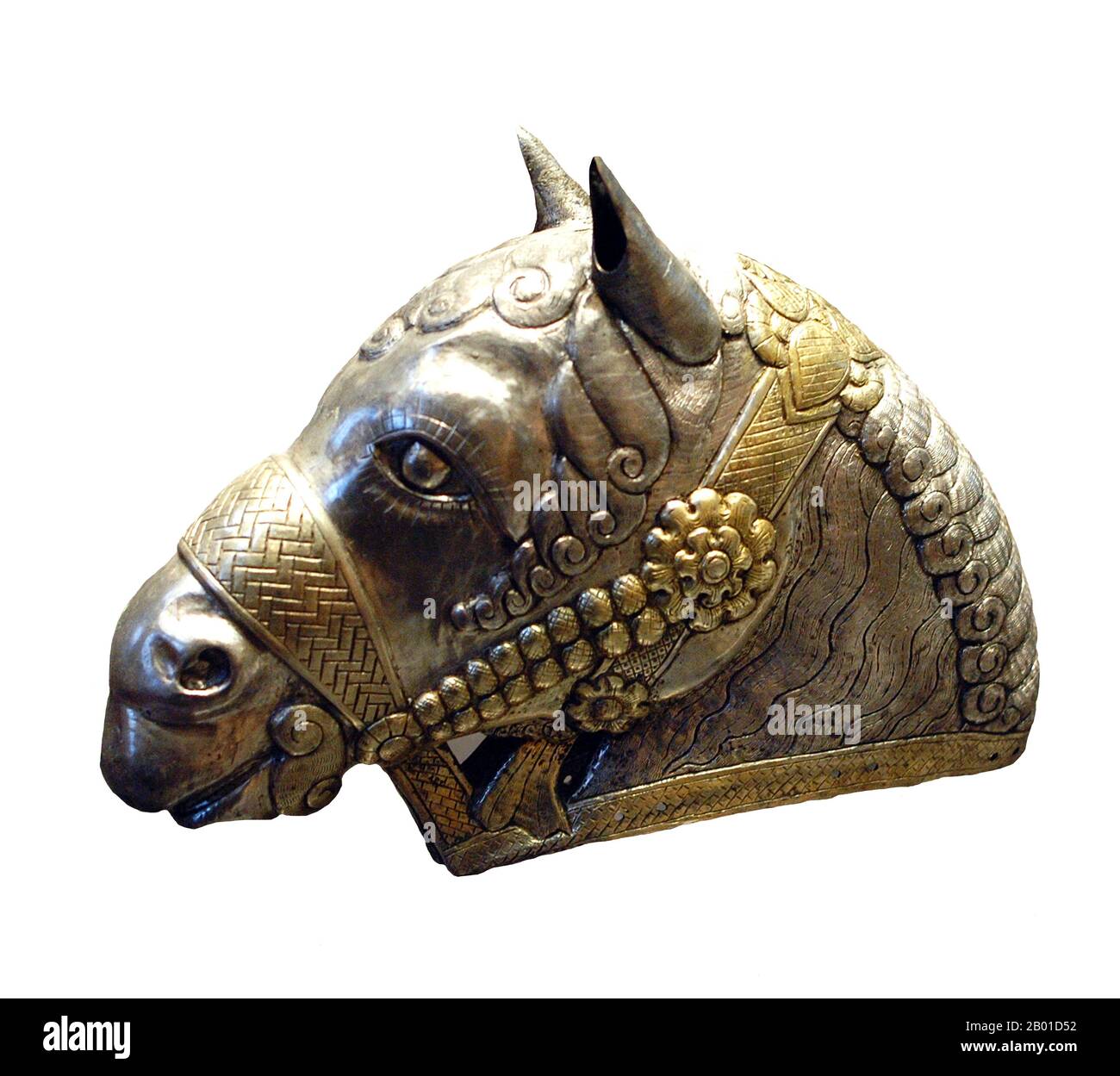 Iran: A horse head in gilded silver found at Kerman, Sassanian Persia, 4th century CE. The Sassanid Empire (also spelled Sasanid Empire, Sassanian Empire or Sasanian Empire), known to its inhabitants as Ērānshahr in Middle Persian and resulting in the New Persian terms Iranshahr and Iran, was the last pre-Islamic Persian Empire, ruled by the Sasanian Dynasty from 224 to 651. The empire, succeeding the Parthian Empire, was recognised as one of the two main powers in Western Asia and Europe, alongside the Roman Empire and its successor, the Byzantine Empire, for a period of over 400 years. Stock Photohttps://www.alamy.com/image-license-details/?v=1https://www.alamy.com/iran-a-horse-head-in-gilded-silver-found-at-kerman-sassanian-persia-4th-century-ce-the-sassanid-empire-also-spelled-sasanid-empire-sassanian-empire-or-sasanian-empire-known-to-its-inhabitants-as-rnshahr-in-middle-persian-and-resulting-in-the-new-persian-terms-iranshahr-and-iran-was-the-last-pre-islamic-persian-empire-ruled-by-the-sasanian-dynasty-from-224-to-651-the-empire-succeeding-the-parthian-empire-was-recognised-as-one-of-the-two-main-powers-in-western-asia-and-europe-alongside-the-roman-empire-and-its-successor-the-byzantine-empire-for-a-period-of-over-400-years-image344239646.html
Iran: A horse head in gilded silver found at Kerman, Sassanian Persia, 4th century CE. The Sassanid Empire (also spelled Sasanid Empire, Sassanian Empire or Sasanian Empire), known to its inhabitants as Ērānshahr in Middle Persian and resulting in the New Persian terms Iranshahr and Iran, was the last pre-Islamic Persian Empire, ruled by the Sasanian Dynasty from 224 to 651. The empire, succeeding the Parthian Empire, was recognised as one of the two main powers in Western Asia and Europe, alongside the Roman Empire and its successor, the Byzantine Empire, for a period of over 400 years. Stock Photohttps://www.alamy.com/image-license-details/?v=1https://www.alamy.com/iran-a-horse-head-in-gilded-silver-found-at-kerman-sassanian-persia-4th-century-ce-the-sassanid-empire-also-spelled-sasanid-empire-sassanian-empire-or-sasanian-empire-known-to-its-inhabitants-as-rnshahr-in-middle-persian-and-resulting-in-the-new-persian-terms-iranshahr-and-iran-was-the-last-pre-islamic-persian-empire-ruled-by-the-sasanian-dynasty-from-224-to-651-the-empire-succeeding-the-parthian-empire-was-recognised-as-one-of-the-two-main-powers-in-western-asia-and-europe-alongside-the-roman-empire-and-its-successor-the-byzantine-empire-for-a-period-of-over-400-years-image344239646.htmlRM2B01D52–Iran: A horse head in gilded silver found at Kerman, Sassanian Persia, 4th century CE. The Sassanid Empire (also spelled Sasanid Empire, Sassanian Empire or Sasanian Empire), known to its inhabitants as Ērānshahr in Middle Persian and resulting in the New Persian terms Iranshahr and Iran, was the last pre-Islamic Persian Empire, ruled by the Sasanian Dynasty from 224 to 651. The empire, succeeding the Parthian Empire, was recognised as one of the two main powers in Western Asia and Europe, alongside the Roman Empire and its successor, the Byzantine Empire, for a period of over 400 years.
 Roman soldiers leaving Briton in the 4th century. Stock Photohttps://www.alamy.com/image-license-details/?v=1https://www.alamy.com/roman-soldiers-leaving-briton-in-the-4th-century-image69188538.html
Roman soldiers leaving Briton in the 4th century. Stock Photohttps://www.alamy.com/image-license-details/?v=1https://www.alamy.com/roman-soldiers-leaving-briton-in-the-4th-century-image69188538.htmlRME0FPK6–Roman soldiers leaving Briton in the 4th century.
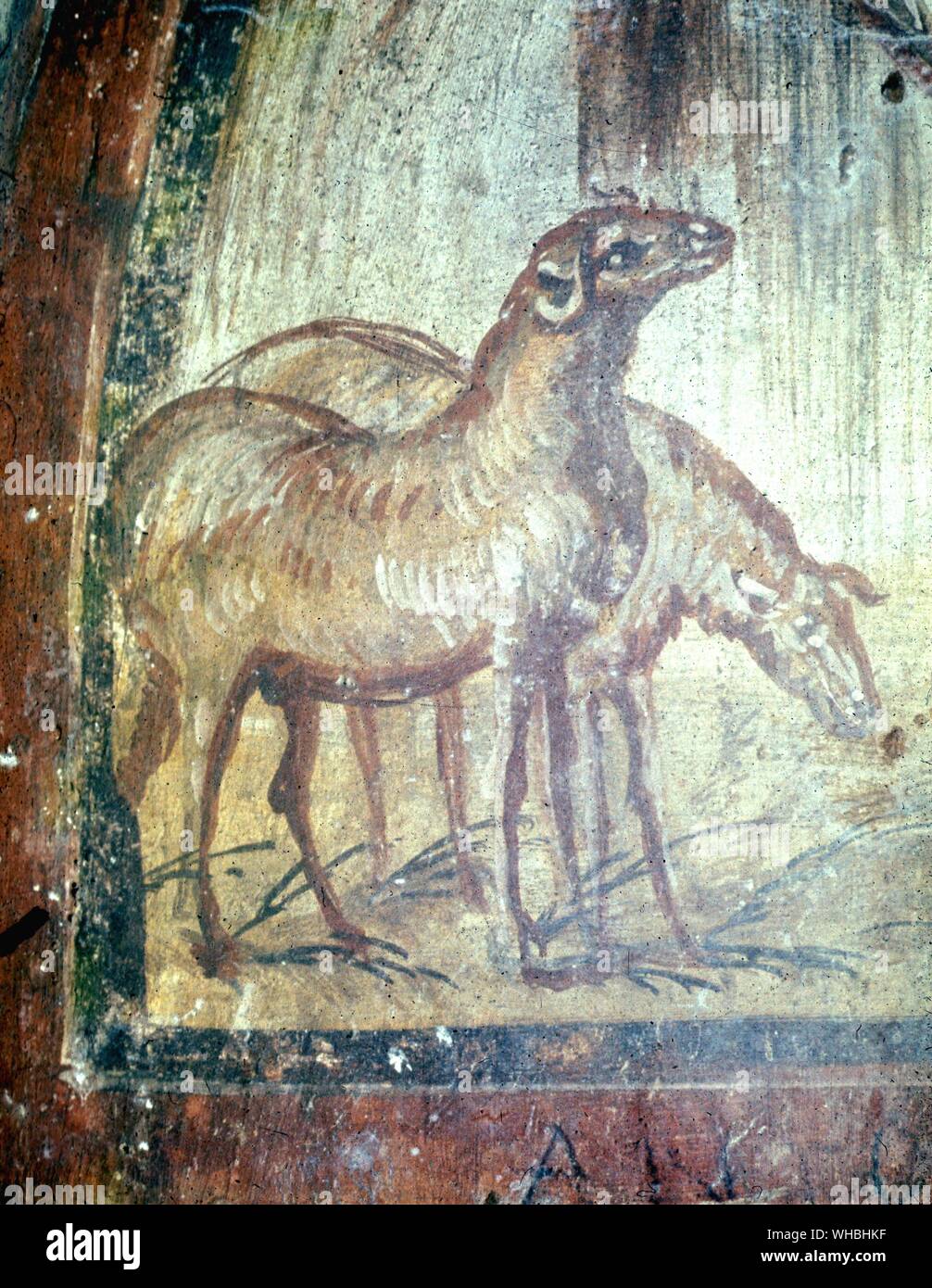 Lambs part of a fresco from the mid 4th Century in the Catacombs of Rome , Italy Stock Photohttps://www.alamy.com/image-license-details/?v=1https://www.alamy.com/lambs-part-of-a-fresco-from-the-mid-4th-century-in-the-catacombs-of-rome-italy-image268860019.html
Lambs part of a fresco from the mid 4th Century in the Catacombs of Rome , Italy Stock Photohttps://www.alamy.com/image-license-details/?v=1https://www.alamy.com/lambs-part-of-a-fresco-from-the-mid-4th-century-in-the-catacombs-of-rome-italy-image268860019.htmlRMWHBHKF–Lambs part of a fresco from the mid 4th Century in the Catacombs of Rome , Italy
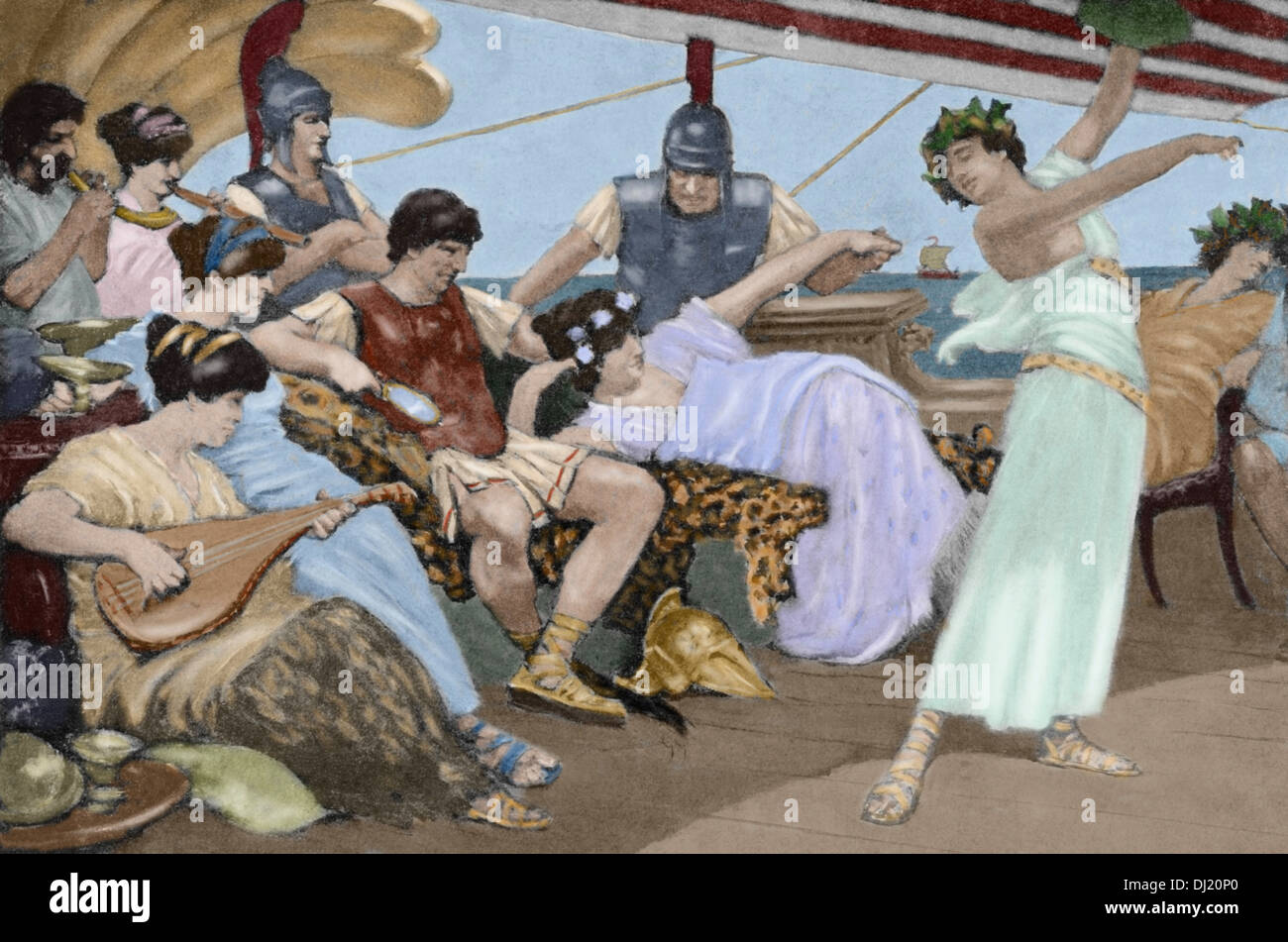 Chares of Athens. 4th century BC. Athenian general. Engraving depicting The dissipated habits of Chares. Colored. Stock Photohttps://www.alamy.com/image-license-details/?v=1https://www.alamy.com/chares-of-athens-4th-century-bc-athenian-general-engraving-depicting-image62739432.html
Chares of Athens. 4th century BC. Athenian general. Engraving depicting The dissipated habits of Chares. Colored. Stock Photohttps://www.alamy.com/image-license-details/?v=1https://www.alamy.com/chares-of-athens-4th-century-bc-athenian-general-engraving-depicting-image62739432.htmlRMDJ20P0–Chares of Athens. 4th century BC. Athenian general. Engraving depicting The dissipated habits of Chares. Colored.
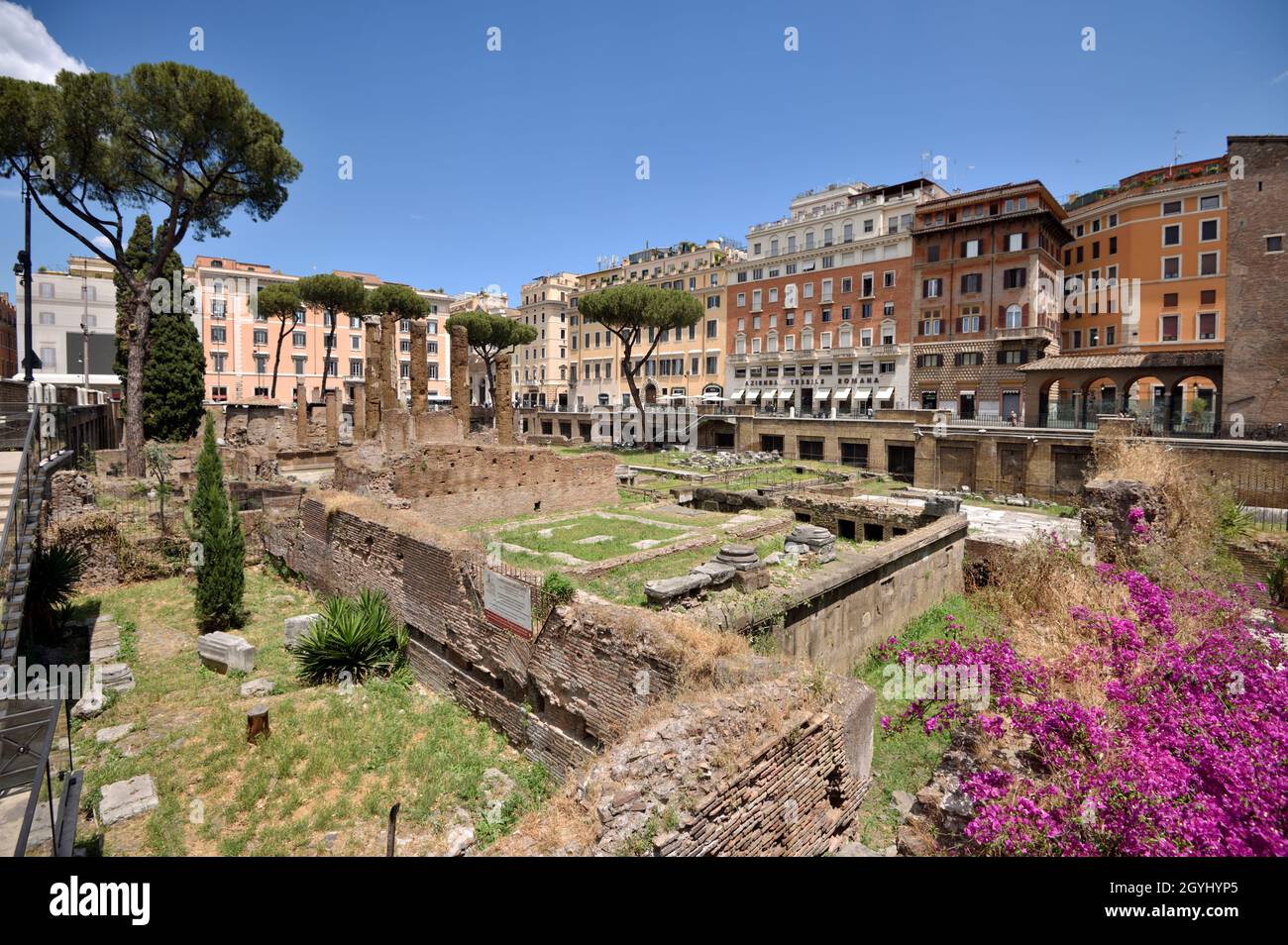 Italy, Rome, Area Sacra of Largo di Torre Argentina, temple C (4th century BC) Stock Photohttps://www.alamy.com/image-license-details/?v=1https://www.alamy.com/italy-rome-area-sacra-of-largo-di-torre-argentina-temple-c-4th-century-bc-image447249885.html
Italy, Rome, Area Sacra of Largo di Torre Argentina, temple C (4th century BC) Stock Photohttps://www.alamy.com/image-license-details/?v=1https://www.alamy.com/italy-rome-area-sacra-of-largo-di-torre-argentina-temple-c-4th-century-bc-image447249885.htmlRM2GYHYP5–Italy, Rome, Area Sacra of Largo di Torre Argentina, temple C (4th century BC)
 Alexander the Great taming the horse Bucephalus in the 4th century BC. Alexander III of Macedon, 356 BC – 323 BC aka Alexander the Great. Stock Photohttps://www.alamy.com/image-license-details/?v=1https://www.alamy.com/alexander-the-great-taming-the-horse-bucephalus-in-the-4th-century-bc-alexander-iii-of-macedon-356-bc-323-bc-aka-alexander-the-great-image592473339.html
Alexander the Great taming the horse Bucephalus in the 4th century BC. Alexander III of Macedon, 356 BC – 323 BC aka Alexander the Great. Stock Photohttps://www.alamy.com/image-license-details/?v=1https://www.alamy.com/alexander-the-great-taming-the-horse-bucephalus-in-the-4th-century-bc-alexander-iii-of-macedon-356-bc-323-bc-aka-alexander-the-great-image592473339.htmlRM2WBWDP3–Alexander the Great taming the horse Bucephalus in the 4th century BC. Alexander III of Macedon, 356 BC – 323 BC aka Alexander the Great.
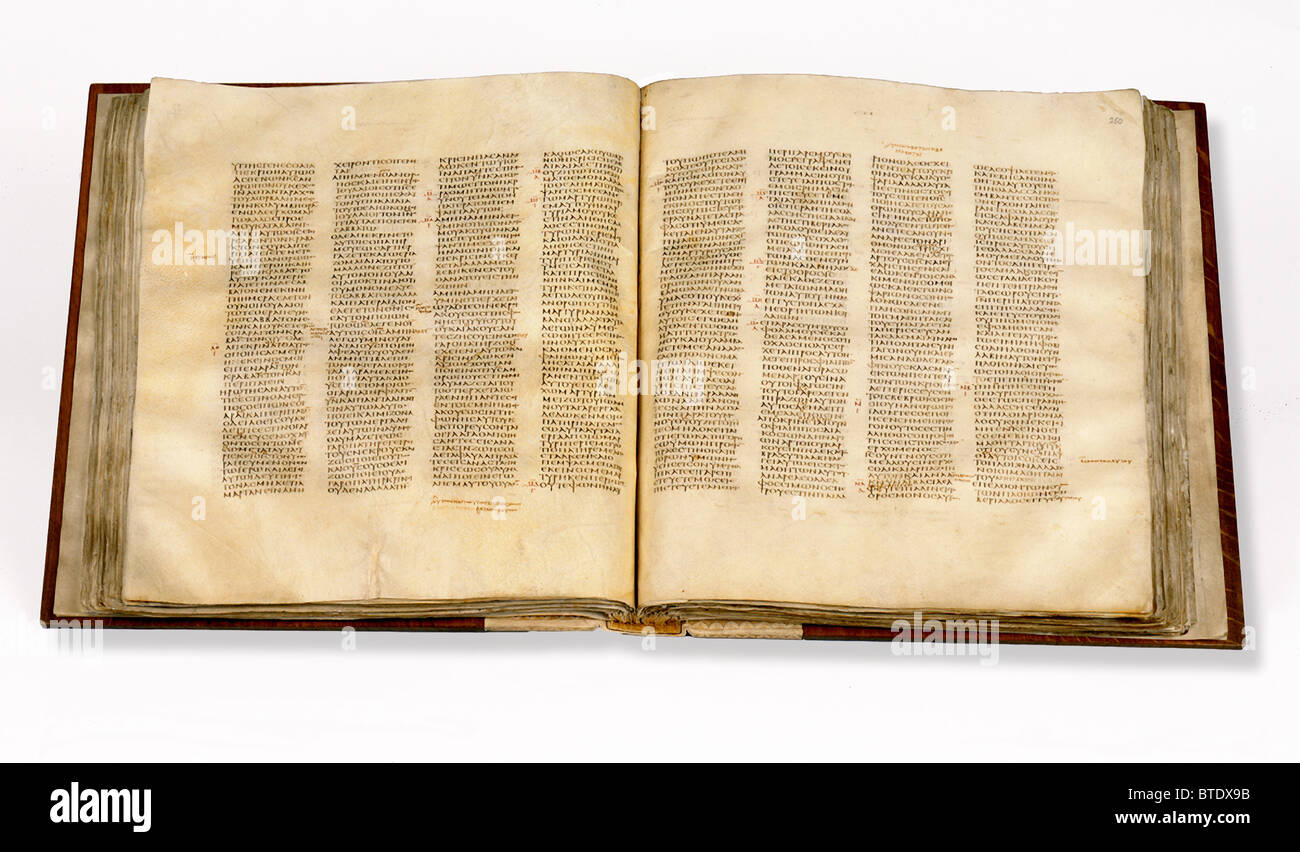 5470. Codex Sinaiticus is a 4th century manuscript of the Greek Bible, written between 330–350. Originally it contained the Stock Photohttps://www.alamy.com/image-license-details/?v=1https://www.alamy.com/stock-photo-5470-codex-sinaiticus-is-a-4th-century-manuscript-of-the-greek-bible-32268135.html
5470. Codex Sinaiticus is a 4th century manuscript of the Greek Bible, written between 330–350. Originally it contained the Stock Photohttps://www.alamy.com/image-license-details/?v=1https://www.alamy.com/stock-photo-5470-codex-sinaiticus-is-a-4th-century-manuscript-of-the-greek-bible-32268135.htmlRMBTDX9B–5470. Codex Sinaiticus is a 4th century manuscript of the Greek Bible, written between 330–350. Originally it contained the
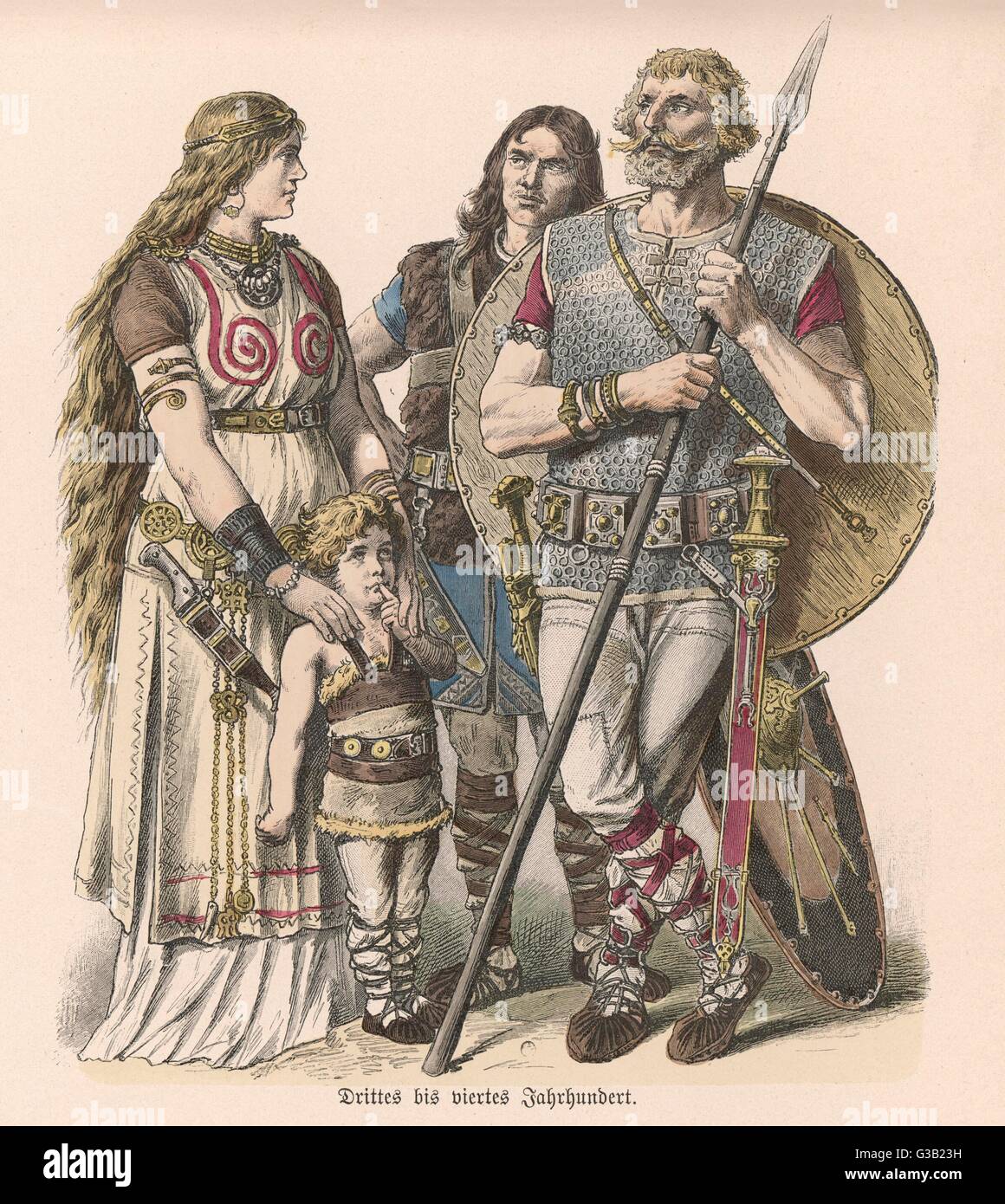 German Men - Women - 4th century Stock Photohttps://www.alamy.com/image-license-details/?v=1https://www.alamy.com/stock-photo-german-men-women-4th-century-105349317.html
German Men - Women - 4th century Stock Photohttps://www.alamy.com/image-license-details/?v=1https://www.alamy.com/stock-photo-german-men-women-4th-century-105349317.htmlRMG3B23H–German Men - Women - 4th century
 A late 1800's illustration showing both sides of an ancient Persian gold coin of Darius known as a Daric . It weighed about 129 grains which showed an archer (in this case type III representing the running king holding a spear) on the reverse. With the siglos coin it represented the bimetallic monetary standard of the Achaemenid Persian Empire The name was later applied to any coin bearing the image of an archer. It dates from the mid-4th century BC. Stock Photohttps://www.alamy.com/image-license-details/?v=1https://www.alamy.com/a-late-1800s-illustration-showing-both-sides-of-an-ancient-persian-gold-coin-of-darius-known-as-a-daric-it-weighed-about-129-grains-which-showed-an-archer-in-this-case-type-iii-representing-the-running-king-holding-a-spear-on-the-reverse-with-the-siglos-coin-it-represented-the-bimetallic-monetary-standard-of-the-achaemenid-persian-empire-the-name-was-later-applied-to-any-coin-bearing-the-image-of-an-archer-it-dates-from-the-mid-4th-century-bc-image452558276.html
A late 1800's illustration showing both sides of an ancient Persian gold coin of Darius known as a Daric . It weighed about 129 grains which showed an archer (in this case type III representing the running king holding a spear) on the reverse. With the siglos coin it represented the bimetallic monetary standard of the Achaemenid Persian Empire The name was later applied to any coin bearing the image of an archer. It dates from the mid-4th century BC. Stock Photohttps://www.alamy.com/image-license-details/?v=1https://www.alamy.com/a-late-1800s-illustration-showing-both-sides-of-an-ancient-persian-gold-coin-of-darius-known-as-a-daric-it-weighed-about-129-grains-which-showed-an-archer-in-this-case-type-iii-representing-the-running-king-holding-a-spear-on-the-reverse-with-the-siglos-coin-it-represented-the-bimetallic-monetary-standard-of-the-achaemenid-persian-empire-the-name-was-later-applied-to-any-coin-bearing-the-image-of-an-archer-it-dates-from-the-mid-4th-century-bc-image452558276.htmlRM2H87PKG–A late 1800's illustration showing both sides of an ancient Persian gold coin of Darius known as a Daric . It weighed about 129 grains which showed an archer (in this case type III representing the running king holding a spear) on the reverse. With the siglos coin it represented the bimetallic monetary standard of the Achaemenid Persian Empire The name was later applied to any coin bearing the image of an archer. It dates from the mid-4th century BC.
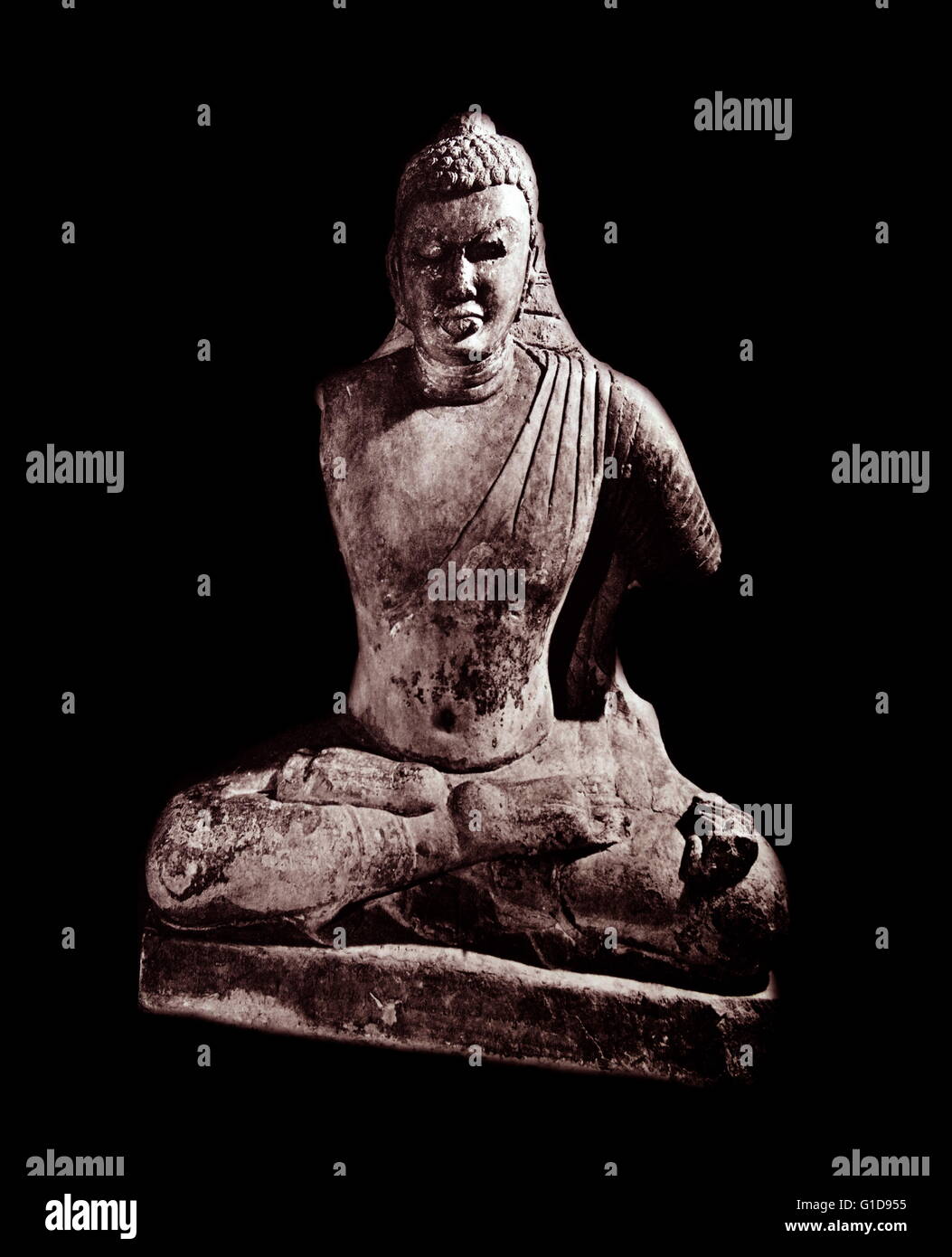 Buddha Bodhgaya, Bihar, India. 4th century Stock Photohttps://www.alamy.com/image-license-details/?v=1https://www.alamy.com/stock-photo-buddha-bodhgaya-bihar-india-4th-century-104169441.html
Buddha Bodhgaya, Bihar, India. 4th century Stock Photohttps://www.alamy.com/image-license-details/?v=1https://www.alamy.com/stock-photo-buddha-bodhgaya-bihar-india-4th-century-104169441.htmlRMG1D955–Buddha Bodhgaya, Bihar, India. 4th century
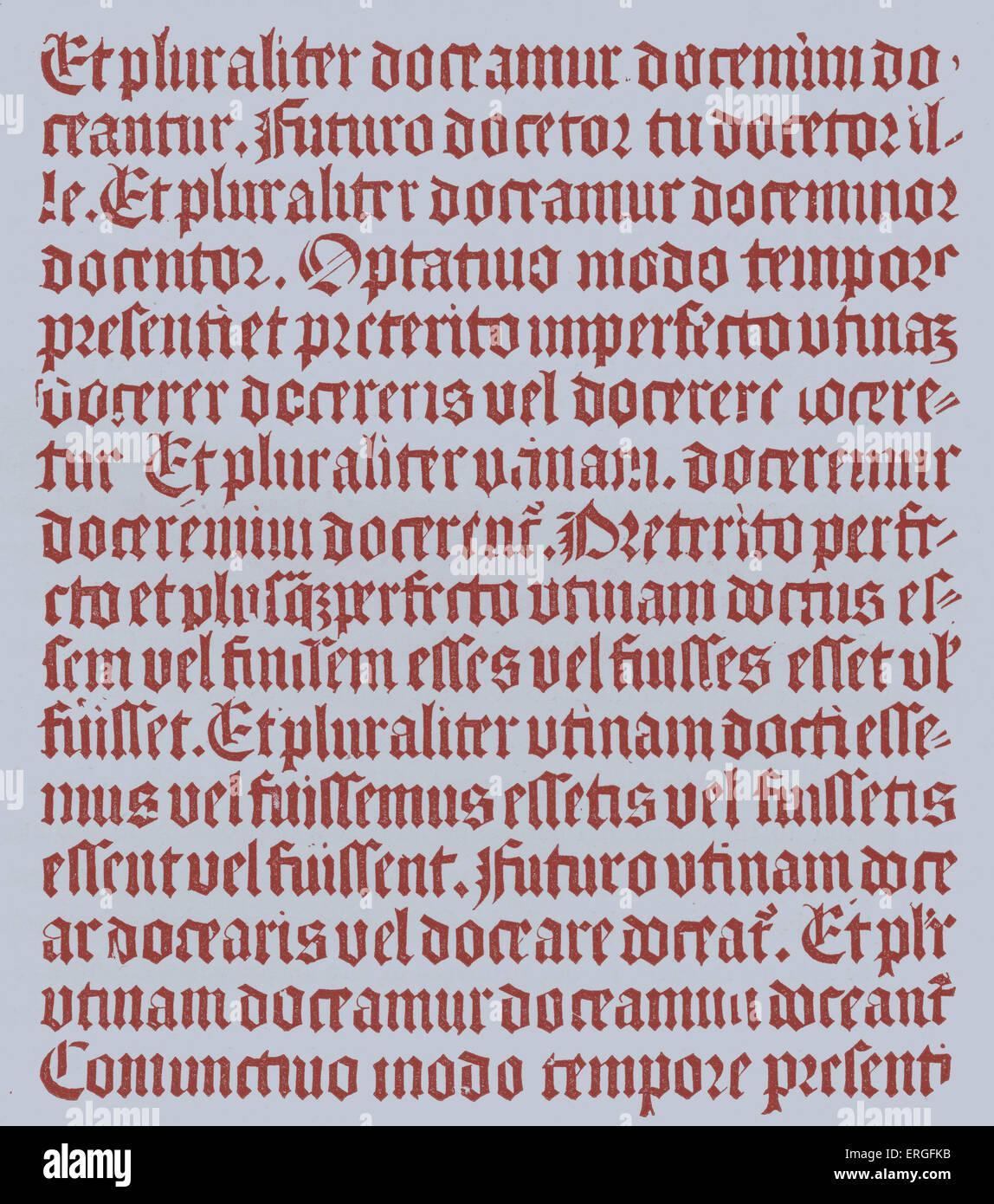 'Grammaire Latine' by Aelius Donatus, 4th century grammarian. Reproduction of wood engraving of xylographical edition, published at Mayence by Johannes Gutenberg. Stock Photohttps://www.alamy.com/image-license-details/?v=1https://www.alamy.com/stock-photo-grammaire-latine-by-aelius-donatus-4th-century-grammarian-reproduction-83342095.html
'Grammaire Latine' by Aelius Donatus, 4th century grammarian. Reproduction of wood engraving of xylographical edition, published at Mayence by Johannes Gutenberg. Stock Photohttps://www.alamy.com/image-license-details/?v=1https://www.alamy.com/stock-photo-grammaire-latine-by-aelius-donatus-4th-century-grammarian-reproduction-83342095.htmlRMERGFKB–'Grammaire Latine' by Aelius Donatus, 4th century grammarian. Reproduction of wood engraving of xylographical edition, published at Mayence by Johannes Gutenberg.
 SHECHEM: Apse of 4th-century Church over Jacob's well at(Nablus), print 1902 Stock Photohttps://www.alamy.com/image-license-details/?v=1https://www.alamy.com/stock-photo-shechem-apse-of-4th-century-church-over-jacobs-well-atnablus-print-105439612.html
SHECHEM: Apse of 4th-century Church over Jacob's well at(Nablus), print 1902 Stock Photohttps://www.alamy.com/image-license-details/?v=1https://www.alamy.com/stock-photo-shechem-apse-of-4th-century-church-over-jacobs-well-atnablus-print-105439612.htmlRFG3F58C–SHECHEM: Apse of 4th-century Church over Jacob's well at(Nablus), print 1902
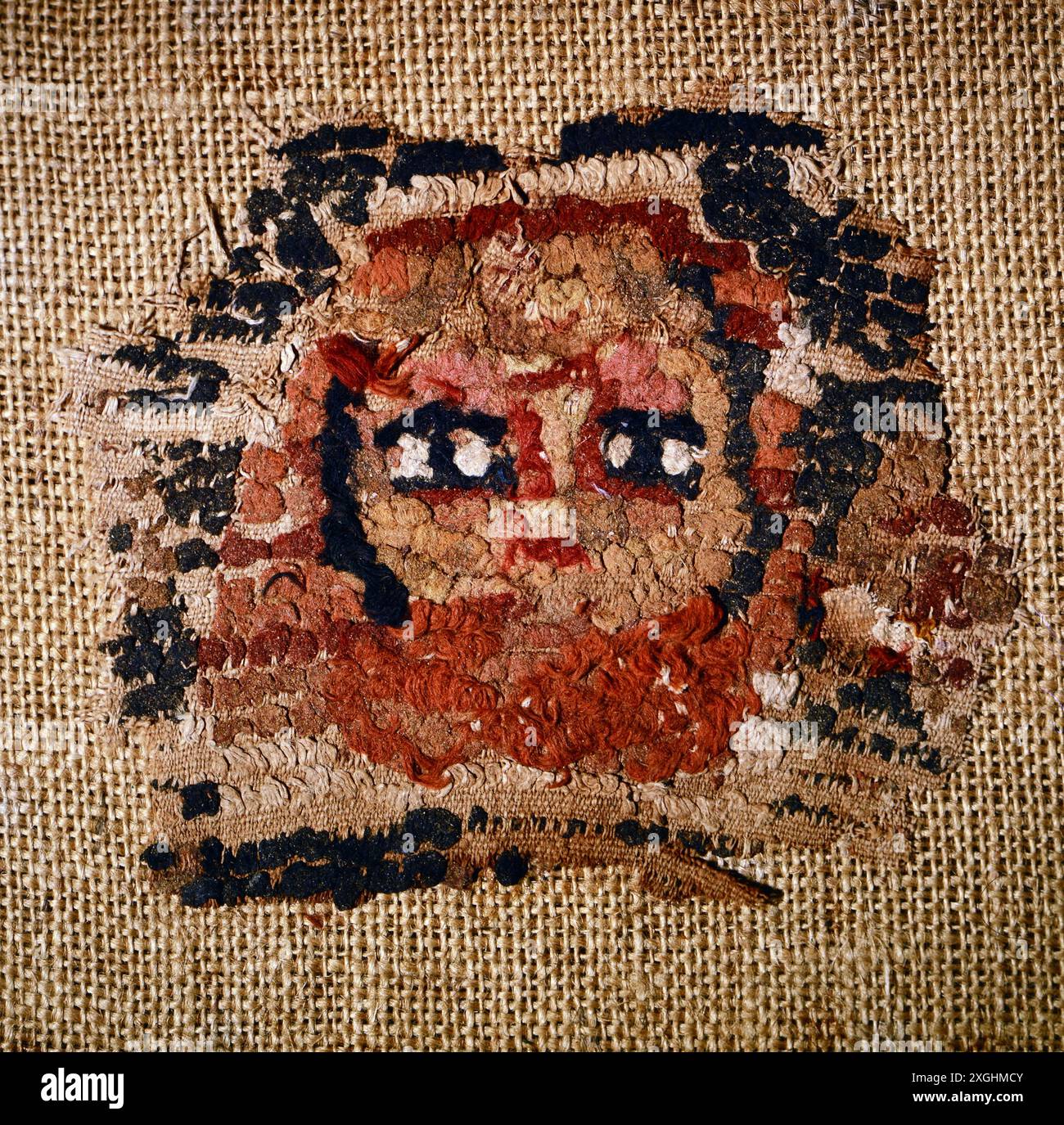 fine arts, Coptic fine arts, textiles, head of a child, 3rd / 4th century, terry cloth, ARTIST'S COPYRIGHT HAS NOT TO BE CLEARED Stock Photohttps://www.alamy.com/image-license-details/?v=1https://www.alamy.com/fine-arts-coptic-fine-arts-textiles-head-of-a-child-3rd-4th-century-terry-cloth-artists-copyright-has-not-to-be-cleared-image612586603.html
fine arts, Coptic fine arts, textiles, head of a child, 3rd / 4th century, terry cloth, ARTIST'S COPYRIGHT HAS NOT TO BE CLEARED Stock Photohttps://www.alamy.com/image-license-details/?v=1https://www.alamy.com/fine-arts-coptic-fine-arts-textiles-head-of-a-child-3rd-4th-century-terry-cloth-artists-copyright-has-not-to-be-cleared-image612586603.htmlRM2XGHMCY–fine arts, Coptic fine arts, textiles, head of a child, 3rd / 4th century, terry cloth, ARTIST'S COPYRIGHT HAS NOT TO BE CLEARED
 Mosaic of Medusa and the seasons. 4th century. Image of 1 seasons. Palencia. Spain. Stock Photohttps://www.alamy.com/image-license-details/?v=1https://www.alamy.com/stock-photo-mosaic-of-medusa-and-the-seasons-4th-century-image-of-1-seasons-palencia-133010043.html
Mosaic of Medusa and the seasons. 4th century. Image of 1 seasons. Palencia. Spain. Stock Photohttps://www.alamy.com/image-license-details/?v=1https://www.alamy.com/stock-photo-mosaic-of-medusa-and-the-seasons-4th-century-image-of-1-seasons-palencia-133010043.htmlRMHMB3JK–Mosaic of Medusa and the seasons. 4th century. Image of 1 seasons. Palencia. Spain.
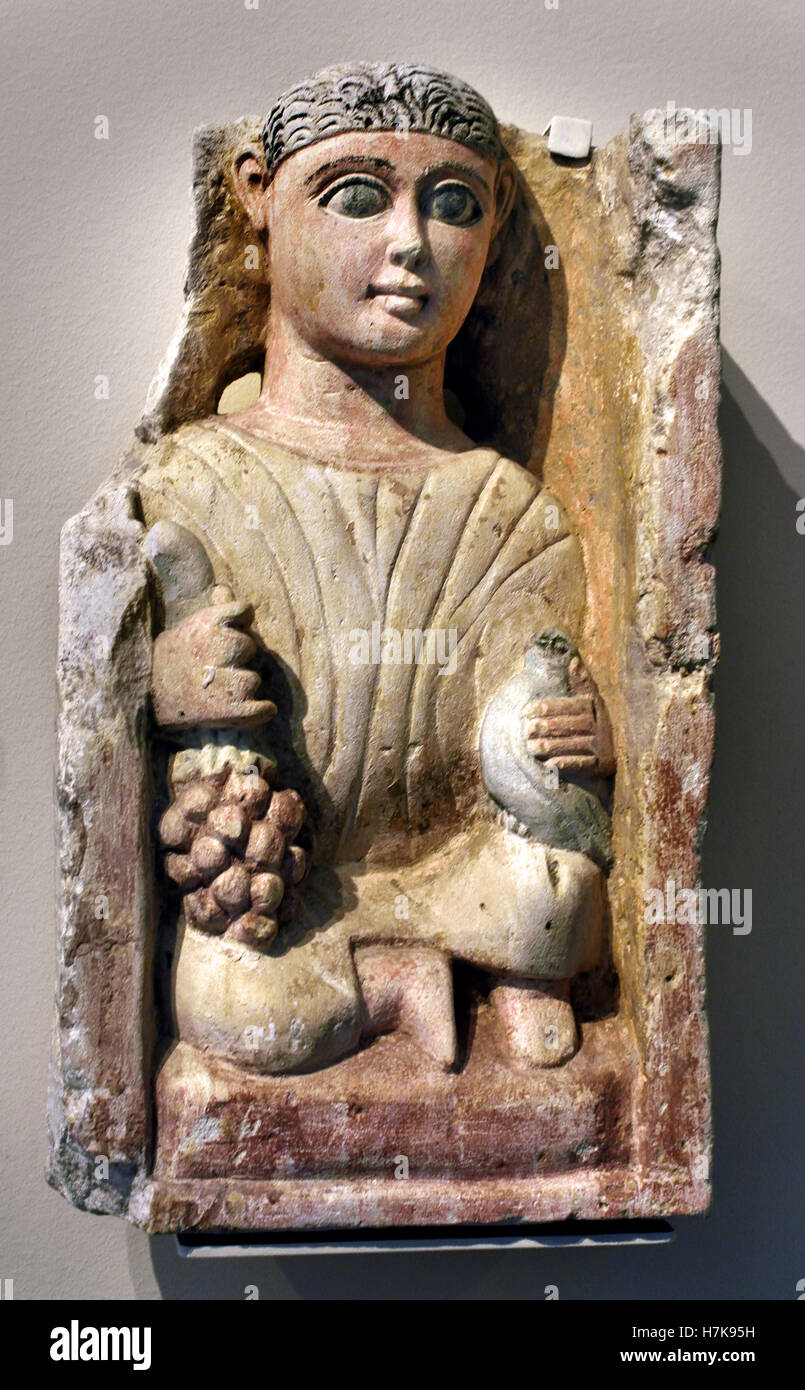 Tomb Relief of a Boy 4th Century Egypt Egyptian Stock Photohttps://www.alamy.com/image-license-details/?v=1https://www.alamy.com/stock-photo-tomb-relief-of-a-boy-4th-century-egypt-egyptian-125199469.html
Tomb Relief of a Boy 4th Century Egypt Egyptian Stock Photohttps://www.alamy.com/image-license-details/?v=1https://www.alamy.com/stock-photo-tomb-relief-of-a-boy-4th-century-egypt-egyptian-125199469.htmlRMH7K95H–Tomb Relief of a Boy 4th Century Egypt Egyptian
 This photo of a mosaic showing a detail from the chamber of Arione was taken in the summer of 1970 at Piazza Armerina in Sicily. Piazza Armerina is home to the Roman Villa del Casale and its famous mosaics, the 'finest mosaics in situ anywhere in the Roman world,' as described by UNESCO, which inserted it into its World Heritage list in 1997. Villa Romana was a lavish patrician residence built at the center of a huge latifundium (agricultural estate) at the end of the 4th century AD. It is thought to have belonged to a member of the Roman senatorial aristocracy, who traded in exotic animals. Stock Photohttps://www.alamy.com/image-license-details/?v=1https://www.alamy.com/this-photo-of-a-mosaic-showing-a-detail-from-the-chamber-of-arione-was-taken-in-the-summer-of-1970-at-piazza-armerina-in-sicily-piazza-armerina-is-home-to-the-roman-villa-del-casale-and-its-famous-mosaics-the-finest-mosaics-in-situ-anywhere-in-the-roman-world-as-described-by-unesco-which-inserted-it-into-its-world-heritage-list-in-1997-villa-romana-was-a-lavish-patrician-residence-built-at-the-center-of-a-huge-latifundium-agricultural-estate-at-the-end-of-the-4th-century-ad-it-is-thought-to-have-belonged-to-a-member-of-the-roman-senatorial-aristocracy-who-traded-in-exotic-animals-image557837204.html
This photo of a mosaic showing a detail from the chamber of Arione was taken in the summer of 1970 at Piazza Armerina in Sicily. Piazza Armerina is home to the Roman Villa del Casale and its famous mosaics, the 'finest mosaics in situ anywhere in the Roman world,' as described by UNESCO, which inserted it into its World Heritage list in 1997. Villa Romana was a lavish patrician residence built at the center of a huge latifundium (agricultural estate) at the end of the 4th century AD. It is thought to have belonged to a member of the Roman senatorial aristocracy, who traded in exotic animals. Stock Photohttps://www.alamy.com/image-license-details/?v=1https://www.alamy.com/this-photo-of-a-mosaic-showing-a-detail-from-the-chamber-of-arione-was-taken-in-the-summer-of-1970-at-piazza-armerina-in-sicily-piazza-armerina-is-home-to-the-roman-villa-del-casale-and-its-famous-mosaics-the-finest-mosaics-in-situ-anywhere-in-the-roman-world-as-described-by-unesco-which-inserted-it-into-its-world-heritage-list-in-1997-villa-romana-was-a-lavish-patrician-residence-built-at-the-center-of-a-huge-latifundium-agricultural-estate-at-the-end-of-the-4th-century-ad-it-is-thought-to-have-belonged-to-a-member-of-the-roman-senatorial-aristocracy-who-traded-in-exotic-animals-image557837204.htmlRF2RBFK18–This photo of a mosaic showing a detail from the chamber of Arione was taken in the summer of 1970 at Piazza Armerina in Sicily. Piazza Armerina is home to the Roman Villa del Casale and its famous mosaics, the 'finest mosaics in situ anywhere in the Roman world,' as described by UNESCO, which inserted it into its World Heritage list in 1997. Villa Romana was a lavish patrician residence built at the center of a huge latifundium (agricultural estate) at the end of the 4th century AD. It is thought to have belonged to a member of the Roman senatorial aristocracy, who traded in exotic animals.
 Romano British Warrior 4th century historical re-enactment England UK soldier armour weapons weapory shield spear helmet Stock Photohttps://www.alamy.com/image-license-details/?v=1https://www.alamy.com/stock-photo-romano-british-warrior-4th-century-historical-re-enactment-england-22310127.html
Romano British Warrior 4th century historical re-enactment England UK soldier armour weapons weapory shield spear helmet Stock Photohttps://www.alamy.com/image-license-details/?v=1https://www.alamy.com/stock-photo-romano-british-warrior-4th-century-historical-re-enactment-england-22310127.htmlRMB888P7–Romano British Warrior 4th century historical re-enactment England UK soldier armour weapons weapory shield spear helmet
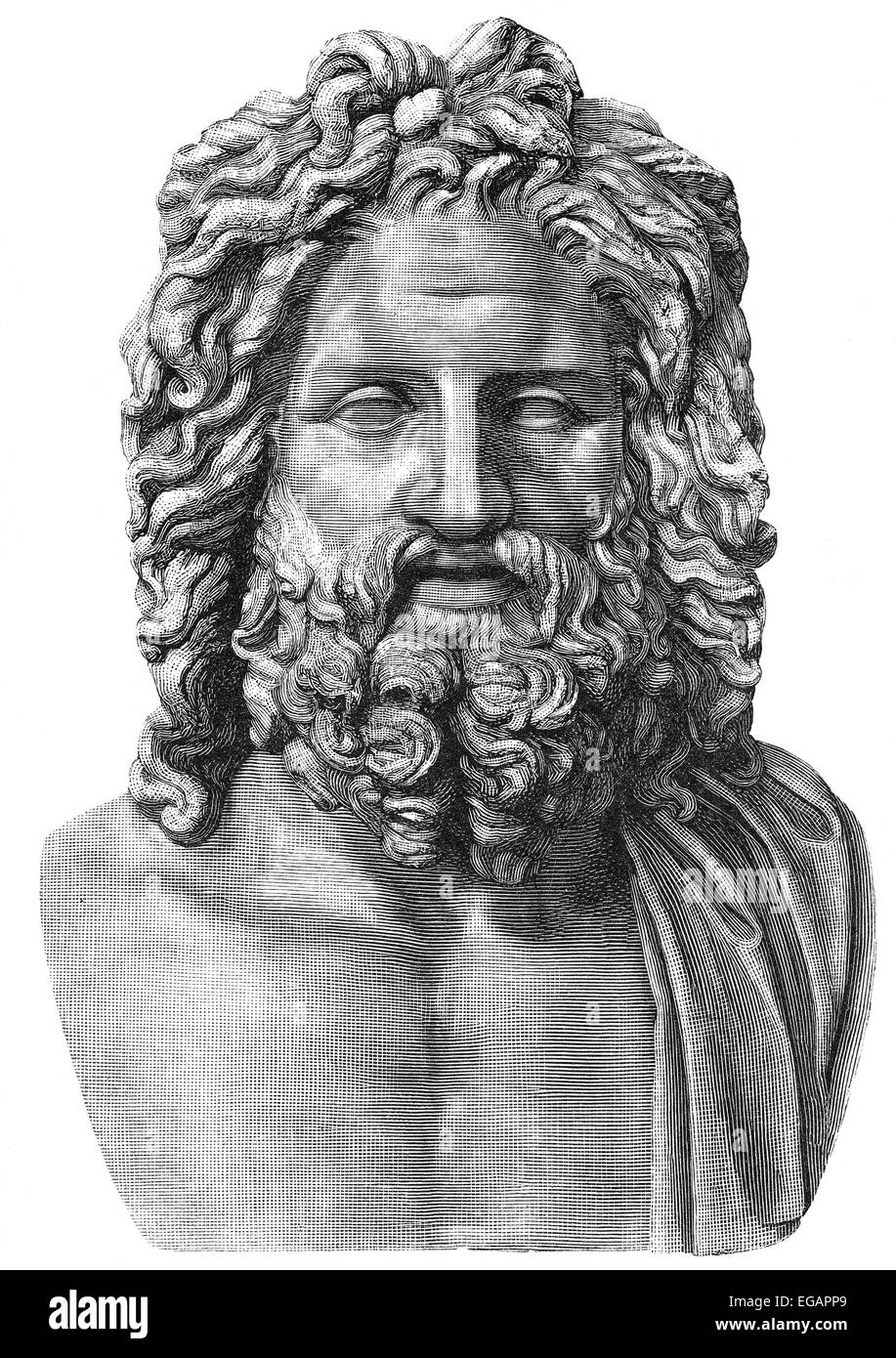 The Otricoli Zeus, 4th century, Vatican Museum, Stock Photohttps://www.alamy.com/image-license-details/?v=1https://www.alamy.com/stock-photo-the-otricoli-zeus-4th-century-vatican-museum-78913361.html
The Otricoli Zeus, 4th century, Vatican Museum, Stock Photohttps://www.alamy.com/image-license-details/?v=1https://www.alamy.com/stock-photo-the-otricoli-zeus-4th-century-vatican-museum-78913361.htmlRMEGAPP9–The Otricoli Zeus, 4th century, Vatican Museum,
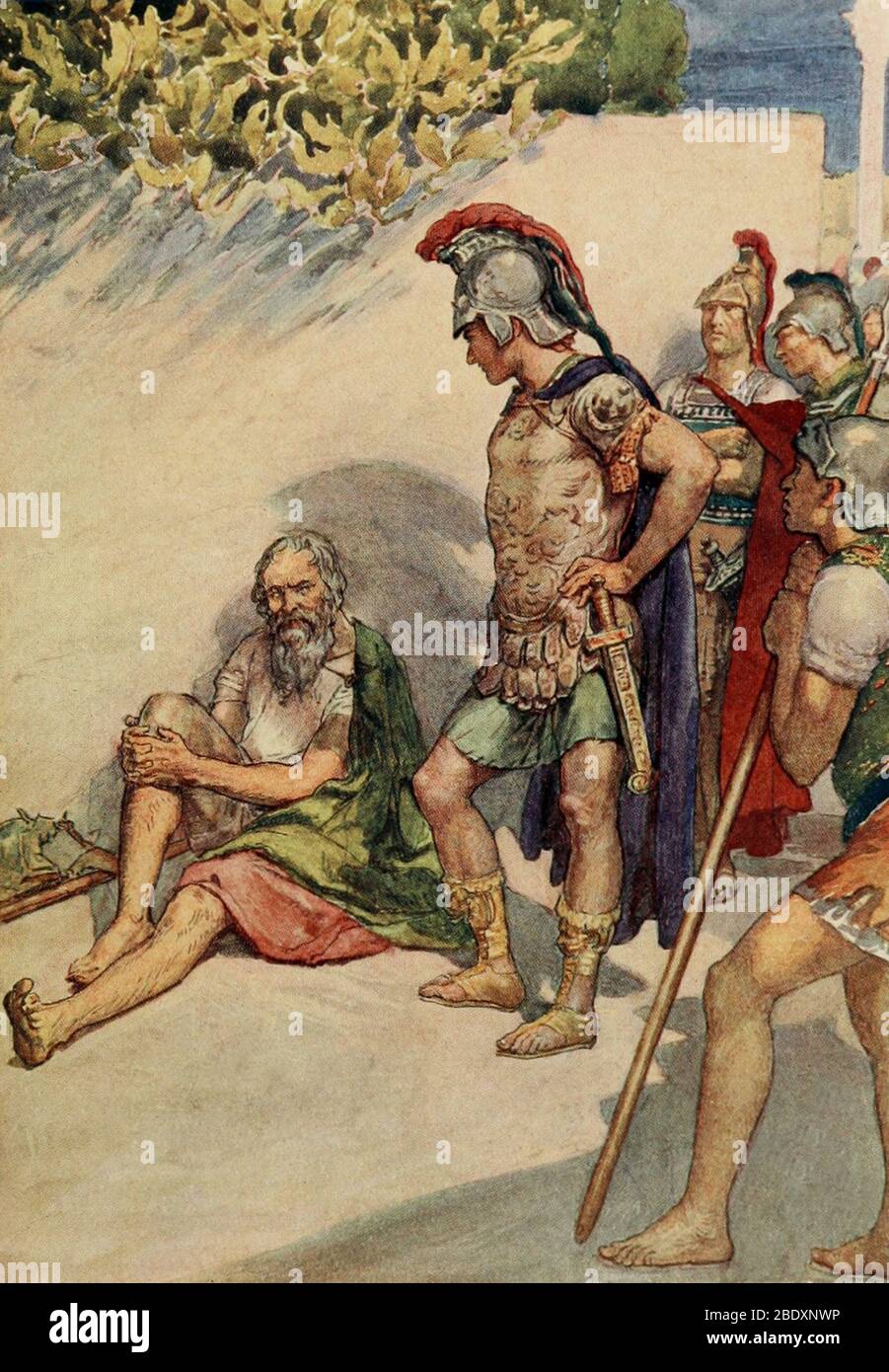 Diogenes and Alexander the Great, 4th Century BC Stock Photohttps://www.alamy.com/image-license-details/?v=1https://www.alamy.com/diogenes-and-alexander-the-great-4th-century-bc-image352785826.html
Diogenes and Alexander the Great, 4th Century BC Stock Photohttps://www.alamy.com/image-license-details/?v=1https://www.alamy.com/diogenes-and-alexander-the-great-4th-century-bc-image352785826.htmlRF2BDXNWP–Diogenes and Alexander the Great, 4th Century BC
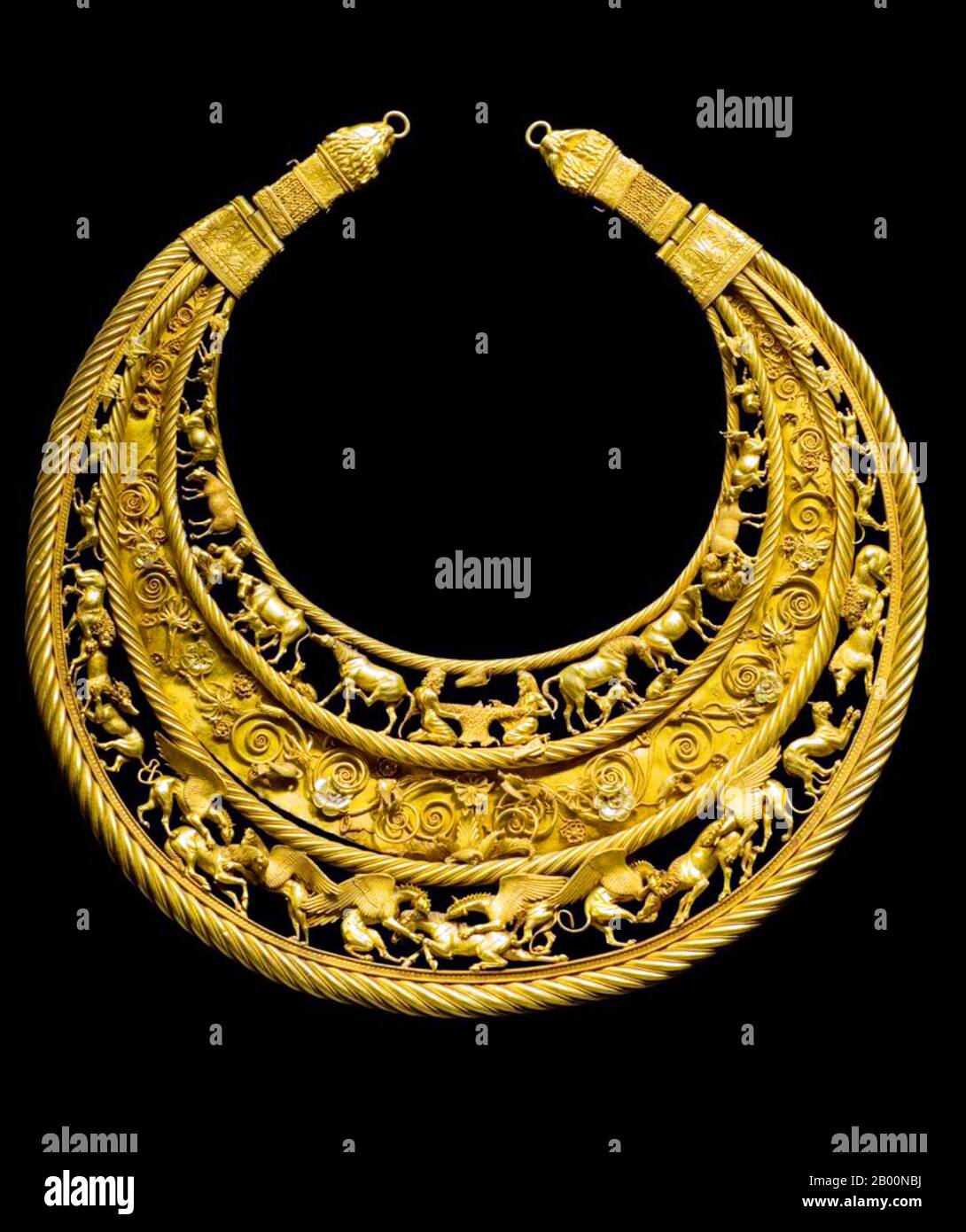 Ukraine: Scythian gold pectoral, 4th century BCE. Scythian golden pectoral from the royal grave at Tovsta Mohyla kurgan, 4th century BCE. It shows the three tiers of Scythian mythology: the Inner Earth, the Astral-Cosmic sphere and innermost the inhabited world. Museum of Historic Treasures of Ukraine, Kiev. Image released to the press in 2009. Stock Photohttps://www.alamy.com/image-license-details/?v=1https://www.alamy.com/ukraine-scythian-gold-pectoral-4th-century-bce-scythian-golden-pectoral-from-the-royal-grave-at-tovsta-mohyla-kurgan-4th-century-bce-it-shows-the-three-tiers-of-scythian-mythology-the-inner-earth-the-astral-cosmic-sphere-and-innermost-the-inhabited-world-museum-of-historic-treasures-of-ukraine-kiev-image-released-to-the-press-in-2009-image344224150.html
Ukraine: Scythian gold pectoral, 4th century BCE. Scythian golden pectoral from the royal grave at Tovsta Mohyla kurgan, 4th century BCE. It shows the three tiers of Scythian mythology: the Inner Earth, the Astral-Cosmic sphere and innermost the inhabited world. Museum of Historic Treasures of Ukraine, Kiev. Image released to the press in 2009. Stock Photohttps://www.alamy.com/image-license-details/?v=1https://www.alamy.com/ukraine-scythian-gold-pectoral-4th-century-bce-scythian-golden-pectoral-from-the-royal-grave-at-tovsta-mohyla-kurgan-4th-century-bce-it-shows-the-three-tiers-of-scythian-mythology-the-inner-earth-the-astral-cosmic-sphere-and-innermost-the-inhabited-world-museum-of-historic-treasures-of-ukraine-kiev-image-released-to-the-press-in-2009-image344224150.htmlRM2B00NBJ–Ukraine: Scythian gold pectoral, 4th century BCE. Scythian golden pectoral from the royal grave at Tovsta Mohyla kurgan, 4th century BCE. It shows the three tiers of Scythian mythology: the Inner Earth, the Astral-Cosmic sphere and innermost the inhabited world. Museum of Historic Treasures of Ukraine, Kiev. Image released to the press in 2009.
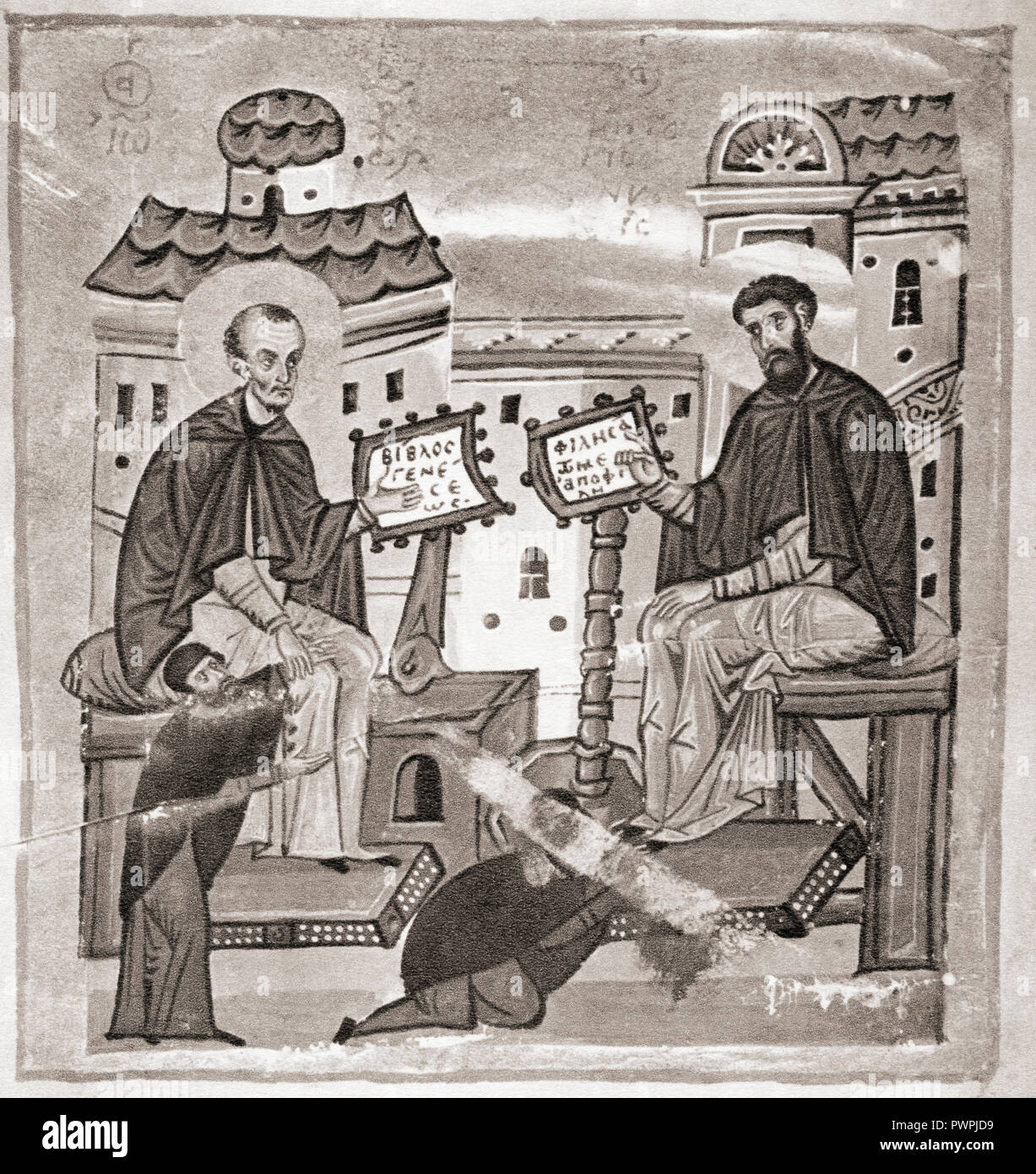 Gregory of Nyssa, aka Gregory Nyssen, right, c. 335 – c. 395. 4th century bishop of Nyssa. After an 11th century MS. Stock Photohttps://www.alamy.com/image-license-details/?v=1https://www.alamy.com/gregory-of-nyssa-aka-gregory-nyssen-right-c-335-c-395-4th-century-bishop-of-nyssa-after-an-11th-century-ms-image222388245.html
Gregory of Nyssa, aka Gregory Nyssen, right, c. 335 – c. 395. 4th century bishop of Nyssa. After an 11th century MS. Stock Photohttps://www.alamy.com/image-license-details/?v=1https://www.alamy.com/gregory-of-nyssa-aka-gregory-nyssen-right-c-335-c-395-4th-century-bishop-of-nyssa-after-an-11th-century-ms-image222388245.htmlRMPWPJD9–Gregory of Nyssa, aka Gregory Nyssen, right, c. 335 – c. 395. 4th century bishop of Nyssa. After an 11th century MS.
 Racing in Roman Lincolnshire. This 4th century mosaic from Horkstow almost certainly depicts racing, since only one man stands in each chariot. In battle an archer or spearman would be beside him, if the Romano-British still used war-chariots, itself most doubtful. The saddled horse being led by his reins has a distinctly Arab look, which lends a small amount of colour to the tradition that the Romans imported specialised racehorses to Britain. The History of Horse Racing by Roger Longrigg, page 21. Stock Photohttps://www.alamy.com/image-license-details/?v=1https://www.alamy.com/racing-in-roman-lincolnshire-this-4th-century-mosaic-from-horkstow-almost-certainly-depicts-racing-since-only-one-man-stands-in-each-chariot-in-battle-an-archer-or-spearman-would-be-beside-him-if-the-romano-british-still-used-war-chariots-itself-most-doubtful-the-saddled-horse-being-led-by-his-reins-has-a-distinctly-arab-look-which-lends-a-small-amount-of-colour-to-the-tradition-that-the-romans-imported-specialised-racehorses-to-britain-the-history-of-horse-racing-by-roger-longrigg-page-21-image268794340.html
Racing in Roman Lincolnshire. This 4th century mosaic from Horkstow almost certainly depicts racing, since only one man stands in each chariot. In battle an archer or spearman would be beside him, if the Romano-British still used war-chariots, itself most doubtful. The saddled horse being led by his reins has a distinctly Arab look, which lends a small amount of colour to the tradition that the Romans imported specialised racehorses to Britain. The History of Horse Racing by Roger Longrigg, page 21. Stock Photohttps://www.alamy.com/image-license-details/?v=1https://www.alamy.com/racing-in-roman-lincolnshire-this-4th-century-mosaic-from-horkstow-almost-certainly-depicts-racing-since-only-one-man-stands-in-each-chariot-in-battle-an-archer-or-spearman-would-be-beside-him-if-the-romano-british-still-used-war-chariots-itself-most-doubtful-the-saddled-horse-being-led-by-his-reins-has-a-distinctly-arab-look-which-lends-a-small-amount-of-colour-to-the-tradition-that-the-romans-imported-specialised-racehorses-to-britain-the-history-of-horse-racing-by-roger-longrigg-page-21-image268794340.htmlRMWH8HWT–Racing in Roman Lincolnshire. This 4th century mosaic from Horkstow almost certainly depicts racing, since only one man stands in each chariot. In battle an archer or spearman would be beside him, if the Romano-British still used war-chariots, itself most doubtful. The saddled horse being led by his reins has a distinctly Arab look, which lends a small amount of colour to the tradition that the Romans imported specialised racehorses to Britain. The History of Horse Racing by Roger Longrigg, page 21.
 Pompeii. Nocera Gate (4th century BC) and Via Nocera. La Campania. Italy. Stock Photohttps://www.alamy.com/image-license-details/?v=1https://www.alamy.com/pompeii-nocera-gate-4th-century-bc-and-via-nocera-la-campania-italy-image222281324.html
Pompeii. Nocera Gate (4th century BC) and Via Nocera. La Campania. Italy. Stock Photohttps://www.alamy.com/image-license-details/?v=1https://www.alamy.com/pompeii-nocera-gate-4th-century-bc-and-via-nocera-la-campania-italy-image222281324.htmlRMPWHP2M–Pompeii. Nocera Gate (4th century BC) and Via Nocera. La Campania. Italy.
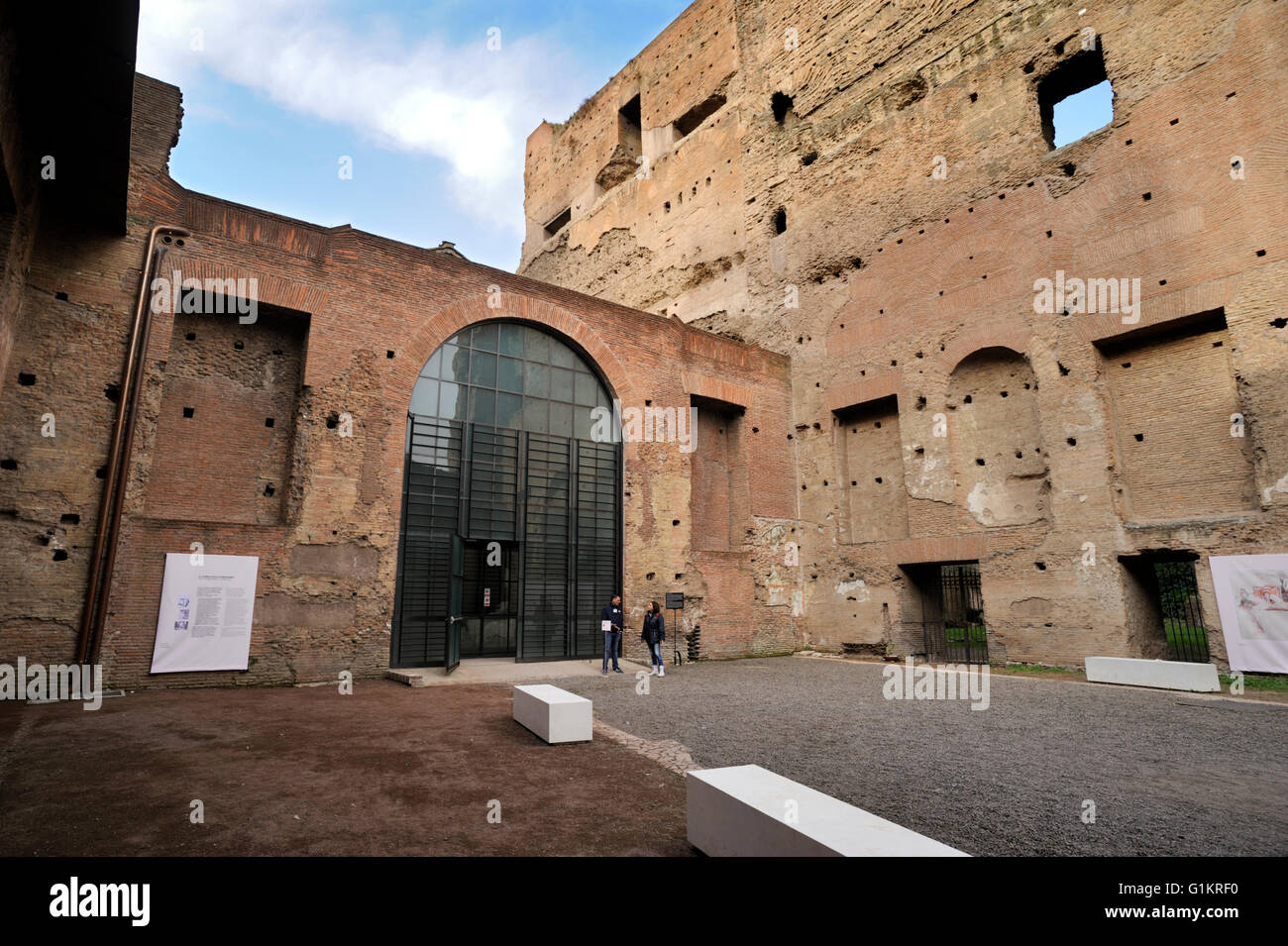 Early Christian church of Santa Maria Antiqua (4th century AD) and West Aula, called Temple of Augustus, Roman Forum, Rome, Italy Stock Photohttps://www.alamy.com/image-license-details/?v=1https://www.alamy.com/stock-photo-early-christian-church-of-santa-maria-antiqua-4th-century-ad-and-west-104312404.html
Early Christian church of Santa Maria Antiqua (4th century AD) and West Aula, called Temple of Augustus, Roman Forum, Rome, Italy Stock Photohttps://www.alamy.com/image-license-details/?v=1https://www.alamy.com/stock-photo-early-christian-church-of-santa-maria-antiqua-4th-century-ad-and-west-104312404.htmlRMG1KRF0–Early Christian church of Santa Maria Antiqua (4th century AD) and West Aula, called Temple of Augustus, Roman Forum, Rome, Italy
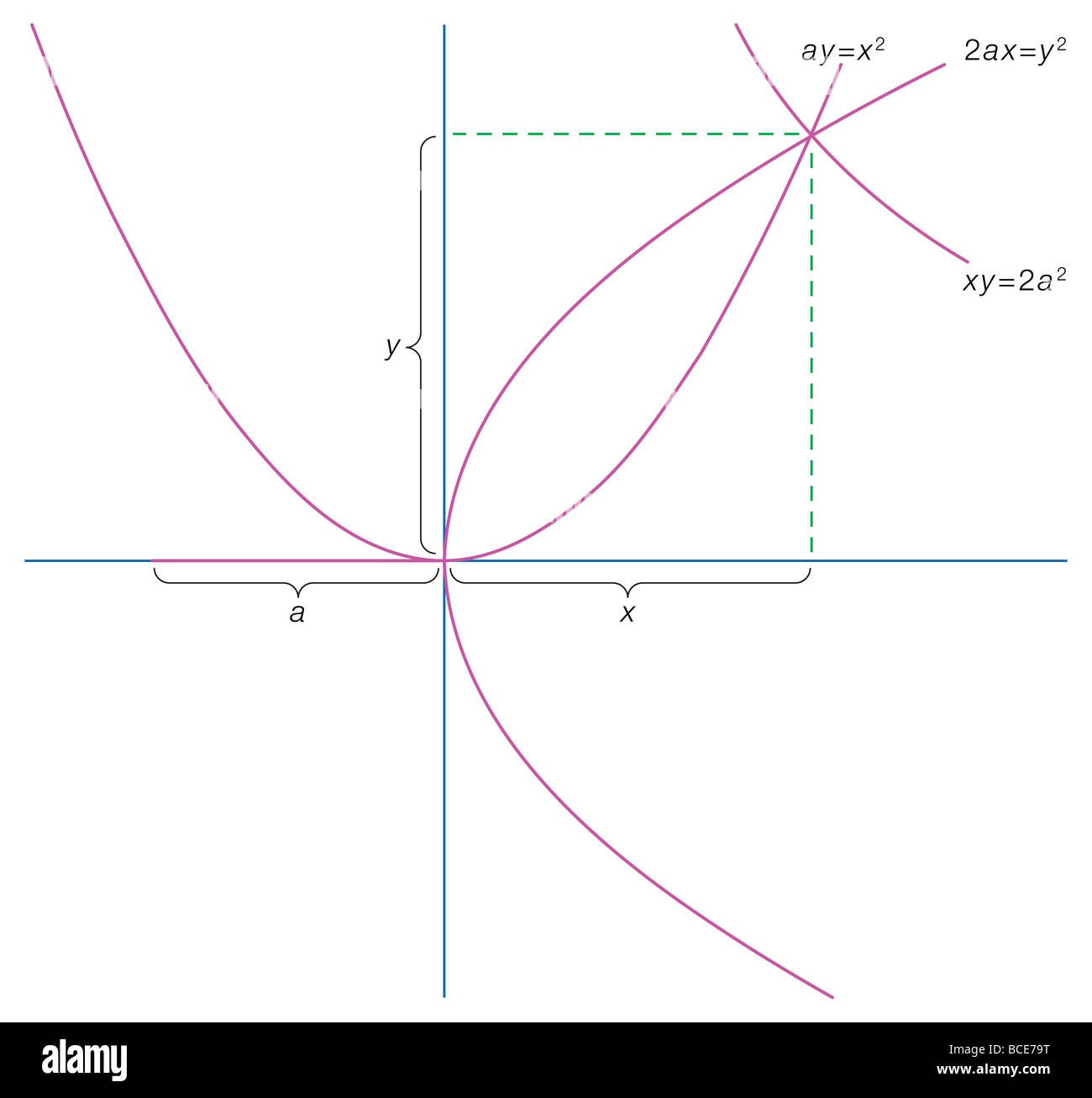 The solution to the problem of doubling the volume of a cube, as proposed by Menaechmus in the 4th century BC. Stock Photohttps://www.alamy.com/image-license-details/?v=1https://www.alamy.com/stock-photo-the-solution-to-the-problem-of-doubling-the-volume-of-a-cube-as-proposed-24899332.html
The solution to the problem of doubling the volume of a cube, as proposed by Menaechmus in the 4th century BC. Stock Photohttps://www.alamy.com/image-license-details/?v=1https://www.alamy.com/stock-photo-the-solution-to-the-problem-of-doubling-the-volume-of-a-cube-as-proposed-24899332.htmlRMBCE79T–The solution to the problem of doubling the volume of a cube, as proposed by Menaechmus in the 4th century BC.
 Archaeologist's at the Museum of London unveil an extremely rare stone sarcophagus at the Spitalfield excavation site in the City of London. An exceptionally well-preserved skeleton was revealed dating from the first half of the 4th century AD. * The skeleton is of a young woman in her early 20's of late Roman London. Stock Photohttps://www.alamy.com/image-license-details/?v=1https://www.alamy.com/stock-photo-archaeologists-at-the-museum-of-london-unveil-an-extremely-rare-stone-106133972.html
Archaeologist's at the Museum of London unveil an extremely rare stone sarcophagus at the Spitalfield excavation site in the City of London. An exceptionally well-preserved skeleton was revealed dating from the first half of the 4th century AD. * The skeleton is of a young woman in her early 20's of late Roman London. Stock Photohttps://www.alamy.com/image-license-details/?v=1https://www.alamy.com/stock-photo-archaeologists-at-the-museum-of-london-unveil-an-extremely-rare-stone-106133972.htmlRMG4JPY0–Archaeologist's at the Museum of London unveil an extremely rare stone sarcophagus at the Spitalfield excavation site in the City of London. An exceptionally well-preserved skeleton was revealed dating from the first half of the 4th century AD. * The skeleton is of a young woman in her early 20's of late Roman London.
 An Athenian trireme Date: circa 4th century BC Stock Photohttps://www.alamy.com/image-license-details/?v=1https://www.alamy.com/stock-photo-an-athenian-trireme-date-circa-4th-century-bc-105287631.html
An Athenian trireme Date: circa 4th century BC Stock Photohttps://www.alamy.com/image-license-details/?v=1https://www.alamy.com/stock-photo-an-athenian-trireme-date-circa-4th-century-bc-105287631.htmlRMG387CF–An Athenian trireme Date: circa 4th century BC
 Illustration of the Martyrdom of Cassianus in the 4th Century Italy Cassianus was a Teacher and Headmaster he was Persecuted for being a Christian and Stock Photohttps://www.alamy.com/image-license-details/?v=1https://www.alamy.com/illustration-of-the-martyrdom-of-cassianus-in-the-4th-century-italy-cassianus-was-a-teacher-and-headmaster-he-was-persecuted-for-being-a-christian-and-image629107709.html
Illustration of the Martyrdom of Cassianus in the 4th Century Italy Cassianus was a Teacher and Headmaster he was Persecuted for being a Christian and Stock Photohttps://www.alamy.com/image-license-details/?v=1https://www.alamy.com/illustration-of-the-martyrdom-of-cassianus-in-the-4th-century-italy-cassianus-was-a-teacher-and-headmaster-he-was-persecuted-for-being-a-christian-and-image629107709.htmlRM2YFE98D–Illustration of the Martyrdom of Cassianus in the 4th Century Italy Cassianus was a Teacher and Headmaster he was Persecuted for being a Christian and
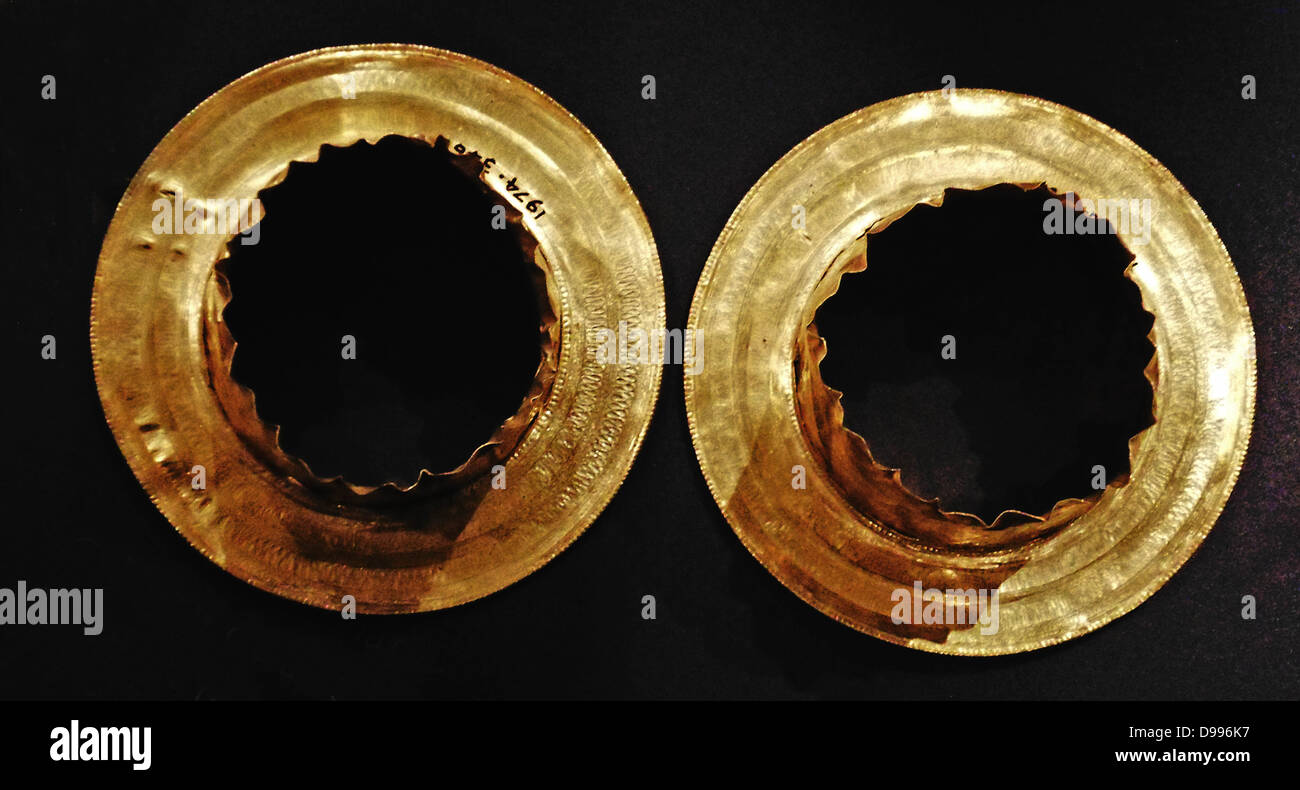 Gold hair ornaments 5th - 4th Century BC. Greek. Stock Photohttps://www.alamy.com/image-license-details/?v=1https://www.alamy.com/stock-photo-gold-hair-ornaments-5th-4th-century-bc-greek-57365819.html
Gold hair ornaments 5th - 4th Century BC. Greek. Stock Photohttps://www.alamy.com/image-license-details/?v=1https://www.alamy.com/stock-photo-gold-hair-ornaments-5th-4th-century-bc-greek-57365819.htmlRMD996K7–Gold hair ornaments 5th - 4th Century BC. Greek.
 4th century B.C Stock Photohttps://www.alamy.com/image-license-details/?v=1https://www.alamy.com/4th-century-bc-image261261804.html
4th century B.C Stock Photohttps://www.alamy.com/image-license-details/?v=1https://www.alamy.com/4th-century-bc-image261261804.htmlRMW51E2M–4th century B.C
 4TH CENTURY EUROPE: The Roman Empire (Eastern & Western) . COLLINS, 1880 map Stock Photohttps://www.alamy.com/image-license-details/?v=1https://www.alamy.com/stock-photo-4th-century-europe-the-roman-empire-eastern-western-collins-1880-map-110410212.html
4TH CENTURY EUROPE: The Roman Empire (Eastern & Western) . COLLINS, 1880 map Stock Photohttps://www.alamy.com/image-license-details/?v=1https://www.alamy.com/stock-photo-4th-century-europe-the-roman-empire-eastern-western-collins-1880-map-110410212.htmlRFGBHH9T–4TH CENTURY EUROPE: The Roman Empire (Eastern & Western) . COLLINS, 1880 map
 fine arts, Coptic fine arts, textiles, palmette, 3rd / 4th century, woven, Swabian textile museum, ARTIST'S COPYRIGHT HAS NOT TO BE CLEARED Stock Photohttps://www.alamy.com/image-license-details/?v=1https://www.alamy.com/fine-arts-coptic-fine-arts-textiles-palmette-3rd-4th-century-woven-swabian-textile-museum-artists-copyright-has-not-to-be-cleared-image612586613.html
fine arts, Coptic fine arts, textiles, palmette, 3rd / 4th century, woven, Swabian textile museum, ARTIST'S COPYRIGHT HAS NOT TO BE CLEARED Stock Photohttps://www.alamy.com/image-license-details/?v=1https://www.alamy.com/fine-arts-coptic-fine-arts-textiles-palmette-3rd-4th-century-woven-swabian-textile-museum-artists-copyright-has-not-to-be-cleared-image612586613.htmlRM2XGHMD9–fine arts, Coptic fine arts, textiles, palmette, 3rd / 4th century, woven, Swabian textile museum, ARTIST'S COPYRIGHT HAS NOT TO BE CLEARED
 Greece. Delphi. Stadium. Second half of the 4th century B.C. Stock Photohttps://www.alamy.com/image-license-details/?v=1https://www.alamy.com/greece-delphi-stadium-second-half-of-the-4th-century-bc-image630881891.html
Greece. Delphi. Stadium. Second half of the 4th century B.C. Stock Photohttps://www.alamy.com/image-license-details/?v=1https://www.alamy.com/greece-delphi-stadium-second-half-of-the-4th-century-bc-image630881891.htmlRM2YJB483–Greece. Delphi. Stadium. Second half of the 4th century B.C.
 Hercules at Rest - The Farnese Hercules 216 AD (4th century BC for original) National Archaeological Museum of Naples Italy. Stock Photohttps://www.alamy.com/image-license-details/?v=1https://www.alamy.com/hercules-at-rest-the-farnese-hercules-216-ad-4th-century-bc-for-original-national-archaeological-museum-of-naples-italy-image571026441.html
Hercules at Rest - The Farnese Hercules 216 AD (4th century BC for original) National Archaeological Museum of Naples Italy. Stock Photohttps://www.alamy.com/image-license-details/?v=1https://www.alamy.com/hercules-at-rest-the-farnese-hercules-216-ad-4th-century-bc-for-original-national-archaeological-museum-of-naples-italy-image571026441.htmlRM2T50E1D–Hercules at Rest - The Farnese Hercules 216 AD (4th century BC for original) National Archaeological Museum of Naples Italy.
 This photo of a mosaic showing a small hunting scene sacrificing to Artemis, the g oddess of the hunt (also known as Diana) was taken in the summer of 1970 at Piazza Armerina in Sicily. Piazza Armerina is home to the Roman Villa del Casale and its famous mosaics, the 'finest mosaics in situ anywhere in the Roman world,' as described by UNESCO, which inserted it into its World Heritage list in 1997. Villa Romana was a lavish patrician residence built at the center of a huge latifundium (agricultural estate) at the end of the 4th century AD. It is thought to have belonged to a member of the Roma Stock Photohttps://www.alamy.com/image-license-details/?v=1https://www.alamy.com/this-photo-of-a-mosaic-showing-a-small-hunting-scene-sacrificing-to-artemis-the-g-oddess-of-the-hunt-also-known-as-diana-was-taken-in-the-summer-of-1970-at-piazza-armerina-in-sicily-piazza-armerina-is-home-to-the-roman-villa-del-casale-and-its-famous-mosaics-the-finest-mosaics-in-situ-anywhere-in-the-roman-world-as-described-by-unesco-which-inserted-it-into-its-world-heritage-list-in-1997-villa-romana-was-a-lavish-patrician-residence-built-at-the-center-of-a-huge-latifundium-agricultural-estate-at-the-end-of-the-4th-century-ad-it-is-thought-to-have-belonged-to-a-member-of-the-roma-image557837221.html
This photo of a mosaic showing a small hunting scene sacrificing to Artemis, the g oddess of the hunt (also known as Diana) was taken in the summer of 1970 at Piazza Armerina in Sicily. Piazza Armerina is home to the Roman Villa del Casale and its famous mosaics, the 'finest mosaics in situ anywhere in the Roman world,' as described by UNESCO, which inserted it into its World Heritage list in 1997. Villa Romana was a lavish patrician residence built at the center of a huge latifundium (agricultural estate) at the end of the 4th century AD. It is thought to have belonged to a member of the Roma Stock Photohttps://www.alamy.com/image-license-details/?v=1https://www.alamy.com/this-photo-of-a-mosaic-showing-a-small-hunting-scene-sacrificing-to-artemis-the-g-oddess-of-the-hunt-also-known-as-diana-was-taken-in-the-summer-of-1970-at-piazza-armerina-in-sicily-piazza-armerina-is-home-to-the-roman-villa-del-casale-and-its-famous-mosaics-the-finest-mosaics-in-situ-anywhere-in-the-roman-world-as-described-by-unesco-which-inserted-it-into-its-world-heritage-list-in-1997-villa-romana-was-a-lavish-patrician-residence-built-at-the-center-of-a-huge-latifundium-agricultural-estate-at-the-end-of-the-4th-century-ad-it-is-thought-to-have-belonged-to-a-member-of-the-roma-image557837221.htmlRF2RBFK1W–This photo of a mosaic showing a small hunting scene sacrificing to Artemis, the g oddess of the hunt (also known as Diana) was taken in the summer of 1970 at Piazza Armerina in Sicily. Piazza Armerina is home to the Roman Villa del Casale and its famous mosaics, the 'finest mosaics in situ anywhere in the Roman world,' as described by UNESCO, which inserted it into its World Heritage list in 1997. Villa Romana was a lavish patrician residence built at the center of a huge latifundium (agricultural estate) at the end of the 4th century AD. It is thought to have belonged to a member of the Roma
 4th Century Battle of Alexander the Great, From a mosaic found in Pompeii, Italy. Stock Photohttps://www.alamy.com/image-license-details/?v=1https://www.alamy.com/stock-photo-4th-century-battle-of-alexander-the-great-from-a-mosaic-found-in-pompeii-103891864.html
4th Century Battle of Alexander the Great, From a mosaic found in Pompeii, Italy. Stock Photohttps://www.alamy.com/image-license-details/?v=1https://www.alamy.com/stock-photo-4th-century-battle-of-alexander-the-great-from-a-mosaic-found-in-pompeii-103891864.htmlRMG10K3M–4th Century Battle of Alexander the Great, From a mosaic found in Pompeii, Italy.
 Silver Gate, historic 4th century entrance to Diocletian's Palace, Split, Croatia Stock Photohttps://www.alamy.com/image-license-details/?v=1https://www.alamy.com/silver-gate-historic-4th-century-entrance-to-diocletians-palace-split-croatia-image622210021.html
Silver Gate, historic 4th century entrance to Diocletian's Palace, Split, Croatia Stock Photohttps://www.alamy.com/image-license-details/?v=1https://www.alamy.com/silver-gate-historic-4th-century-entrance-to-diocletians-palace-split-croatia-image622210021.htmlRM2Y4836D–Silver Gate, historic 4th century entrance to Diocletian's Palace, Split, Croatia
 Rider and Two Horses Toy, 4th Century AD Stock Photohttps://www.alamy.com/image-license-details/?v=1https://www.alamy.com/rider-and-two-horses-toy-4th-century-ad-image352795410.html
Rider and Two Horses Toy, 4th Century AD Stock Photohttps://www.alamy.com/image-license-details/?v=1https://www.alamy.com/rider-and-two-horses-toy-4th-century-ad-image352795410.htmlRM2BDY642–Rider and Two Horses Toy, 4th Century AD
 Ukraine: Gold Scythian bed hangings, 4th century BCE. Museum of Historical Treasures of Ukraine, Kiev. Image released to the press in 2009. The Scythians were an ancient Iranian people of horse-riding nomadic pastoralists who throughout Classical Antiquity dominated the Pontic-Caspian steppe, known at the time as Scythia. By Late Antiquity the closely-related Sarmatians came to dominate the Scythians in the west. Stock Photohttps://www.alamy.com/image-license-details/?v=1https://www.alamy.com/ukraine-gold-scythian-bed-hangings-4th-century-bce-museum-of-historical-treasures-of-ukraine-kiev-image-released-to-the-press-in-2009-the-scythians-were-an-ancient-iranian-people-of-horse-riding-nomadic-pastoralists-who-throughout-classical-antiquity-dominated-the-pontic-caspian-steppe-known-at-the-time-as-scythia-by-late-antiquity-the-closely-related-sarmatians-came-to-dominate-the-scythians-in-the-west-image344227706.html
Ukraine: Gold Scythian bed hangings, 4th century BCE. Museum of Historical Treasures of Ukraine, Kiev. Image released to the press in 2009. The Scythians were an ancient Iranian people of horse-riding nomadic pastoralists who throughout Classical Antiquity dominated the Pontic-Caspian steppe, known at the time as Scythia. By Late Antiquity the closely-related Sarmatians came to dominate the Scythians in the west. Stock Photohttps://www.alamy.com/image-license-details/?v=1https://www.alamy.com/ukraine-gold-scythian-bed-hangings-4th-century-bce-museum-of-historical-treasures-of-ukraine-kiev-image-released-to-the-press-in-2009-the-scythians-were-an-ancient-iranian-people-of-horse-riding-nomadic-pastoralists-who-throughout-classical-antiquity-dominated-the-pontic-caspian-steppe-known-at-the-time-as-scythia-by-late-antiquity-the-closely-related-sarmatians-came-to-dominate-the-scythians-in-the-west-image344227706.htmlRM2B00WXJ–Ukraine: Gold Scythian bed hangings, 4th century BCE. Museum of Historical Treasures of Ukraine, Kiev. Image released to the press in 2009. The Scythians were an ancient Iranian people of horse-riding nomadic pastoralists who throughout Classical Antiquity dominated the Pontic-Caspian steppe, known at the time as Scythia. By Late Antiquity the closely-related Sarmatians came to dominate the Scythians in the west.
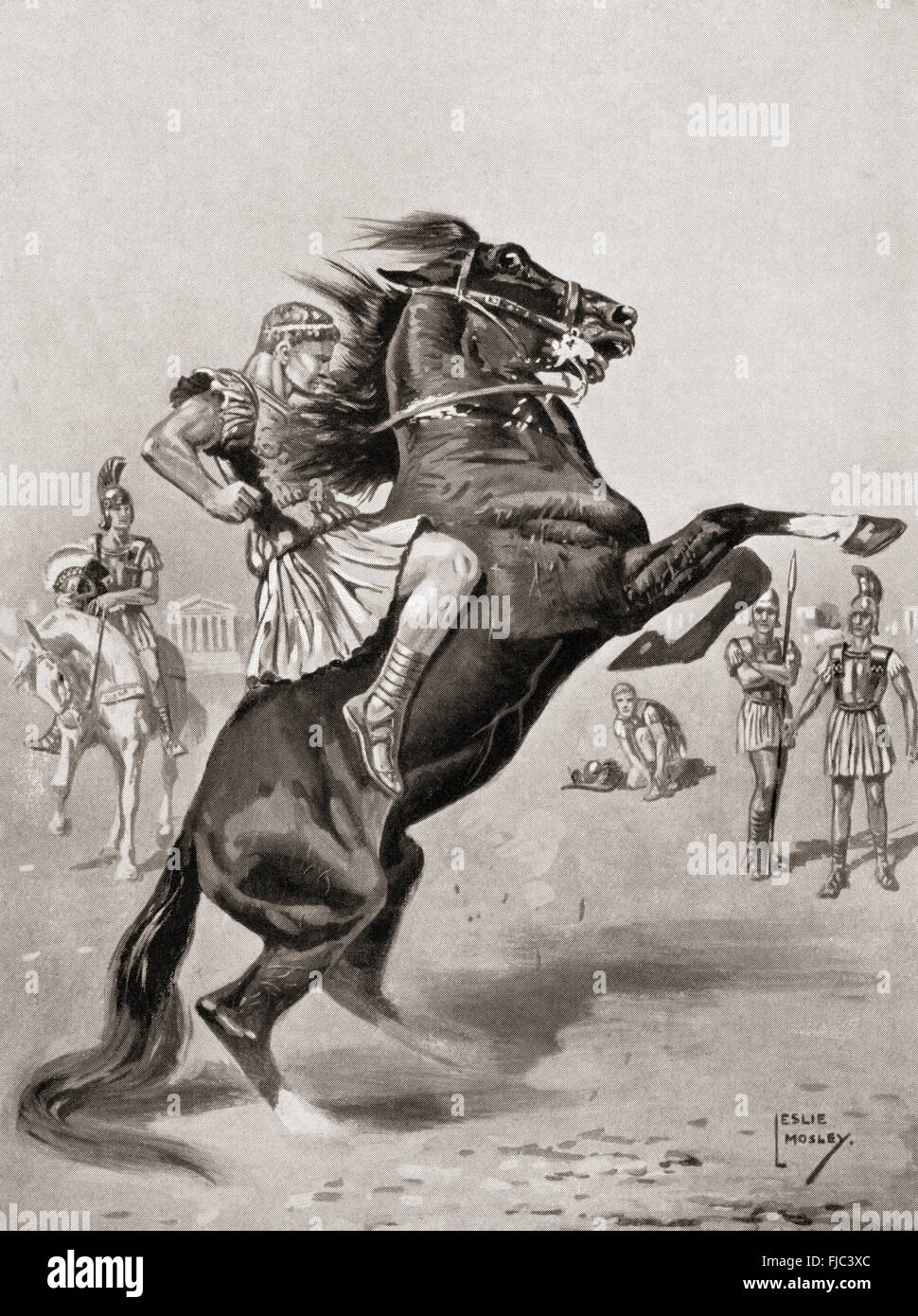 The taming of Bucephalus by Alexander the Great, 4th century BC. Alexander III of Macedon, 356 BC – 323 BC, commonly known as Alexander the Great. Stock Photohttps://www.alamy.com/image-license-details/?v=1https://www.alamy.com/stock-photo-the-taming-of-bucephalus-by-alexander-the-great-4th-century-bc-alexander-97382164.html
The taming of Bucephalus by Alexander the Great, 4th century BC. Alexander III of Macedon, 356 BC – 323 BC, commonly known as Alexander the Great. Stock Photohttps://www.alamy.com/image-license-details/?v=1https://www.alamy.com/stock-photo-the-taming-of-bucephalus-by-alexander-the-great-4th-century-bc-alexander-97382164.htmlRMFJC3XC–The taming of Bucephalus by Alexander the Great, 4th century BC. Alexander III of Macedon, 356 BC – 323 BC, commonly known as Alexander the Great.
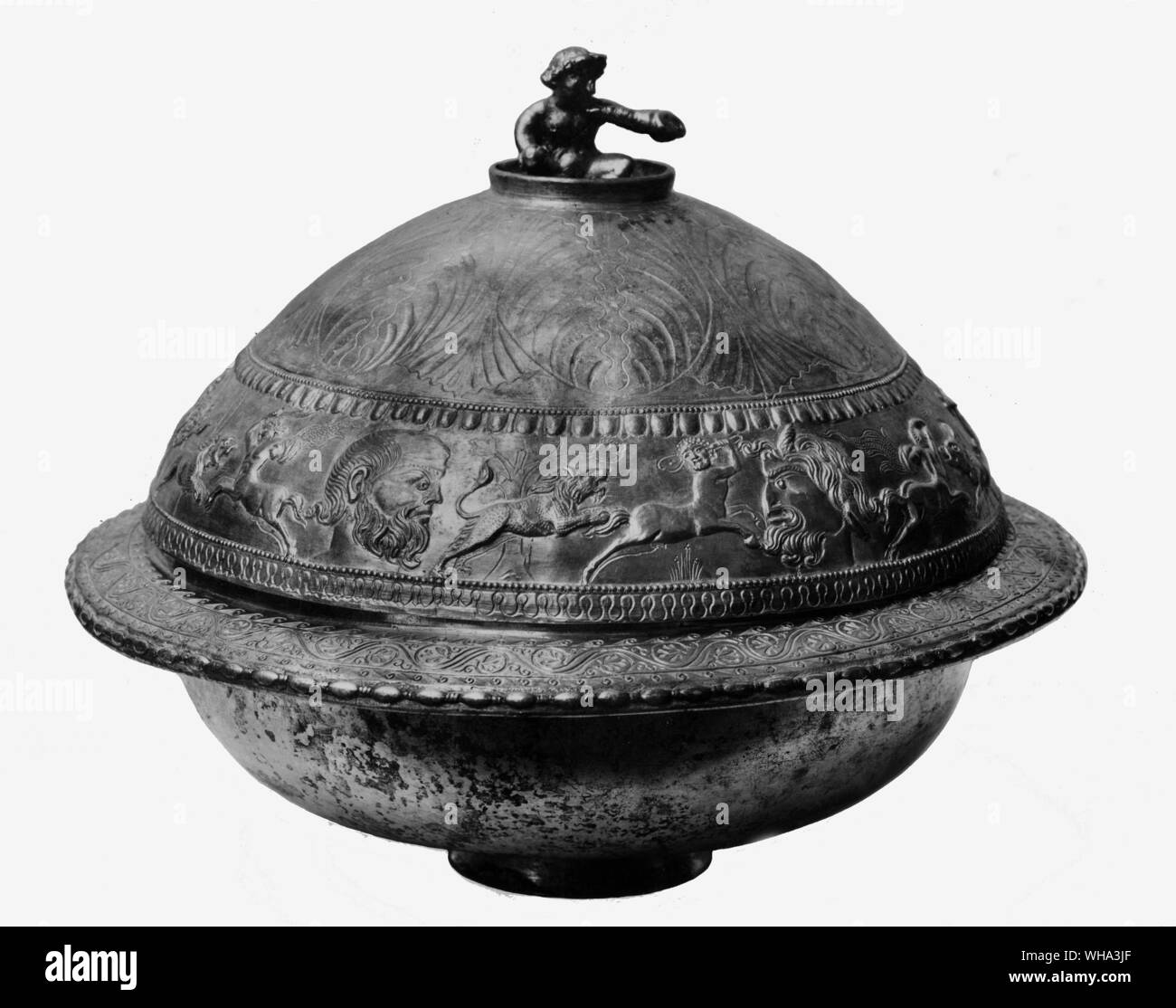 Mildenhall Treasure. Bowl. Probably early 4th century. Stock Photohttps://www.alamy.com/image-license-details/?v=1https://www.alamy.com/mildenhall-treasure-bowl-probably-early-4th-century-image268827063.html
Mildenhall Treasure. Bowl. Probably early 4th century. Stock Photohttps://www.alamy.com/image-license-details/?v=1https://www.alamy.com/mildenhall-treasure-bowl-probably-early-4th-century-image268827063.htmlRMWHA3JF–Mildenhall Treasure. Bowl. Probably early 4th century.
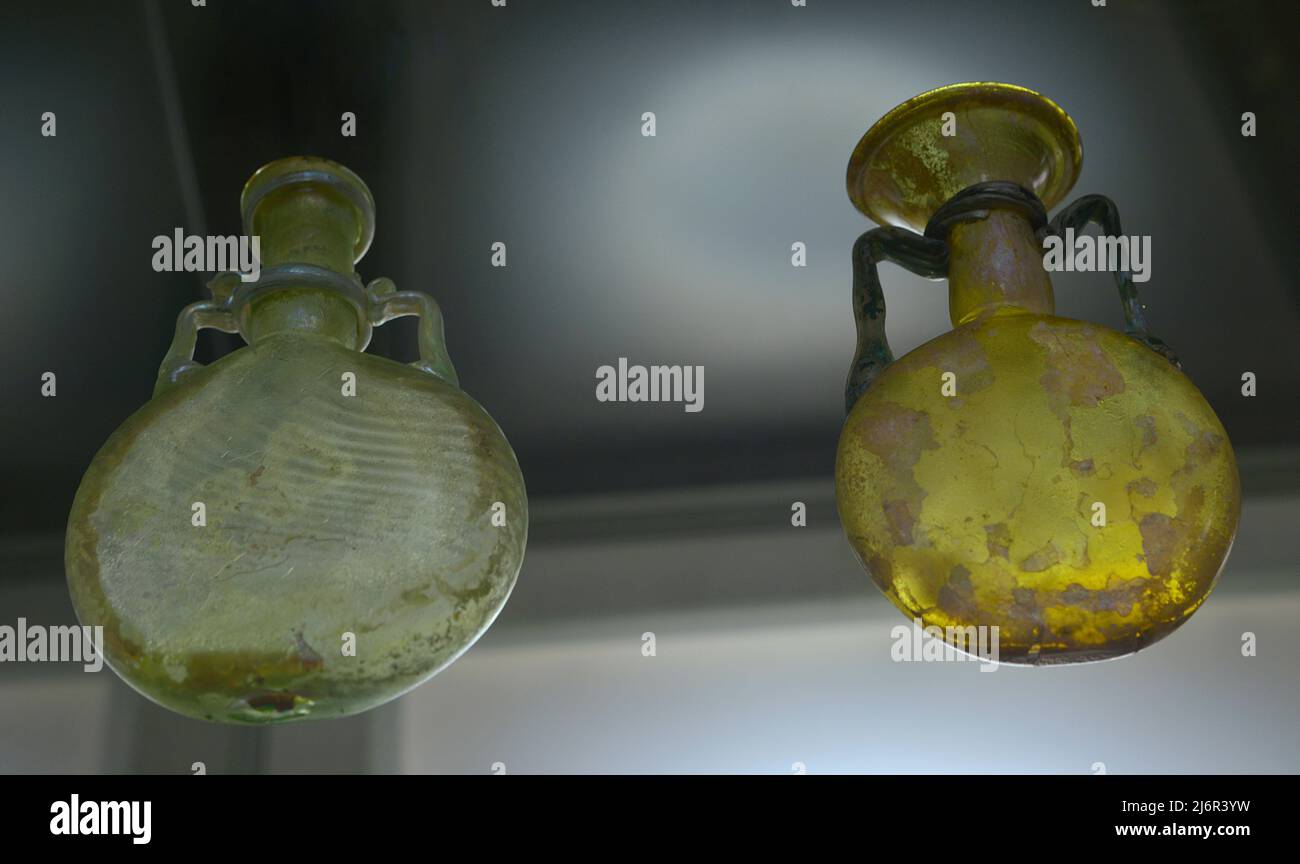 Roman glasses. Left: 3rd-4th centuries. Right: 4th century. Calouste Gulbenkian Museum. Lisbon, Portugal. Stock Photohttps://www.alamy.com/image-license-details/?v=1https://www.alamy.com/roman-glasses-left-3rd-4th-centuries-right-4th-century-calouste-gulbenkian-museum-lisbon-portugal-image468875901.html
Roman glasses. Left: 3rd-4th centuries. Right: 4th century. Calouste Gulbenkian Museum. Lisbon, Portugal. Stock Photohttps://www.alamy.com/image-license-details/?v=1https://www.alamy.com/roman-glasses-left-3rd-4th-centuries-right-4th-century-calouste-gulbenkian-museum-lisbon-portugal-image468875901.htmlRM2J6R3YW–Roman glasses. Left: 3rd-4th centuries. Right: 4th century. Calouste Gulbenkian Museum. Lisbon, Portugal.
 Dionysos, god of wine, 4th century carving, Lemesos Castle Stock Photohttps://www.alamy.com/image-license-details/?v=1https://www.alamy.com/stock-photo-dionysos-god-of-wine-4th-century-carving-lemesos-castle-36750061.html
Dionysos, god of wine, 4th century carving, Lemesos Castle Stock Photohttps://www.alamy.com/image-license-details/?v=1https://www.alamy.com/stock-photo-dionysos-god-of-wine-4th-century-carving-lemesos-castle-36750061.htmlRMC3P325–Dionysos, god of wine, 4th century carving, Lemesos Castle
 Remains of a Roman road, 4th century AC Stock Photohttps://www.alamy.com/image-license-details/?v=1https://www.alamy.com/stock-image-remains-of-a-roman-road-4th-century-ac-163707165.html
Remains of a Roman road, 4th century AC Stock Photohttps://www.alamy.com/image-license-details/?v=1https://www.alamy.com/stock-image-remains-of-a-roman-road-4th-century-ac-163707165.htmlRMKE9E4D–Remains of a Roman road, 4th century AC
 Albania, Ballsh, ruins of the Illyrian city of Byllis, 4th century BC Stock Photohttps://www.alamy.com/image-license-details/?v=1https://www.alamy.com/albania-ballsh-ruins-of-the-illyrian-city-of-byllis-4th-century-bc-image259640967.html
Albania, Ballsh, ruins of the Illyrian city of Byllis, 4th century BC Stock Photohttps://www.alamy.com/image-license-details/?v=1https://www.alamy.com/albania-ballsh-ruins-of-the-illyrian-city-of-byllis-4th-century-bc-image259640967.htmlRMW2BJKK–Albania, Ballsh, ruins of the Illyrian city of Byllis, 4th century BC
 Thessaloniki - The 4th century Triumphal Arch of Galerius Stock Photohttps://www.alamy.com/image-license-details/?v=1https://www.alamy.com/stock-photo-thessaloniki-the-4th-century-triumphal-arch-of-galerius-105372651.html
Thessaloniki - The 4th century Triumphal Arch of Galerius Stock Photohttps://www.alamy.com/image-license-details/?v=1https://www.alamy.com/stock-photo-thessaloniki-the-4th-century-triumphal-arch-of-galerius-105372651.htmlRMG3C3TY–Thessaloniki - The 4th century Triumphal Arch of Galerius
RM2YHJX59–Icon of Saint Catherine of Alexandria a 4th Century Martyr and Princess in Panagia Faneromeni Greek Orthodox Church Vouliagmeni Athens Greece
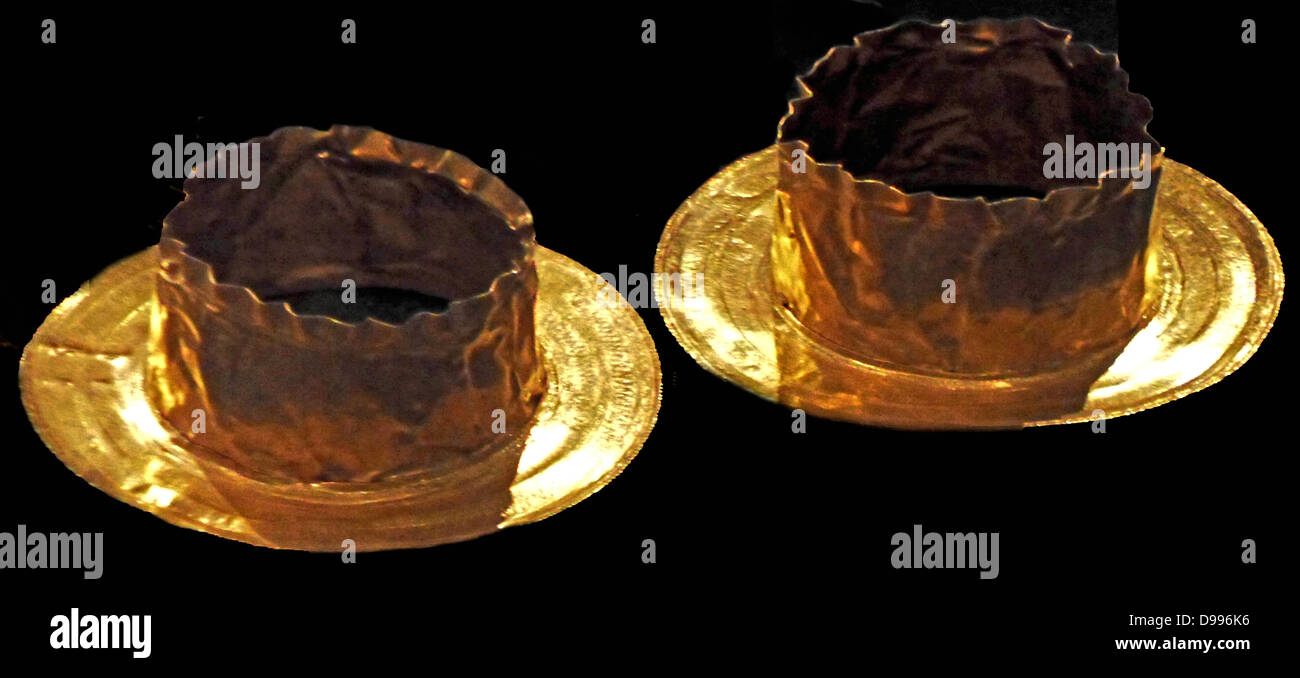 Gold hair ornaments 5th - 4th Century BC. Greek. Stock Photohttps://www.alamy.com/image-license-details/?v=1https://www.alamy.com/stock-photo-gold-hair-ornaments-5th-4th-century-bc-greek-57365818.html
Gold hair ornaments 5th - 4th Century BC. Greek. Stock Photohttps://www.alamy.com/image-license-details/?v=1https://www.alamy.com/stock-photo-gold-hair-ornaments-5th-4th-century-bc-greek-57365818.htmlRMD996K6–Gold hair ornaments 5th - 4th Century BC. Greek.
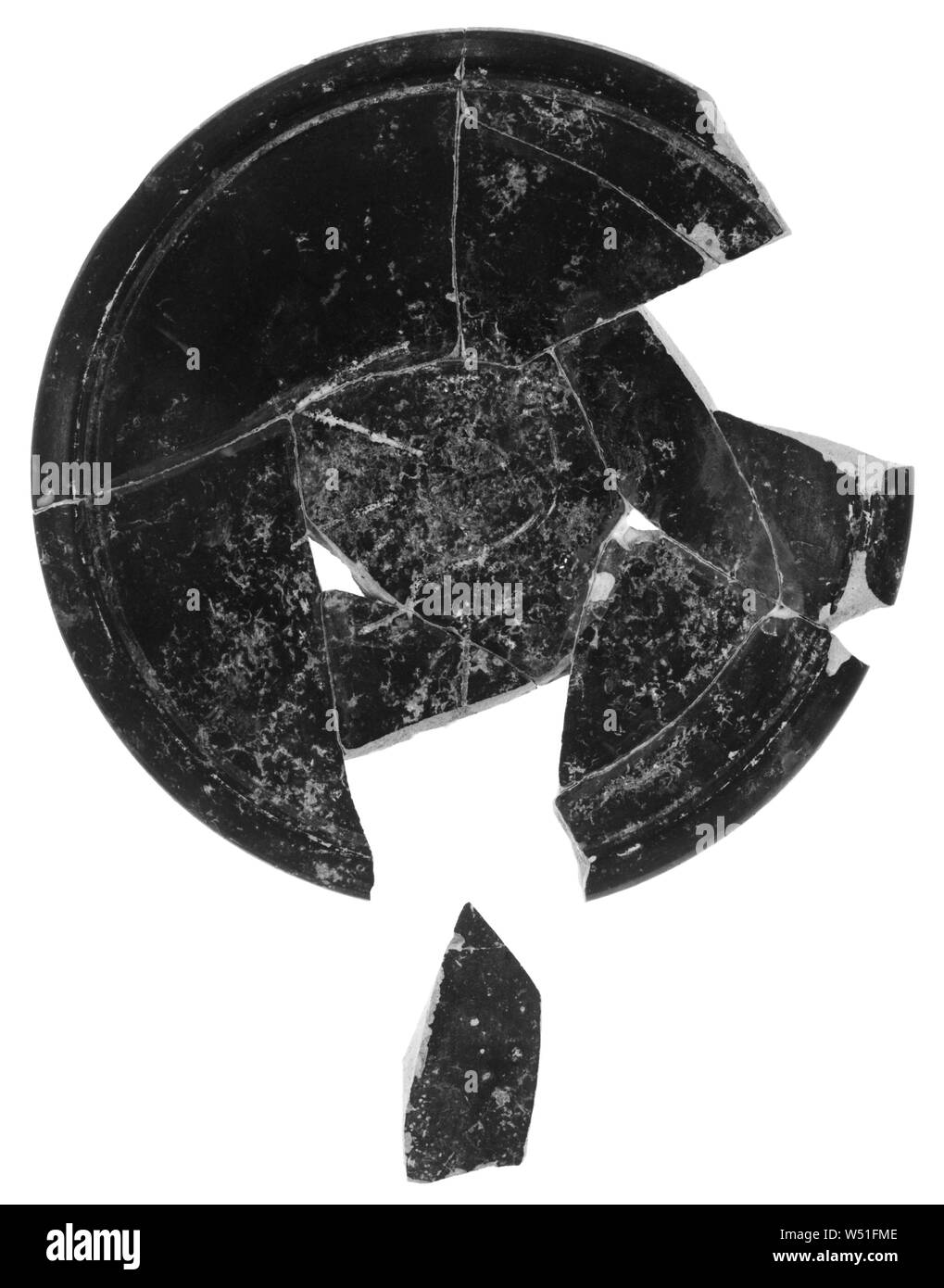 4th century B.C Stock Photohttps://www.alamy.com/image-license-details/?v=1https://www.alamy.com/4th-century-bc-image261263086.html
4th century B.C Stock Photohttps://www.alamy.com/image-license-details/?v=1https://www.alamy.com/4th-century-bc-image261263086.htmlRMW51FME–4th century B.C
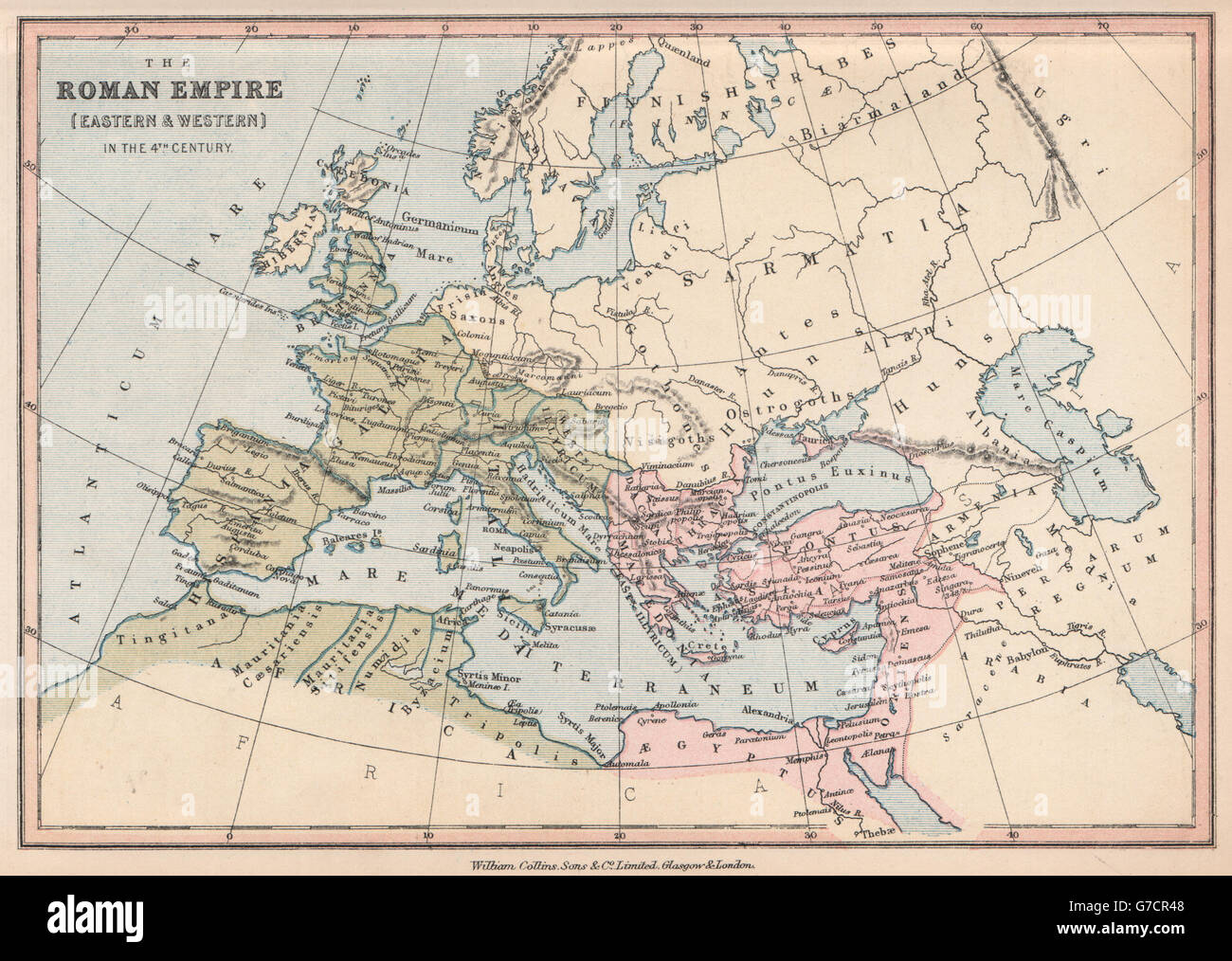 ROMAN EMPIRE. In the 4th century. Eastern & Western. BARTHOLOMEW, 1878 old map Stock Photohttps://www.alamy.com/image-license-details/?v=1https://www.alamy.com/stock-photo-roman-empire-in-the-4th-century-eastern-western-bartholomew-1878-old-107846376.html
ROMAN EMPIRE. In the 4th century. Eastern & Western. BARTHOLOMEW, 1878 old map Stock Photohttps://www.alamy.com/image-license-details/?v=1https://www.alamy.com/stock-photo-roman-empire-in-the-4th-century-eastern-western-bartholomew-1878-old-107846376.htmlRFG7CR48–ROMAN EMPIRE. In the 4th century. Eastern & Western. BARTHOLOMEW, 1878 old map
 fine arts, Egypt, shroud with portrait of a Greek woman, linen, 4th century, Metropolitan Museum of Art, ARTIST'S COPYRIGHT HAS NOT TO BE CLEARED Stock Photohttps://www.alamy.com/image-license-details/?v=1https://www.alamy.com/fine-arts-egypt-shroud-with-portrait-of-a-greek-woman-linen-4th-century-metropolitan-museum-of-art-artists-copyright-has-not-to-be-cleared-image612586292.html
fine arts, Egypt, shroud with portrait of a Greek woman, linen, 4th century, Metropolitan Museum of Art, ARTIST'S COPYRIGHT HAS NOT TO BE CLEARED Stock Photohttps://www.alamy.com/image-license-details/?v=1https://www.alamy.com/fine-arts-egypt-shroud-with-portrait-of-a-greek-woman-linen-4th-century-metropolitan-museum-of-art-artists-copyright-has-not-to-be-cleared-image612586292.htmlRM2XGHM1T–fine arts, Egypt, shroud with portrait of a Greek woman, linen, 4th century, Metropolitan Museum of Art, ARTIST'S COPYRIGHT HAS NOT TO BE CLEARED
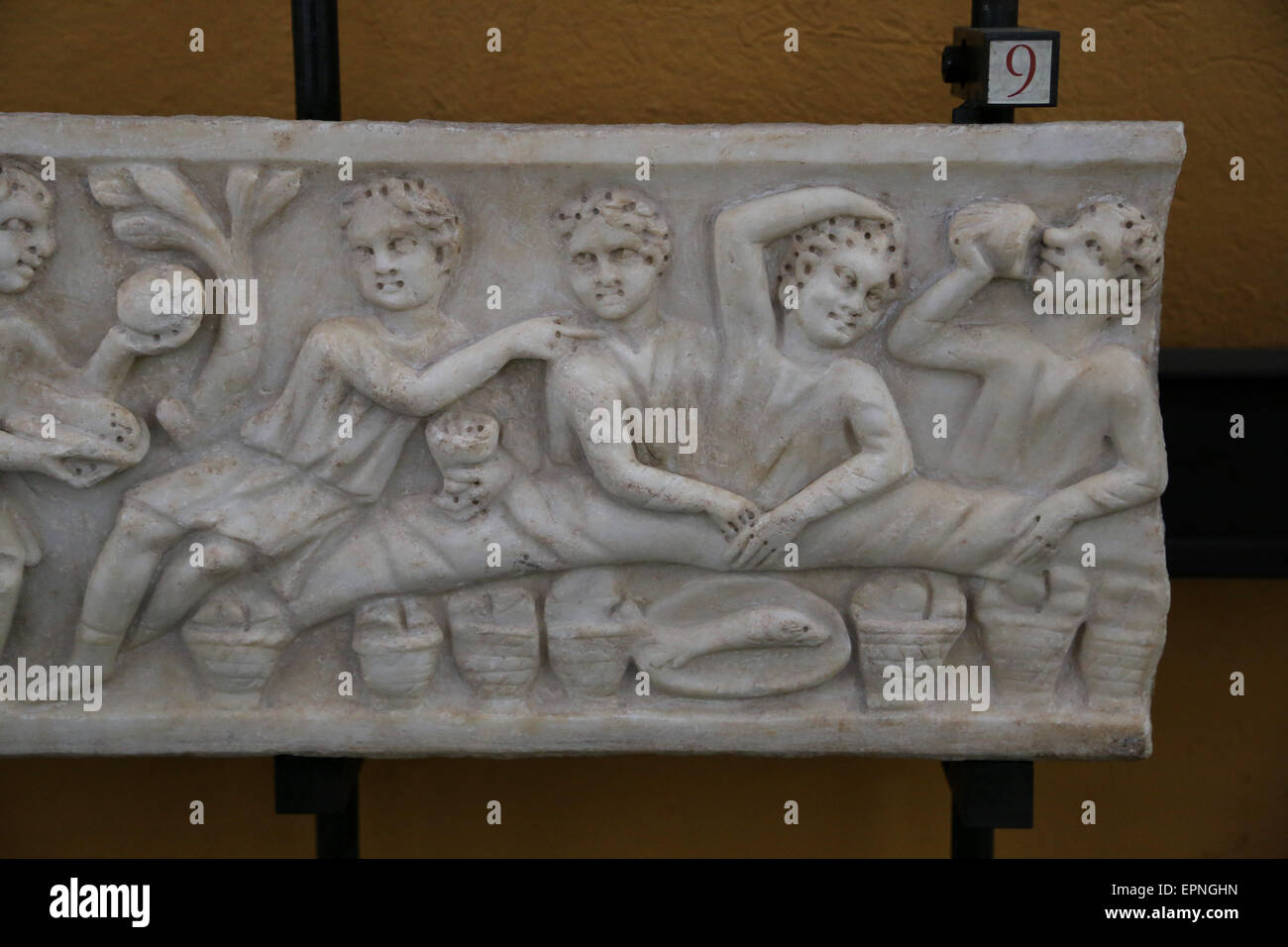 Early Christian. Roman banquet. 4th century. Relief. Vatican Museums. Vatican City State. Stock Photohttps://www.alamy.com/image-license-details/?v=1https://www.alamy.com/stock-photo-early-christian-roman-banquet-4th-century-relief-vatican-museums-vatican-82837937.html
Early Christian. Roman banquet. 4th century. Relief. Vatican Museums. Vatican City State. Stock Photohttps://www.alamy.com/image-license-details/?v=1https://www.alamy.com/stock-photo-early-christian-roman-banquet-4th-century-relief-vatican-museums-vatican-82837937.htmlRMEPNGHN–Early Christian. Roman banquet. 4th century. Relief. Vatican Museums. Vatican City State.
 Hercules at Rest - The Farnese Hercules 216 AD (4th century BC for original) National Archaeological Museum of Naples Italy. Stock Photohttps://www.alamy.com/image-license-details/?v=1https://www.alamy.com/hercules-at-rest-the-farnese-hercules-216-ad-4th-century-bc-for-original-national-archaeological-museum-of-naples-italy-image571689371.html
Hercules at Rest - The Farnese Hercules 216 AD (4th century BC for original) National Archaeological Museum of Naples Italy. Stock Photohttps://www.alamy.com/image-license-details/?v=1https://www.alamy.com/hercules-at-rest-the-farnese-hercules-216-ad-4th-century-bc-for-original-national-archaeological-museum-of-naples-italy-image571689371.htmlRM2T62KHF–Hercules at Rest - The Farnese Hercules 216 AD (4th century BC for original) National Archaeological Museum of Naples Italy.
 This photo of a mosaic showing the Great Hunt (scene of embarking) was taken in the summer of 1970 at Piazza Armerina in Sicily. Piazza Armerina is home to the Roman Villa del Casale and its famous mosaics, the 'finest mosaics in situ anywhere in the Roman world,' as described by UNESCO, which inserted it into its World Heritage list in 1997. Villa Romana was a lavish patrician residence built at the center of a huge latifundium (agricultural estate) at the end of the 4th century AD. It is thought to have belonged to a member of the Roman senatorial aristocracy, who traded in exotic animals. Stock Photohttps://www.alamy.com/image-license-details/?v=1https://www.alamy.com/this-photo-of-a-mosaic-showing-the-great-hunt-scene-of-embarking-was-taken-in-the-summer-of-1970-at-piazza-armerina-in-sicily-piazza-armerina-is-home-to-the-roman-villa-del-casale-and-its-famous-mosaics-the-finest-mosaics-in-situ-anywhere-in-the-roman-world-as-described-by-unesco-which-inserted-it-into-its-world-heritage-list-in-1997-villa-romana-was-a-lavish-patrician-residence-built-at-the-center-of-a-huge-latifundium-agricultural-estate-at-the-end-of-the-4th-century-ad-it-is-thought-to-have-belonged-to-a-member-of-the-roman-senatorial-aristocracy-who-traded-in-exotic-animals-image557837258.html
This photo of a mosaic showing the Great Hunt (scene of embarking) was taken in the summer of 1970 at Piazza Armerina in Sicily. Piazza Armerina is home to the Roman Villa del Casale and its famous mosaics, the 'finest mosaics in situ anywhere in the Roman world,' as described by UNESCO, which inserted it into its World Heritage list in 1997. Villa Romana was a lavish patrician residence built at the center of a huge latifundium (agricultural estate) at the end of the 4th century AD. It is thought to have belonged to a member of the Roman senatorial aristocracy, who traded in exotic animals. Stock Photohttps://www.alamy.com/image-license-details/?v=1https://www.alamy.com/this-photo-of-a-mosaic-showing-the-great-hunt-scene-of-embarking-was-taken-in-the-summer-of-1970-at-piazza-armerina-in-sicily-piazza-armerina-is-home-to-the-roman-villa-del-casale-and-its-famous-mosaics-the-finest-mosaics-in-situ-anywhere-in-the-roman-world-as-described-by-unesco-which-inserted-it-into-its-world-heritage-list-in-1997-villa-romana-was-a-lavish-patrician-residence-built-at-the-center-of-a-huge-latifundium-agricultural-estate-at-the-end-of-the-4th-century-ad-it-is-thought-to-have-belonged-to-a-member-of-the-roman-senatorial-aristocracy-who-traded-in-exotic-animals-image557837258.htmlRF2RBFK36–This photo of a mosaic showing the Great Hunt (scene of embarking) was taken in the summer of 1970 at Piazza Armerina in Sicily. Piazza Armerina is home to the Roman Villa del Casale and its famous mosaics, the 'finest mosaics in situ anywhere in the Roman world,' as described by UNESCO, which inserted it into its World Heritage list in 1997. Villa Romana was a lavish patrician residence built at the center of a huge latifundium (agricultural estate) at the end of the 4th century AD. It is thought to have belonged to a member of the Roman senatorial aristocracy, who traded in exotic animals.
 Epameinondas a Theban general and statesman of the 4th century BC, saves Pelopidas, an important Theban statesman and general in Greece during the Battle of Leuctra in 371 BCE. Stock Photohttps://www.alamy.com/image-license-details/?v=1https://www.alamy.com/stock-photo-epameinondas-a-theban-general-and-statesman-of-the-4th-century-bc-148188735.html
Epameinondas a Theban general and statesman of the 4th century BC, saves Pelopidas, an important Theban statesman and general in Greece during the Battle of Leuctra in 371 BCE. Stock Photohttps://www.alamy.com/image-license-details/?v=1https://www.alamy.com/stock-photo-epameinondas-a-theban-general-and-statesman-of-the-4th-century-bc-148188735.htmlRMJH2G6R–Epameinondas a Theban general and statesman of the 4th century BC, saves Pelopidas, an important Theban statesman and general in Greece during the Battle of Leuctra in 371 BCE.
 Entrance to 4th century Saint Domnius Cathedral and arches of Diocletian's Palace Peristyle, Split, Croatia Stock Photohttps://www.alamy.com/image-license-details/?v=1https://www.alamy.com/entrance-to-4th-century-saint-domnius-cathedral-and-arches-of-diocletians-palace-peristyle-split-croatia-image622800610.html
Entrance to 4th century Saint Domnius Cathedral and arches of Diocletian's Palace Peristyle, Split, Croatia Stock Photohttps://www.alamy.com/image-license-details/?v=1https://www.alamy.com/entrance-to-4th-century-saint-domnius-cathedral-and-arches-of-diocletians-palace-peristyle-split-croatia-image622800610.htmlRM2Y570EX–Entrance to 4th century Saint Domnius Cathedral and arches of Diocletian's Palace Peristyle, Split, Croatia
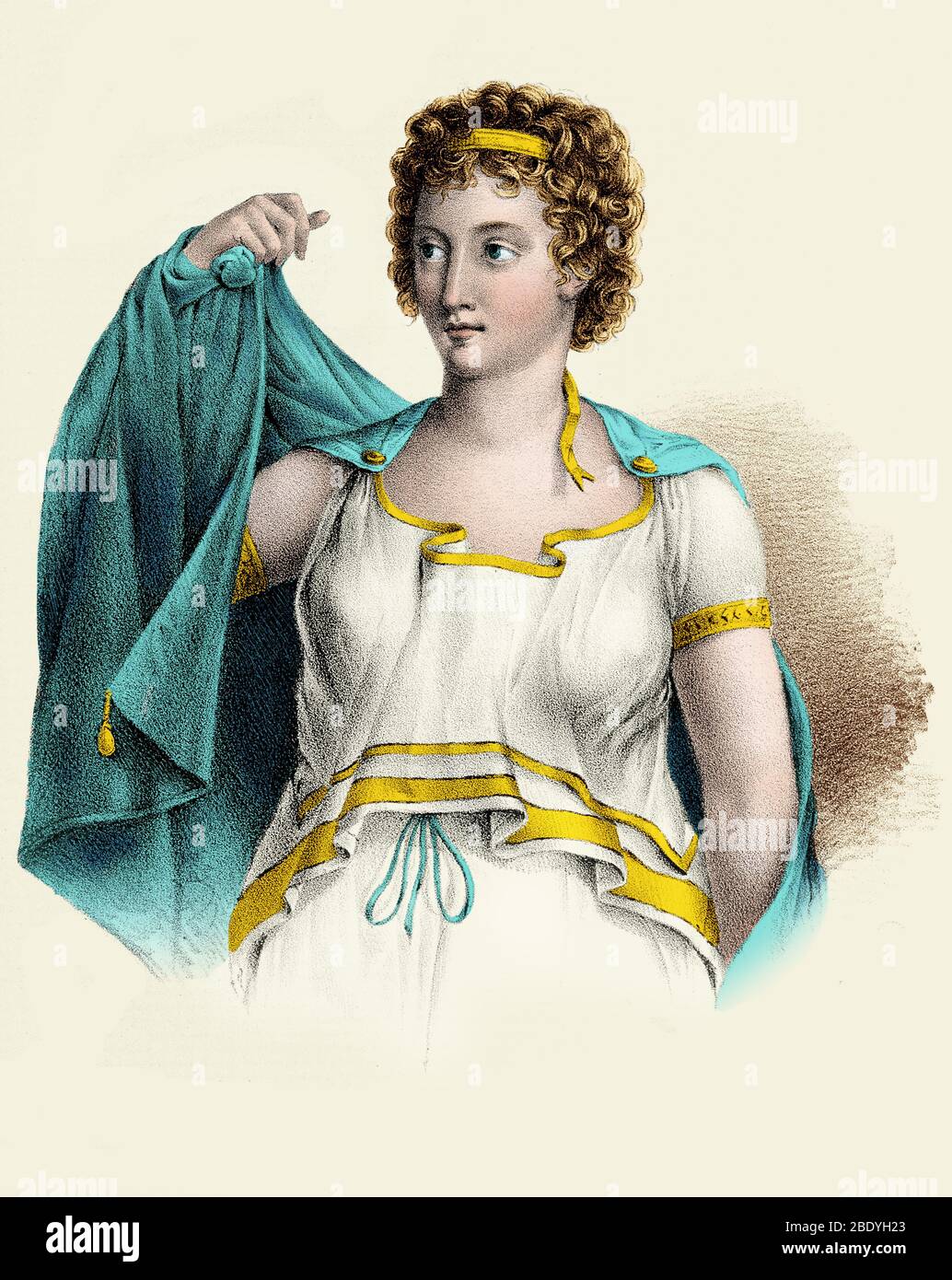 Agnodice, Ancient Greek Physician, 4th Century BC Stock Photohttps://www.alamy.com/image-license-details/?v=1https://www.alamy.com/agnodice-ancient-greek-physician-4th-century-bc-image352803979.html
Agnodice, Ancient Greek Physician, 4th Century BC Stock Photohttps://www.alamy.com/image-license-details/?v=1https://www.alamy.com/agnodice-ancient-greek-physician-4th-century-bc-image352803979.htmlRM2BDYH23–Agnodice, Ancient Greek Physician, 4th Century BC
 Ukraine: Gold image of a Scythian man, from the Scythian Treasure of Kul-Oba, near Kerch, 4th century BCE. Photo by PHGCOM (CC BY-SA 3.0 License). The Scythians were an ancient Iranian people of horse-riding nomadic pastoralists who throughout Classical Antiquity dominated the Pontic-Caspian steppe, known at the time as Scythia. By Late Antiquity the closely-related Sarmatians came to dominate the Scythians in the west. Stock Photohttps://www.alamy.com/image-license-details/?v=1https://www.alamy.com/ukraine-gold-image-of-a-scythian-man-from-the-scythian-treasure-of-kul-oba-near-kerch-4th-century-bce-photo-by-phgcom-cc-by-sa-30-license-the-scythians-were-an-ancient-iranian-people-of-horse-riding-nomadic-pastoralists-who-throughout-classical-antiquity-dominated-the-pontic-caspian-steppe-known-at-the-time-as-scythia-by-late-antiquity-the-closely-related-sarmatians-came-to-dominate-the-scythians-in-the-west-image344227716.html
Ukraine: Gold image of a Scythian man, from the Scythian Treasure of Kul-Oba, near Kerch, 4th century BCE. Photo by PHGCOM (CC BY-SA 3.0 License). The Scythians were an ancient Iranian people of horse-riding nomadic pastoralists who throughout Classical Antiquity dominated the Pontic-Caspian steppe, known at the time as Scythia. By Late Antiquity the closely-related Sarmatians came to dominate the Scythians in the west. Stock Photohttps://www.alamy.com/image-license-details/?v=1https://www.alamy.com/ukraine-gold-image-of-a-scythian-man-from-the-scythian-treasure-of-kul-oba-near-kerch-4th-century-bce-photo-by-phgcom-cc-by-sa-30-license-the-scythians-were-an-ancient-iranian-people-of-horse-riding-nomadic-pastoralists-who-throughout-classical-antiquity-dominated-the-pontic-caspian-steppe-known-at-the-time-as-scythia-by-late-antiquity-the-closely-related-sarmatians-came-to-dominate-the-scythians-in-the-west-image344227716.htmlRM2B00WY0–Ukraine: Gold image of a Scythian man, from the Scythian Treasure of Kul-Oba, near Kerch, 4th century BCE. Photo by PHGCOM (CC BY-SA 3.0 License). The Scythians were an ancient Iranian people of horse-riding nomadic pastoralists who throughout Classical Antiquity dominated the Pontic-Caspian steppe, known at the time as Scythia. By Late Antiquity the closely-related Sarmatians came to dominate the Scythians in the west.
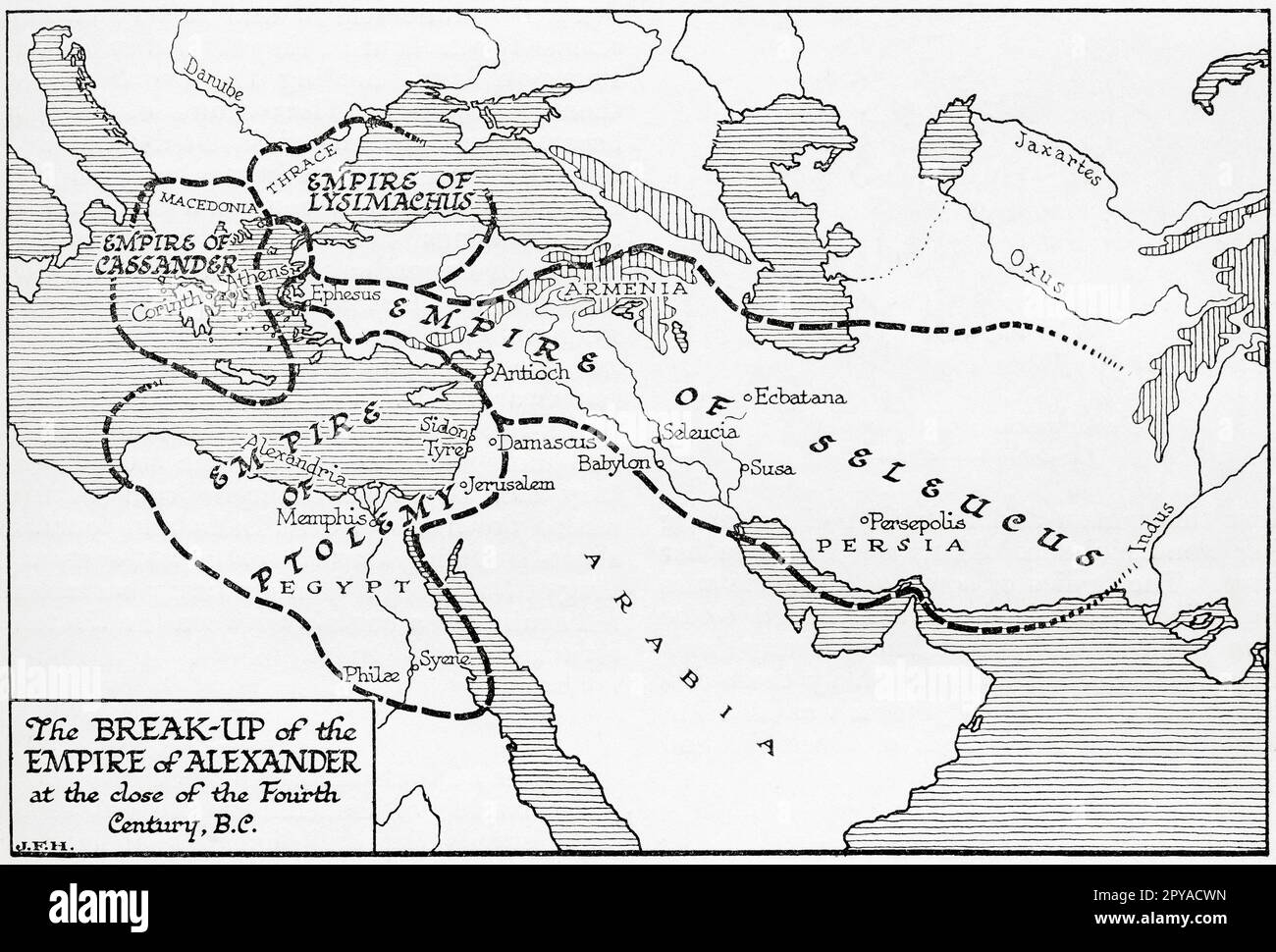 Map showing the break up of the empire of Alexander the Great at the close of the 4th century BC. From the book Outline of History by H.G. Wells, published 1920. Stock Photohttps://www.alamy.com/image-license-details/?v=1https://www.alamy.com/map-showing-the-break-up-of-the-empire-of-alexander-the-great-at-the-close-of-the-4th-century-bc-from-the-book-outline-of-history-by-hg-wells-published-1920-image550346769.html
Map showing the break up of the empire of Alexander the Great at the close of the 4th century BC. From the book Outline of History by H.G. Wells, published 1920. Stock Photohttps://www.alamy.com/image-license-details/?v=1https://www.alamy.com/map-showing-the-break-up-of-the-empire-of-alexander-the-great-at-the-close-of-the-4th-century-bc-from-the-book-outline-of-history-by-hg-wells-published-1920-image550346769.htmlRM2PYACWN–Map showing the break up of the empire of Alexander the Great at the close of the 4th century BC. From the book Outline of History by H.G. Wells, published 1920.
 The Great Dish from the Mildenhall Treasure, probably early 4th century. Diameter = 23.75 inches. Stock Photohttps://www.alamy.com/image-license-details/?v=1https://www.alamy.com/the-great-dish-from-the-mildenhall-treasure-probably-early-4th-century-diameter-=-2375-inches-image268827020.html
The Great Dish from the Mildenhall Treasure, probably early 4th century. Diameter = 23.75 inches. Stock Photohttps://www.alamy.com/image-license-details/?v=1https://www.alamy.com/the-great-dish-from-the-mildenhall-treasure-probably-early-4th-century-diameter-=-2375-inches-image268827020.htmlRMWHA3H0–The Great Dish from the Mildenhall Treasure, probably early 4th century. Diameter = 23.75 inches.
 Mausoleum of Halicarnassus. 4th century BC. Detail. Amazonomachy. Relief. Frieze running around the top of the podium. From Bodrum, Turkey. Stock Photohttps://www.alamy.com/image-license-details/?v=1https://www.alamy.com/stock-image-mausoleum-of-halicarnassus-4th-century-bc-detail-amazonomachy-relief-165641944.html
Mausoleum of Halicarnassus. 4th century BC. Detail. Amazonomachy. Relief. Frieze running around the top of the podium. From Bodrum, Turkey. Stock Photohttps://www.alamy.com/image-license-details/?v=1https://www.alamy.com/stock-image-mausoleum-of-halicarnassus-4th-century-bc-detail-amazonomachy-relief-165641944.htmlRMKHDHYM–Mausoleum of Halicarnassus. 4th century BC. Detail. Amazonomachy. Relief. Frieze running around the top of the podium. From Bodrum, Turkey.
 Historical depiction of St Syrus, Bishop of Genoa and the Basilisk, 4th century, Old Town, Genoa, Italy Stock Photohttps://www.alamy.com/image-license-details/?v=1https://www.alamy.com/historical-depiction-of-st-syrus-bishop-of-genoa-and-the-basilisk-4th-century-old-town-genoa-italy-image593923501.html
Historical depiction of St Syrus, Bishop of Genoa and the Basilisk, 4th century, Old Town, Genoa, Italy Stock Photohttps://www.alamy.com/image-license-details/?v=1https://www.alamy.com/historical-depiction-of-st-syrus-bishop-of-genoa-and-the-basilisk-4th-century-old-town-genoa-italy-image593923501.htmlRF2WE7FDH–Historical depiction of St Syrus, Bishop of Genoa and the Basilisk, 4th century, Old Town, Genoa, Italy
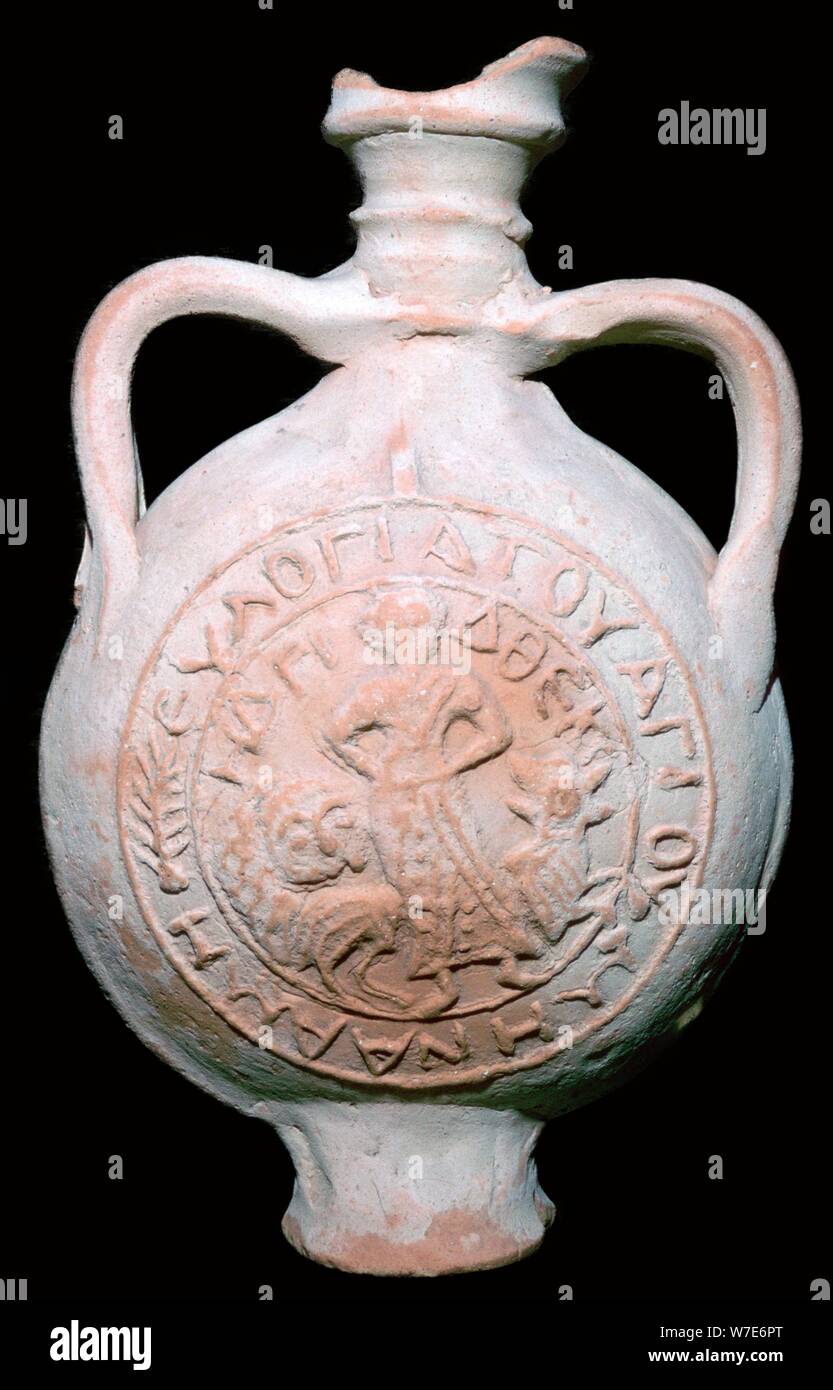 Coptic Pilgrim Flask, 4th-5th century. Artist: Unknown Stock Photohttps://www.alamy.com/image-license-details/?v=1https://www.alamy.com/coptic-pilgrim-flask-4th-5th-century-artist-unknown-image262770784.html
Coptic Pilgrim Flask, 4th-5th century. Artist: Unknown Stock Photohttps://www.alamy.com/image-license-details/?v=1https://www.alamy.com/coptic-pilgrim-flask-4th-5th-century-artist-unknown-image262770784.htmlRMW7E6PT–Coptic Pilgrim Flask, 4th-5th century. Artist: Unknown
 Albania, Ballsh, ruins of the Illyrian city of Byllis, 4th century BC, The Cathedral Stock Photohttps://www.alamy.com/image-license-details/?v=1https://www.alamy.com/albania-ballsh-ruins-of-the-illyrian-city-of-byllis-4th-century-bc-the-cathedral-image259640970.html
Albania, Ballsh, ruins of the Illyrian city of Byllis, 4th century BC, The Cathedral Stock Photohttps://www.alamy.com/image-license-details/?v=1https://www.alamy.com/albania-ballsh-ruins-of-the-illyrian-city-of-byllis-4th-century-bc-the-cathedral-image259640970.htmlRMW2BJKP–Albania, Ballsh, ruins of the Illyrian city of Byllis, 4th century BC, The Cathedral
 Thessaloniki - The 4th century Triumphal Arch of Galerius Stock Photohttps://www.alamy.com/image-license-details/?v=1https://www.alamy.com/stock-photo-thessaloniki-the-4th-century-triumphal-arch-of-galerius-105372861.html
Thessaloniki - The 4th century Triumphal Arch of Galerius Stock Photohttps://www.alamy.com/image-license-details/?v=1https://www.alamy.com/stock-photo-thessaloniki-the-4th-century-triumphal-arch-of-galerius-105372861.htmlRMG3C44D–Thessaloniki - The 4th century Triumphal Arch of Galerius
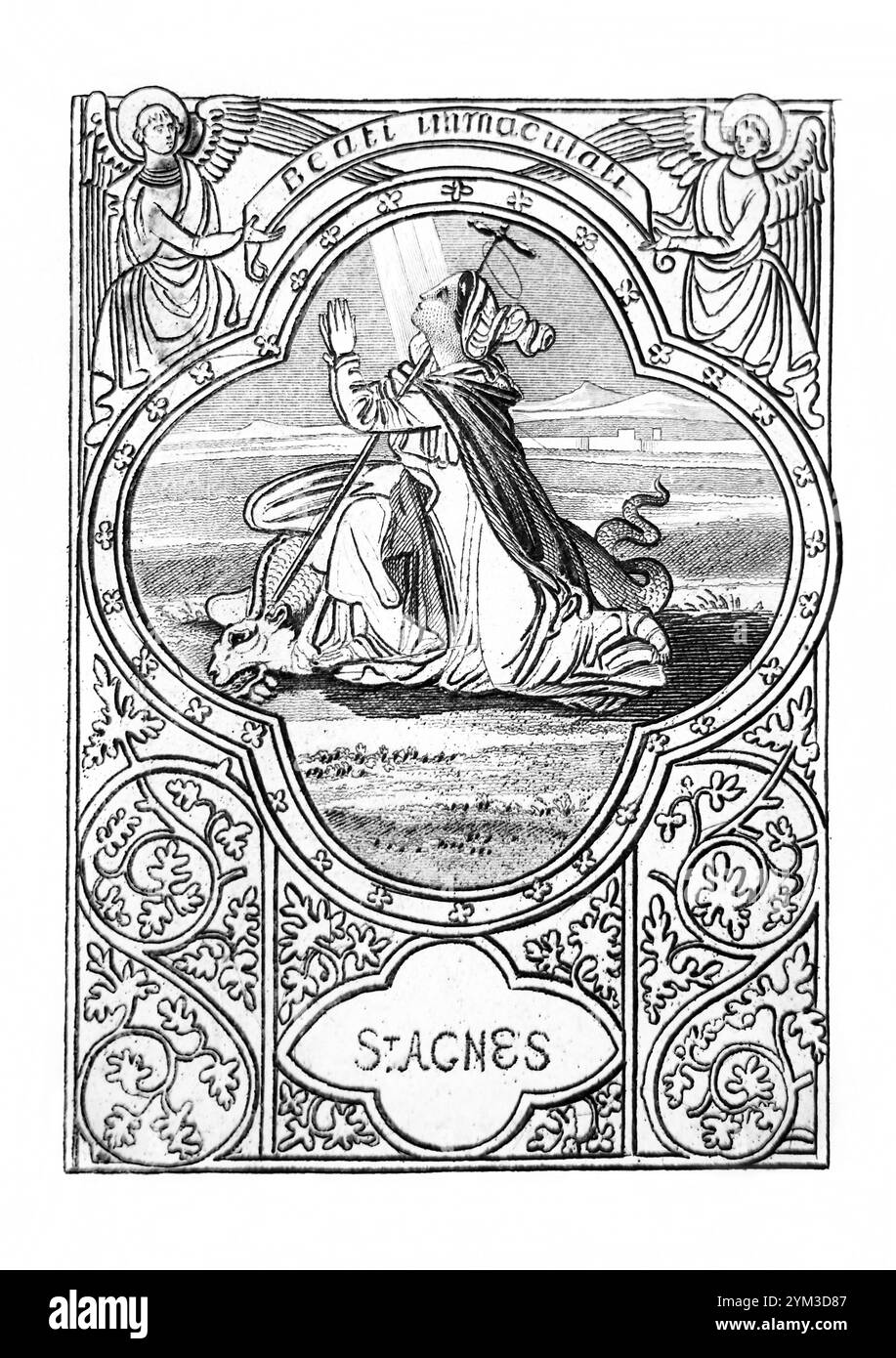 Black and White Illustration of Saint Agnes a 4th Century Virgin Martyr Patron Saint of Girls from Antique book the Lives of the Fathers, Martyrs and Stock Photohttps://www.alamy.com/image-license-details/?v=1https://www.alamy.com/black-and-white-illustration-of-saint-agnes-a-4th-century-virgin-martyr-patron-saint-of-girls-from-antique-book-the-lives-of-the-fathers-martyrs-and-image631942647.html
Black and White Illustration of Saint Agnes a 4th Century Virgin Martyr Patron Saint of Girls from Antique book the Lives of the Fathers, Martyrs and Stock Photohttps://www.alamy.com/image-license-details/?v=1https://www.alamy.com/black-and-white-illustration-of-saint-agnes-a-4th-century-virgin-martyr-patron-saint-of-girls-from-antique-book-the-lives-of-the-fathers-martyrs-and-image631942647.htmlRM2YM3D87–Black and White Illustration of Saint Agnes a 4th Century Virgin Martyr Patron Saint of Girls from Antique book the Lives of the Fathers, Martyrs and
 Fresco 'The Hunt'. Tomb from the Goguryeo period (4th century). Korea Stock Photohttps://www.alamy.com/image-license-details/?v=1https://www.alamy.com/fresco-the-hunt-tomb-from-the-goguryeo-period-4th-century-korea-image481942280.html
Fresco 'The Hunt'. Tomb from the Goguryeo period (4th century). Korea Stock Photohttps://www.alamy.com/image-license-details/?v=1https://www.alamy.com/fresco-the-hunt-tomb-from-the-goguryeo-period-4th-century-korea-image481942280.htmlRM2K02A88–Fresco 'The Hunt'. Tomb from the Goguryeo period (4th century). Korea
 Bracelet, Unknown, Egypt, 4th century, Ivory Stock Photohttps://www.alamy.com/image-license-details/?v=1https://www.alamy.com/bracelet-unknown-egypt-4th-century-ivory-image261266631.html
Bracelet, Unknown, Egypt, 4th century, Ivory Stock Photohttps://www.alamy.com/image-license-details/?v=1https://www.alamy.com/bracelet-unknown-egypt-4th-century-ivory-image261266631.htmlRMW51M73–Bracelet, Unknown, Egypt, 4th century, Ivory
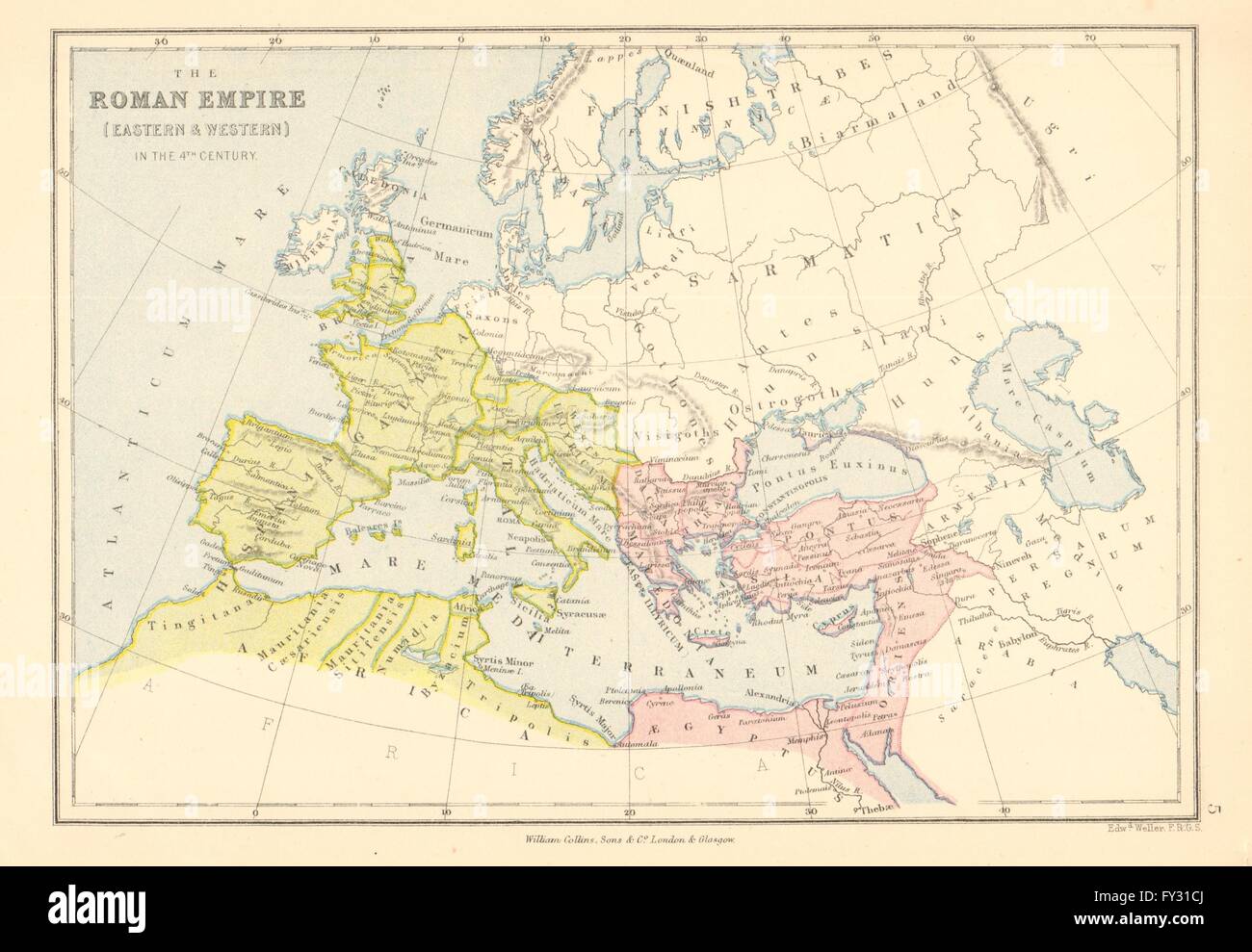 ROMAN EMPIRE. In the 4th century. Eastern & Western. BARTHOLOMEW, 1876 old map Stock Photohttps://www.alamy.com/image-license-details/?v=1https://www.alamy.com/stock-photo-roman-empire-in-the-4th-century-eastern-western-bartholomew-1876-old-102714546.html
ROMAN EMPIRE. In the 4th century. Eastern & Western. BARTHOLOMEW, 1876 old map Stock Photohttps://www.alamy.com/image-license-details/?v=1https://www.alamy.com/stock-photo-roman-empire-in-the-4th-century-eastern-western-bartholomew-1876-old-102714546.htmlRFFY31CJ–ROMAN EMPIRE. In the 4th century. Eastern & Western. BARTHOLOMEW, 1876 old map
 fine arts, Egypt, sculpture, Horus boy, 4th century, limestone, State Collection of Egyptian Arts, ARTIST'S COPYRIGHT HAS NOT TO BE CLEARED Stock Photohttps://www.alamy.com/image-license-details/?v=1https://www.alamy.com/fine-arts-egypt-sculpture-horus-boy-4th-century-limestone-state-collection-of-egyptian-arts-artists-copyright-has-not-to-be-cleared-image612586384.html
fine arts, Egypt, sculpture, Horus boy, 4th century, limestone, State Collection of Egyptian Arts, ARTIST'S COPYRIGHT HAS NOT TO BE CLEARED Stock Photohttps://www.alamy.com/image-license-details/?v=1https://www.alamy.com/fine-arts-egypt-sculpture-horus-boy-4th-century-limestone-state-collection-of-egyptian-arts-artists-copyright-has-not-to-be-cleared-image612586384.htmlRM2XGHM54–fine arts, Egypt, sculpture, Horus boy, 4th century, limestone, State Collection of Egyptian Arts, ARTIST'S COPYRIGHT HAS NOT TO BE CLEARED
 Sarpophagus of marble fragments. Philosopher's scene. Late 3rd-early 4th century. Elche, Alicante. Spain. Stock Photohttps://www.alamy.com/image-license-details/?v=1https://www.alamy.com/stock-photo-sarpophagus-of-marble-fragments-philosophers-scene-late-3rd-early-134296021.html
Sarpophagus of marble fragments. Philosopher's scene. Late 3rd-early 4th century. Elche, Alicante. Spain. Stock Photohttps://www.alamy.com/image-license-details/?v=1https://www.alamy.com/stock-photo-sarpophagus-of-marble-fragments-philosophers-scene-late-3rd-early-134296021.htmlRMHPDKXD–Sarpophagus of marble fragments. Philosopher's scene. Late 3rd-early 4th century. Elche, Alicante. Spain.
 Hercules at Rest - The Farnese Hercules 216 AD (4th century BC for original) National Archaeological Museum of Naples Italy. Stock Photohttps://www.alamy.com/image-license-details/?v=1https://www.alamy.com/hercules-at-rest-the-farnese-hercules-216-ad-4th-century-bc-for-original-national-archaeological-museum-of-naples-italy-image571689374.html
Hercules at Rest - The Farnese Hercules 216 AD (4th century BC for original) National Archaeological Museum of Naples Italy. Stock Photohttps://www.alamy.com/image-license-details/?v=1https://www.alamy.com/hercules-at-rest-the-farnese-hercules-216-ad-4th-century-bc-for-original-national-archaeological-museum-of-naples-italy-image571689374.htmlRM2T62KHJ–Hercules at Rest - The Farnese Hercules 216 AD (4th century BC for original) National Archaeological Museum of Naples Italy.
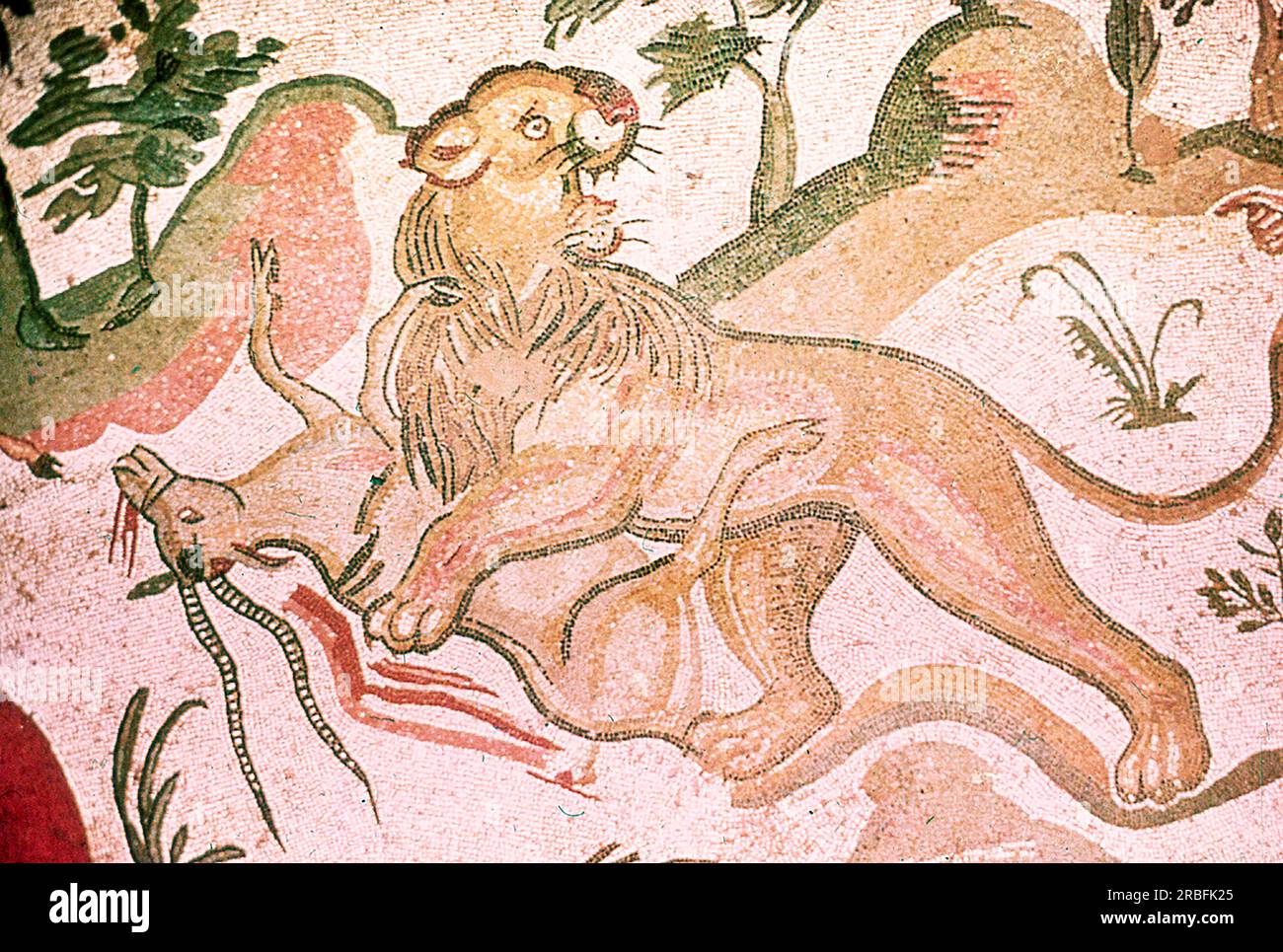 This photo of a mosaic showing a hunting scene (a lion taking down a horned animal) was taken in the summer of 1970 at Piazza Armerina in Sicily. Piazza Armerina is home to the Roman Villa del Casale and its famous mosaics, the 'finest mosaics in situ anywhere in the Roman world,' as described by UNESCO, which inserted it into its World Heritage list in 1997. Villa Romana was a lavish patrician residence built at the center of a huge latifundium (agricultural estate) at the end of the 4th century AD. It is thought to have belonged to a member of the Roman senatorial aristocracy, who traded in Stock Photohttps://www.alamy.com/image-license-details/?v=1https://www.alamy.com/this-photo-of-a-mosaic-showing-a-hunting-scene-a-lion-taking-down-a-horned-animal-was-taken-in-the-summer-of-1970-at-piazza-armerina-in-sicily-piazza-armerina-is-home-to-the-roman-villa-del-casale-and-its-famous-mosaics-the-finest-mosaics-in-situ-anywhere-in-the-roman-world-as-described-by-unesco-which-inserted-it-into-its-world-heritage-list-in-1997-villa-romana-was-a-lavish-patrician-residence-built-at-the-center-of-a-huge-latifundium-agricultural-estate-at-the-end-of-the-4th-century-ad-it-is-thought-to-have-belonged-to-a-member-of-the-roman-senatorial-aristocracy-who-traded-in-image557837229.html
This photo of a mosaic showing a hunting scene (a lion taking down a horned animal) was taken in the summer of 1970 at Piazza Armerina in Sicily. Piazza Armerina is home to the Roman Villa del Casale and its famous mosaics, the 'finest mosaics in situ anywhere in the Roman world,' as described by UNESCO, which inserted it into its World Heritage list in 1997. Villa Romana was a lavish patrician residence built at the center of a huge latifundium (agricultural estate) at the end of the 4th century AD. It is thought to have belonged to a member of the Roman senatorial aristocracy, who traded in Stock Photohttps://www.alamy.com/image-license-details/?v=1https://www.alamy.com/this-photo-of-a-mosaic-showing-a-hunting-scene-a-lion-taking-down-a-horned-animal-was-taken-in-the-summer-of-1970-at-piazza-armerina-in-sicily-piazza-armerina-is-home-to-the-roman-villa-del-casale-and-its-famous-mosaics-the-finest-mosaics-in-situ-anywhere-in-the-roman-world-as-described-by-unesco-which-inserted-it-into-its-world-heritage-list-in-1997-villa-romana-was-a-lavish-patrician-residence-built-at-the-center-of-a-huge-latifundium-agricultural-estate-at-the-end-of-the-4th-century-ad-it-is-thought-to-have-belonged-to-a-member-of-the-roman-senatorial-aristocracy-who-traded-in-image557837229.htmlRF2RBFK25–This photo of a mosaic showing a hunting scene (a lion taking down a horned animal) was taken in the summer of 1970 at Piazza Armerina in Sicily. Piazza Armerina is home to the Roman Villa del Casale and its famous mosaics, the 'finest mosaics in situ anywhere in the Roman world,' as described by UNESCO, which inserted it into its World Heritage list in 1997. Villa Romana was a lavish patrician residence built at the center of a huge latifundium (agricultural estate) at the end of the 4th century AD. It is thought to have belonged to a member of the Roman senatorial aristocracy, who traded in
 1870: A member of the clergy passing the Shrine of St Alban, a site of national Pilgrimage to which people have been visiting for over 1700 years. He is venerated as the first-recorded British Christian martyr. He is traditionally believed to have been beheaded in the Roman city of Verulamium (modern St Albans) sometime during the 3rd or 4th century, and his cult has been celebrated there since ancient times.Hertfordshire, England Stock Photohttps://www.alamy.com/image-license-details/?v=1https://www.alamy.com/1870-a-member-of-the-clergy-passing-the-shrine-of-st-alban-a-site-image152908963.html
1870: A member of the clergy passing the Shrine of St Alban, a site of national Pilgrimage to which people have been visiting for over 1700 years. He is venerated as the first-recorded British Christian martyr. He is traditionally believed to have been beheaded in the Roman city of Verulamium (modern St Albans) sometime during the 3rd or 4th century, and his cult has been celebrated there since ancient times.Hertfordshire, England Stock Photohttps://www.alamy.com/image-license-details/?v=1https://www.alamy.com/1870-a-member-of-the-clergy-passing-the-shrine-of-st-alban-a-site-image152908963.htmlRMJTNGXB–1870: A member of the clergy passing the Shrine of St Alban, a site of national Pilgrimage to which people have been visiting for over 1700 years. He is venerated as the first-recorded British Christian martyr. He is traditionally believed to have been beheaded in the Roman city of Verulamium (modern St Albans) sometime during the 3rd or 4th century, and his cult has been celebrated there since ancient times.Hertfordshire, England
 Entrance to 4th century Saint Domnius Cathedral and arches of Diocletian's Palace Peristyle, Split, Croatia Stock Photohttps://www.alamy.com/image-license-details/?v=1https://www.alamy.com/entrance-to-4th-century-saint-domnius-cathedral-and-arches-of-diocletians-palace-peristyle-split-croatia-image621802924.html
Entrance to 4th century Saint Domnius Cathedral and arches of Diocletian's Palace Peristyle, Split, Croatia Stock Photohttps://www.alamy.com/image-license-details/?v=1https://www.alamy.com/entrance-to-4th-century-saint-domnius-cathedral-and-arches-of-diocletians-palace-peristyle-split-croatia-image621802924.htmlRM2Y3HFY8–Entrance to 4th century Saint Domnius Cathedral and arches of Diocletian's Palace Peristyle, Split, Croatia
 Bikini Girls,4th Century Stock Photohttps://www.alamy.com/image-license-details/?v=1https://www.alamy.com/bikini-girls4th-century-image151886762.html
Bikini Girls,4th Century Stock Photohttps://www.alamy.com/image-license-details/?v=1https://www.alamy.com/bikini-girls4th-century-image151886762.htmlRMJR3136–Bikini Girls,4th Century
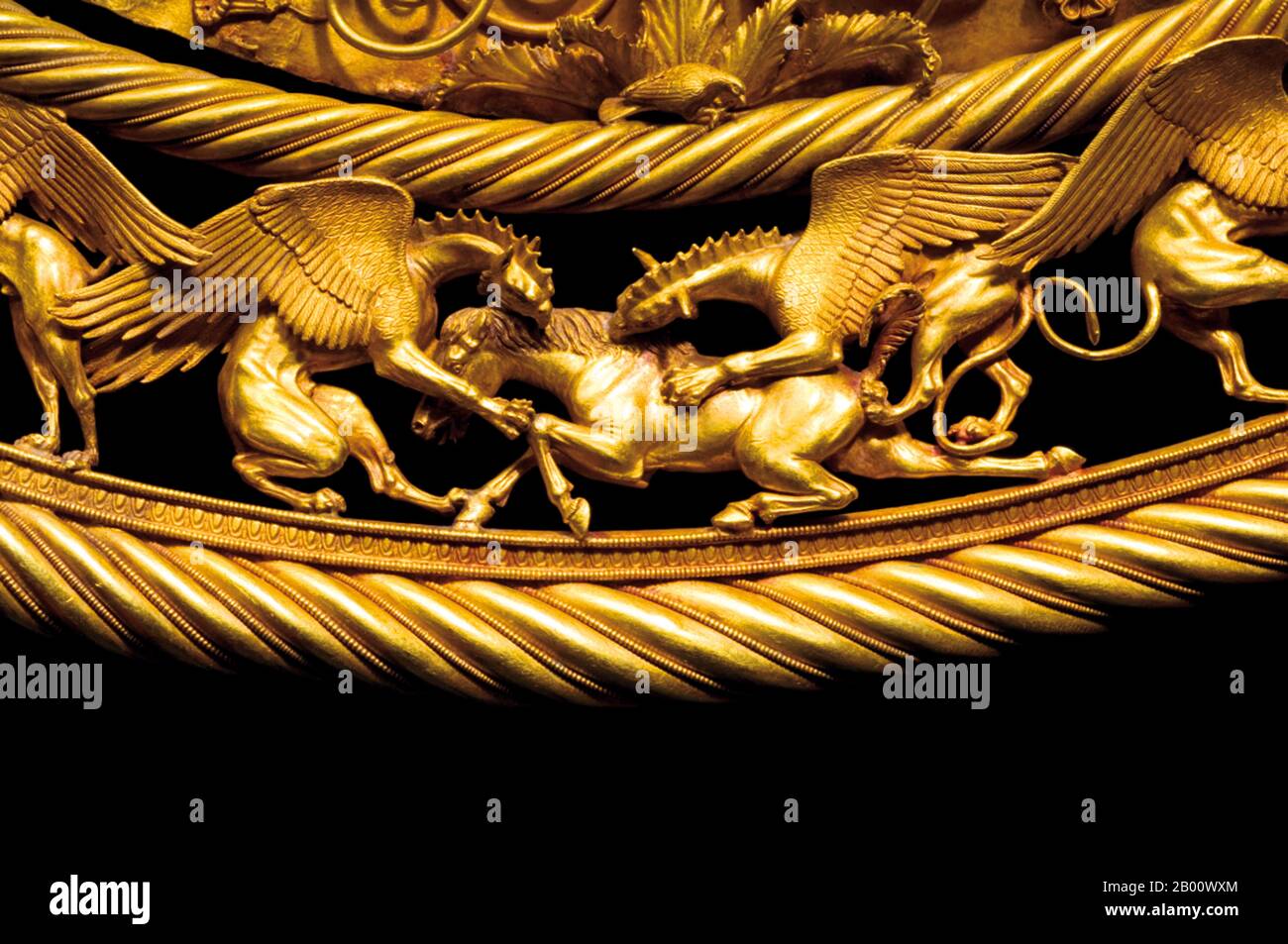 Ukraine: Detail from a golden Scythian pectoral from the royal grave in the Tolstaja Mogila Kurgan, middle of 4th century BCE. Museum of Historical Treasures of Ukraine, Kiev. Image released to the press in 2009. The Scythians were an ancient Iranian people of horse-riding nomadic pastoralists who throughout Classical Antiquity dominated the Pontic-Caspian steppe, known at the time as Scythia. By Late Antiquity the closely-related Sarmatians came to dominate the Scythians in the west. Stock Photohttps://www.alamy.com/image-license-details/?v=1https://www.alamy.com/ukraine-detail-from-a-golden-scythian-pectoral-from-the-royal-grave-in-the-tolstaja-mogila-kurgan-middle-of-4th-century-bce-museum-of-historical-treasures-of-ukraine-kiev-image-released-to-the-press-in-2009-the-scythians-were-an-ancient-iranian-people-of-horse-riding-nomadic-pastoralists-who-throughout-classical-antiquity-dominated-the-pontic-caspian-steppe-known-at-the-time-as-scythia-by-late-antiquity-the-closely-related-sarmatians-came-to-dominate-the-scythians-in-the-west-image344227708.html
Ukraine: Detail from a golden Scythian pectoral from the royal grave in the Tolstaja Mogila Kurgan, middle of 4th century BCE. Museum of Historical Treasures of Ukraine, Kiev. Image released to the press in 2009. The Scythians were an ancient Iranian people of horse-riding nomadic pastoralists who throughout Classical Antiquity dominated the Pontic-Caspian steppe, known at the time as Scythia. By Late Antiquity the closely-related Sarmatians came to dominate the Scythians in the west. Stock Photohttps://www.alamy.com/image-license-details/?v=1https://www.alamy.com/ukraine-detail-from-a-golden-scythian-pectoral-from-the-royal-grave-in-the-tolstaja-mogila-kurgan-middle-of-4th-century-bce-museum-of-historical-treasures-of-ukraine-kiev-image-released-to-the-press-in-2009-the-scythians-were-an-ancient-iranian-people-of-horse-riding-nomadic-pastoralists-who-throughout-classical-antiquity-dominated-the-pontic-caspian-steppe-known-at-the-time-as-scythia-by-late-antiquity-the-closely-related-sarmatians-came-to-dominate-the-scythians-in-the-west-image344227708.htmlRM2B00WXM–Ukraine: Detail from a golden Scythian pectoral from the royal grave in the Tolstaja Mogila Kurgan, middle of 4th century BCE. Museum of Historical Treasures of Ukraine, Kiev. Image released to the press in 2009. The Scythians were an ancient Iranian people of horse-riding nomadic pastoralists who throughout Classical Antiquity dominated the Pontic-Caspian steppe, known at the time as Scythia. By Late Antiquity the closely-related Sarmatians came to dominate the Scythians in the west.
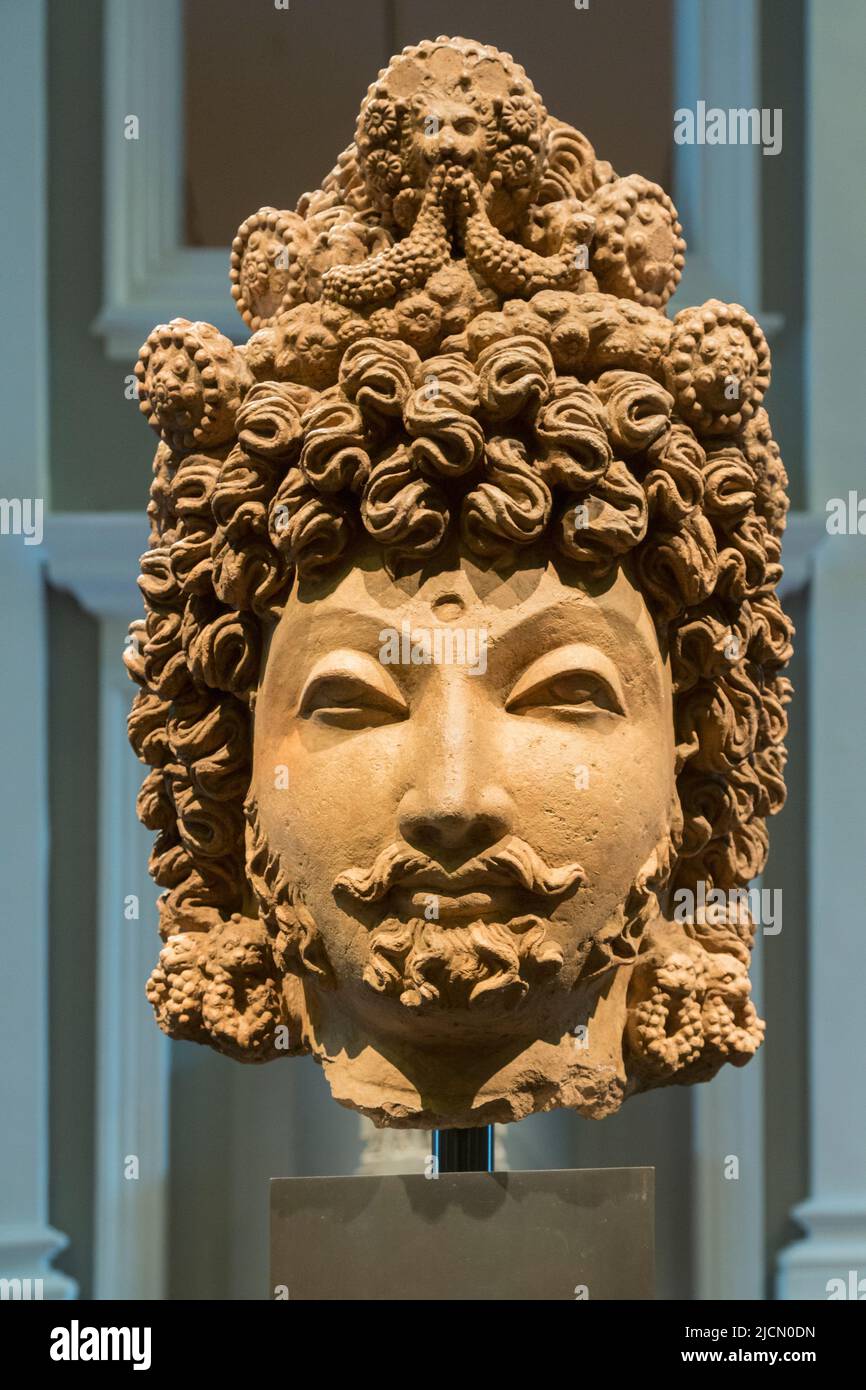 Terracotta head of a Bodhisattva made around the 4th century in Gandhara (present day Pakistan and Afghanistan). Asian Civilisations Museum, Republic Stock Photohttps://www.alamy.com/image-license-details/?v=1https://www.alamy.com/terracotta-head-of-a-bodhisattva-made-around-the-4th-century-in-gandhara-present-day-pakistan-and-afghanistan-asian-civilisations-museum-republic-image472517185.html
Terracotta head of a Bodhisattva made around the 4th century in Gandhara (present day Pakistan and Afghanistan). Asian Civilisations Museum, Republic Stock Photohttps://www.alamy.com/image-license-details/?v=1https://www.alamy.com/terracotta-head-of-a-bodhisattva-made-around-the-4th-century-in-gandhara-present-day-pakistan-and-afghanistan-asian-civilisations-museum-republic-image472517185.htmlRM2JCN0DN–Terracotta head of a Bodhisattva made around the 4th century in Gandhara (present day Pakistan and Afghanistan). Asian Civilisations Museum, Republic
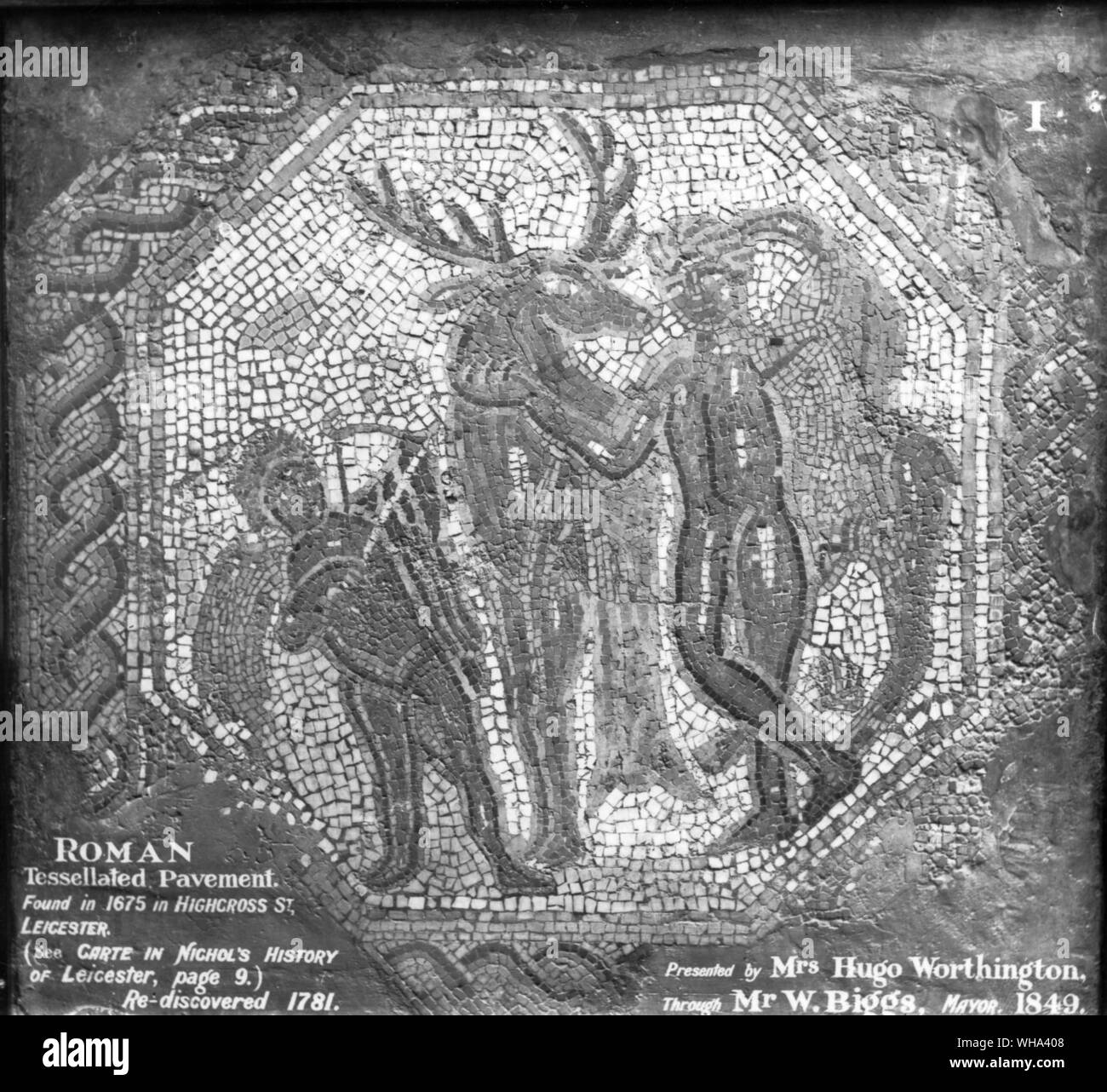 Mosaic of Cyparissus and his stag. 4th century Stock Photohttps://www.alamy.com/image-license-details/?v=1https://www.alamy.com/mosaic-of-cyparissus-and-his-stag-4th-century-image268827336.html
Mosaic of Cyparissus and his stag. 4th century Stock Photohttps://www.alamy.com/image-license-details/?v=1https://www.alamy.com/mosaic-of-cyparissus-and-his-stag-4th-century-image268827336.htmlRMWHA408–Mosaic of Cyparissus and his stag. 4th century
 Opus Sectile from the Domus of Porta Marina. 4th century AD. Rome. National Museum of the Early Middle Ages. Rome. Italy. Stock Photohttps://www.alamy.com/image-license-details/?v=1https://www.alamy.com/opus-sectile-from-the-domus-of-porta-marina-4th-century-ad-rome-national-image158107467.html
Opus Sectile from the Domus of Porta Marina. 4th century AD. Rome. National Museum of the Early Middle Ages. Rome. Italy. Stock Photohttps://www.alamy.com/image-license-details/?v=1https://www.alamy.com/opus-sectile-from-the-domus-of-porta-marina-4th-century-ad-rome-national-image158107467.htmlRMK56BK7–Opus Sectile from the Domus of Porta Marina. 4th century AD. Rome. National Museum of the Early Middle Ages. Rome. Italy.